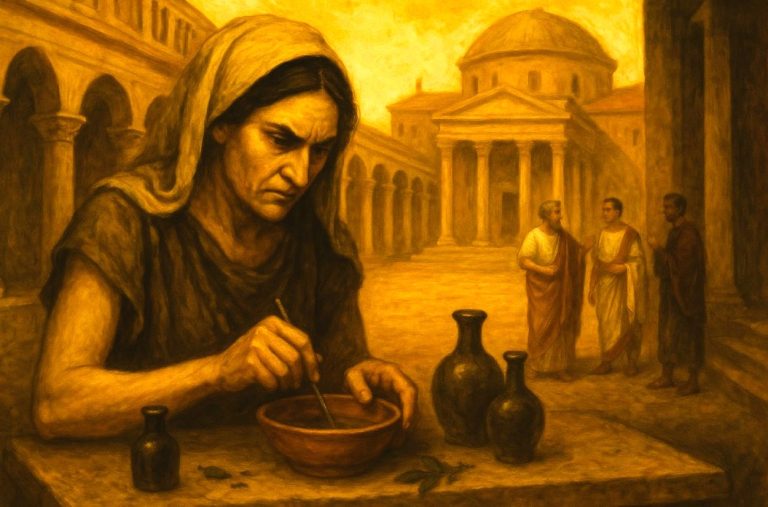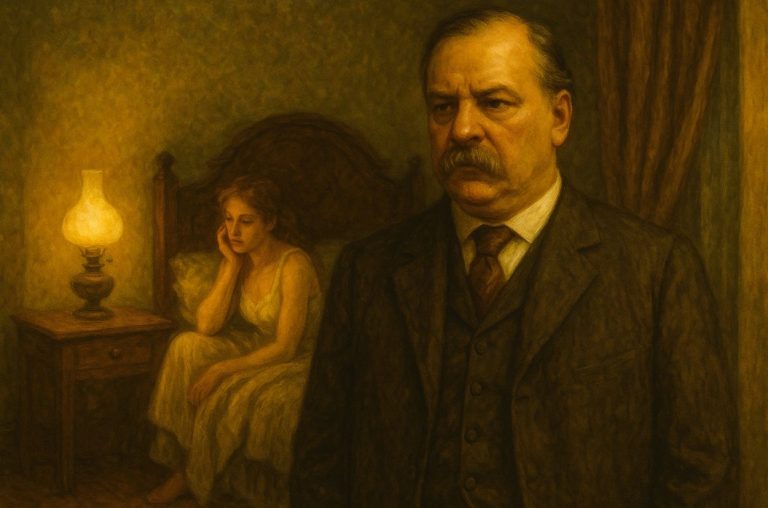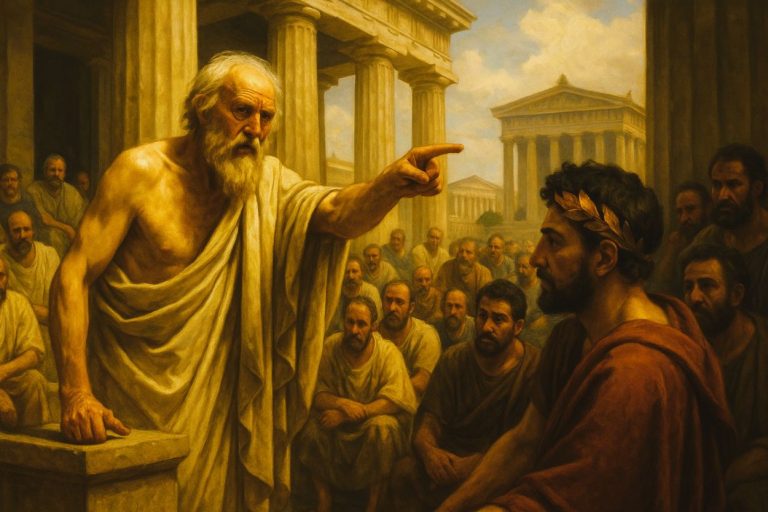
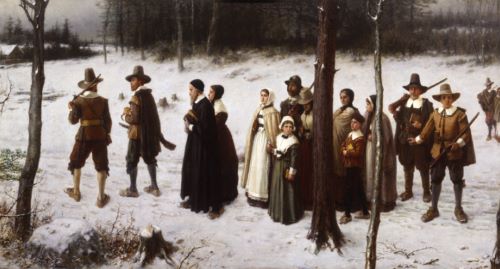
There is no other word in English as effectively dismissive as “puritan.”
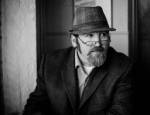
Curated/Reviewed by Matthew A. McIntosh
Public Historian
Brewminate
Introduction
American history is filled with stories of religiously minded people who have attempted to live their values in community with others. Some of these groups have been motivated to change the larger society, while others have focused their efforts on their own communities. This collection explores the contours and legacies of some of the nation’s most prominent religious movements.
Colonial New England
One Manner of Law
The religious origins of American liberalism.

After years of reading about the American Puritans, then reading the Puritans themselves, I am now convinced that our history could undergo a scrupulous reappraisal that would cause us to consider things in a radically new light. My work brought me to the subject obliquely, first through an attempt to contextualize the burst of very great literature that came out of New England in the nineteenth century, then through an attempt to understand the audience for whom Shakespeare wrote, those crowds of “groundlings” who have provided employment for legions of professors and journal editors by standing through performances of Hamlet and Lear.
In both cases the context can be called Puritanism—in Massachusetts, for obvious reasons; in prerevolutionary London, because the great political and religious controversies of the time played out in the sermons and pamphlets of dissenters and non-conformists, delivered to whomever could be reached in an increasingly literate public. Shakespeare’s histories dramatized Edward Hall, Raphael Holinshed, John Foxe, and other writers who addressed popular interest in the dynastic wars that lay behind the Tudor and Stuart regimes. I would be happy to defend the thesis that, in his treatment of this disastrous period, Shakespeare posed the crucial question of whether hereditary monarchy can produce legitimate government or fit and capable rulers. His conclusion, I would argue, is that it cannot. The crisis that England was approaching had everything to do with the legitimacy of monarchy itself. Persecutions under Mary I had sent dissenters to Geneva, where hereditary rulers had been expelled and the city governed as a republic since 1541. The Dutch had defeated Philip II and formed a republic in 1581, with the help of Englishmen who were sympathetic with the Dutch as fellow Calvinists.
This is all well known to students of the Reformation. Nevertheless, that nautical England, already strenuously involved in world affairs, would have no awareness of events on the continent, and of the ideas behind these events, is an assumption common to many interpretations of Elizabethan writers. It is nonsense to suggest, as some experts have, that Shakespeare could think only in terms of hierarchies and chains of being. But history has become so segmented that the English Renaissance and Reformation are treated as discrete phenomena, though they were perfectly simultaneous, and many writers and political figures important to both.
READ ENTIRE ARTICLE AT HARPER’S MAGAZINE
Pranksters and Puritans
Why Thomas Morton seems to have taken particular delight in driving the Pilgrims and Puritans out of their minds.
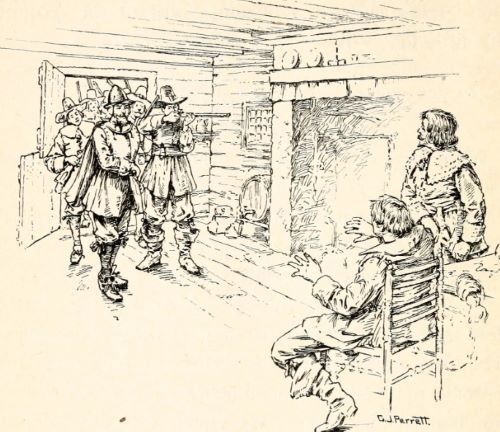
Missing from the traditional Thanksgiving narrative—the brutal winter followed by the bountiful harvest—is the horrific epidemic that raged through the Native American community during the three years immediately preceding the 1620 arrival of the Mayflower. Rat feces on boot soles are believed to have carried lethal bacteria from European ships anchored along the New England coastline to Native villages. Whatever the precise nature of the disease, it worked with ruthless efficiency during the years 1616 to 1619. “The pace of death must have been terrifying,” Peter Mancall writes in The Trials of Thomas Morton, his book about a little-known chapter in the European settling of New England. “Most epidemics, even of highly contagious diseases like the plague, typically leave survivors. But this series of infections apparently killed almost everyone.” The Pilgrims regarded the “wonderfull Plague,” which decimated the Native farmers but left their cleared fields, as one more God-given thing to be thankful for.
Natives spared by the disease suffered another disaster in 1637, in what came to be known as the Pequot War but was more accurately a massacre. Colonists seized on various pretexts to slaughter 1,500 Natives in two months, including women and children in a village on the Mystic River that they deliberately torched. “It was a fearful sight to see them thus frying in the fire,” the Pilgrim leader William Bradford wrote of the atrocity, “and the streams of blood quenching the same.” Again, Bradford thanked a providential God for aiding his men, “thus to enclose their enemies in their hands and give them so speedy a victory over so proud and insulting an enemy.”
But there were other challenges to the Pilgrims’ fragile utopian experiment, and to the more worldly and successful Puritan colony of Massachusetts Bay, founded in 1630, that eventually absorbed it. This threat arose from fellow Englishmen, many of whom regarded the Pilgrims, with their astringent separatist views that had taken them first to Holland and then to New England, and the more moderate Puritans, who wished to reform the abuses of the Anglican Church, with distaste.
READ ENTIRE ARTICLE AT THE NEW YORK REVIEW
When Perry Miller Invented America
In a covenantal nation like the United States, words are the very ligaments that hold the body together, and what words we choose become everything.
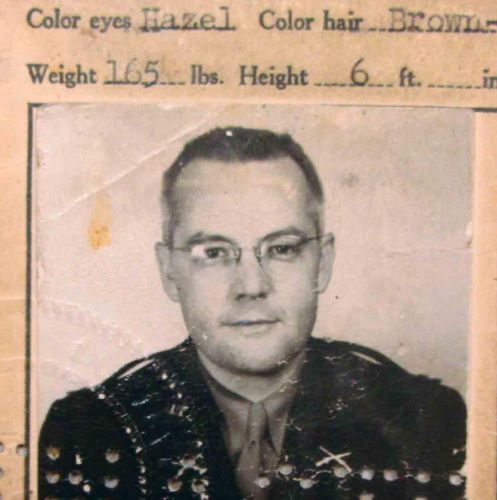
I have now looked seriously at America from both sides, West and East, and wish to Hell this country could say what, in the realm of ideas, it means commensurate with its force.
Perry Miller in letter, September 14, 1952
Several days after the Allied invasion at Normandy, a Harvard historian and agent in the US Office of Strategic Services named Perry Miller went to survey the debris spread across those beaches that bore good American code names like “Omaha” and “Utah,” beaches where 10,000 troops had died. A gentle summer breeze rolled in, and Miller espied that fathomless line dotted with amphibious LCVPs, jeeps, and tanks. Along the shoals were thousands of waterlogged corpses, the ocean tide still dyed pink. He wrote home and described a dead man “looking terribly young, crunched into the side of the road, his hand clutching a grenade which he had not had time to cock, his rifle lying across his chest and on the butt of it, pasted on with adhesive tape, a picture of his girl — young and fresh and smiling.”
Miller was only 39, but some of the dead at Normandy were undoubtedly around the age of his students. At the time that he’d enlisted, Miller was already the author of two well-received monographs — Orthodoxy in Massachusetts, 1630–1650 (1933) and The New England Mind: The Seventeenth Century (1939). The latter would become a classic of American studies, the first of several by Miller. I wonder if, on that beach, he didn’t ruminate on a reverse expedition that had departed just across the channel some 314 years earlier when the Arbella set sail for Boston, and onboard, the first governor of Massachusetts, John Winthrop, apocryphally sermonized that the Puritans must “make other’s conditions our own […] always having before our eyes our commission and community in the work.”
As World War II entered its final stage, the professor understood the United States to be in a battle between two civilizations. America and Nazi Germany each represented irreconcilable understandings, with both claiming an exceptionalism that deigned to speak for humanity. Hitler’s cankered vision was to be contrasted with Winthrop’s declaration in his 1630 lay sermon A Modell of Christian Charity, which claimed that we must “rejoice together, mourne together, labour and suffer together.” With the success of D-Day, Miller and others could already see that a coming conflict lay further to the east, so that Winthrop would soon have to figuratively challenge Stalin as he had Hitler. “Winthrop opened the story of America,” writes Abram C. Van Engen in his engaging new book City on a Hill: A History of American Exceptionalism, describing that contemporary myth which holds that the Puritan “called on us to serve as a beacon of liberty, chosen by God to spread the benefits of self-government, toleration, and free enterprise to the entire watching world.” In that fight, men like Miller were invaluable, for he and other scholars distilled an understanding of the United States’ history that none other than Stalin termed “American exceptionalism.” Much of the work that Miller did with the OSS, the administrative precursor to the Central Intelligence Agency, remains classified. It’s known, however, that he helped establish its psychological warfare division.
READ ENTIRE ARTICLE AT LOS ANGELES REVIEW OF BOOKS
What Liberty Meant to the Pilgrims
Most adult men could aspire to participation in the religious and political government of the colony. But this communal liberty did not imply personal liberty.
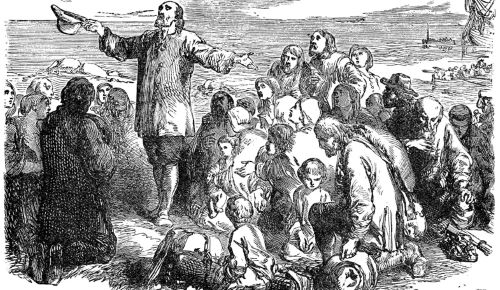
Superpowers need origin stories — nations no less than comic-book heroes. The Pilgrims are ours. Forget the fortune-hunters of Jamestown; the tale of doughty settlers seeking religious liberty and overcoming hardship to establish the self-governing Plymouth Colony is the origin story we want. As John Turner observes in his excellent new history of the colony, “by the early nineteenth century, the Pilgrims had become symbols of republicanism, democracy, and religious toleration.” The Pilgrims are part of our national pantheon and its narrative of America as a nation devoted to liberty.
Revisionist historians have assailed this mythos, arguing that the Pilgrims were not trying to beat a thoroughfare of freedom across the wilderness. Rather, they accepted slavery and refused to extend religious liberty to others. Despite the iconic day of thanksgiving providing a “heartwarming story of two peoples feasting together instead of fighting each other,” Pilgrim settlers often wronged the natives. Furthermore, Plymouth was soon overshadowed by the establishment of the Massachusetts Bay Colony. By this reckoning, the Pilgrims were historically negligible and morally unworthy of our admiration — their significance derives from our printing their legend rather than the facts.
Turner’s book, They Knew They Were Pilgrims, alternately affirms and challenges both the popular mythos and its critics. Beginning with the separatist movement in England and continuing until Plymouth was incorporated into Massachusetts in 1691, Turner provides an engaging account of the Pilgrims, from Calvinist theology to colonial politics. While validating some criticisms, he asserts that the Pilgrims matter for more than their legend, and he deftly uses the history of Plymouth to explore ideas of liberty in the American colonies.
READ ENTIRE ARTICLE AT NATIONAL REVIEW
How America’s First Banned Book Survived and Became an Anti-Authoritarian Icon
The Puritans outlawed Thomas Morton’s “New English Canaan” because it was critical of the society they were building in colonial New England.
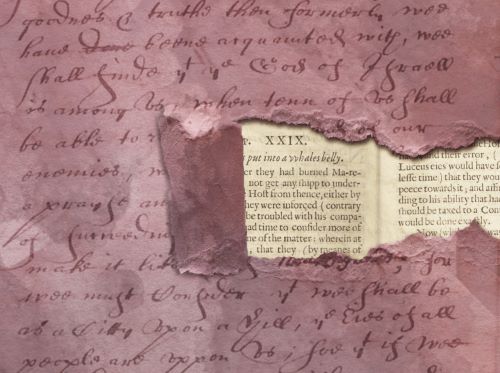
When the Puritans set sail for New England in 1630, they likened themselves to ancient Israelites settling in the promised land. Liberated from the Church of England, which they viewed as too Catholic, they sought to reform the church and establish a new Christian commonwealth guided by their covenant with God.
“We must consider that we shall be as a city upon a hill,” John Winthrop, governor of the Massachusetts Bay Colony, famously proclaimed on the journey over from England. “The eyes of all people are upon us, so that if we shall deal falsely with our God in this work we have undertaken and so cause him to withdraw his present help from us, we shall be made a story and a byword through the world.”
Just seven years after the Puritans’ arrival, an Anglican lawyer named Thomas Morton published a book that threatened the young colony and its residents’ covenant with God. New English Canaan, a three-part text published in Amsterdam in 1637, is mostly filled with detailed observations about the region’s Indigenous people and descriptions of plants, animals and natural resources that could be commodified by white settlers. But a brief section at the end offers a withering critique of the Puritans and the society they were building, including their treatment of Native Americans.
Members of the Massachusetts Bay Colony—known to be a tightly controlled society—adhered to strict beliefs about how to live and worship. Women and children were taught to read so they could learn directly from the Bible, but few other books were imported. Public entertainment wasn’t allowed except for church services. Cursing was punishable by law. Despite harsh winters and conflicts with Native Americans, the Puritans believed their colony would survive if they obeyed God, and they were constantly on the lookout for signs from above.
READ ENTIRE ARTICLE AT SMITHSONIAN MAGAZINE
Puritanism as a State of Mind
Whatever the “City on a Hill” is, the phrase was not discovered by Kennedy or Reagan.
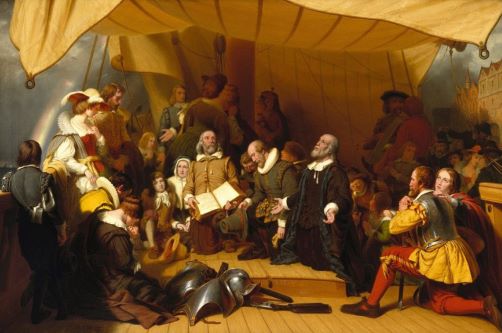
Recent generations of Americans have become accustomed to hearing their country referred to as a “City on a Hill,” a phrase which usually means that it is, or can be, a moral exemplar. In a 1961 address to the General Court of Massachusetts, President Kennedy introduced contemporary political discourse to the phrase from Jesus’s Sermon on the Mount (Matthew 5:14). Google’s Ngram Viewer demonstrates the proliferation of the phrase after President Reagan famously used it on the eve of his election in 1980 and then closed out his two-term presidency with it in 1989. President Barack Obama deployed the phrase, as have many other politicians in both major parties.
Our recent national self-examination, however, suggests that the top of the hill has become more of an ambition than an accomplishment. Poet Laureate Amanda Gorman’s dynamic “The Hill We Climb,” for example, read at the inauguration of President Biden, articulated America’s moral challenges and returned instead to a more aspirational verse in American political theology: Micah 4:4, the hope that everyone may someday “sit under their own vine and fig tree, and no one shall make them afraid.”
Whatever the “City on a Hill” is, the phrase was not discovered by Kennedy or Reagan, of course. They deployed this scripture not only for its own sake, but to recall its historical use in a sermon by John Winthrop. Winthrop, the first governor of the Massachusetts Bay Colony, supposedly delivered the sermon aboard the Arabella just before the Puritan arrival in 1630. The sermon, and its role in American politics, has been the subject of three revisionist studies. In 2012, Hillsdale historian Richard Gamble questioned America’s “redeemer myth” and cautioned against enthusiastic civil religion. In 2018, Princeton historian Daniel Rodgers likewise challenged the invention of “historical myth” and recounted Americans’ wrestling with existential questions of destiny and morality. Winthrop’s sermon, A Model of Christian Charity, gained interest not just because of its historicity, but as an occasion to ask questions about the nation itself.
READ ENTIRE ARTICLE AT LAW & LIBERTY
“City on a Hill” and the Making of an American Origin Story
A now-famous Puritan sermon was nothing special in its own day.
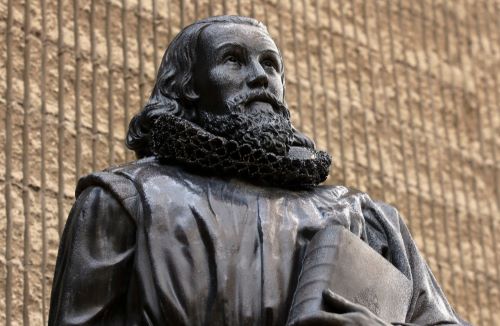
What is the origin of America?
Ask that question systematically to more than 2,000 people, and a wide variety of answers will arise. Most focus on the founding era of the United States: the Declaration of Independence, the American Revolution, and the Constitution. Others turn to the colonial days observing that “America” existed long before the nation began. Some dwell on the Native Americans—the first people on the soil of the Americas. Others focus more on the arrival of Europeans. Amerigo Vespucci gets mentioned. The coming of Columbus. Jamestown, Captain Smith, Pocahontas. So many possible answers, so many different times and places to begin. And always, in the midst of these responses, one answer rises among the rest: Pilgrim Landing, Plymouth Rock, and the Puritans.
The question of American origins, of course, has no real answer. People can argue for their choice, but such debates tell us more about how they view America today than how “America” actually began. In that sense, historical origin stories function primarily as present-day descriptions. Each answer defines what a person means by America. Beginning with Native Americans, for example, suggests a story of chronological priority untethered to modern political boundaries: “America” is all the territory from the Bering Strait to the bottom of Argentina, and it includes all the people who have ever lived and moved and had their being on these lands. It is a long story, a tale teeming with diversity. Rather than beginning something new, Europeans stumble onto well-established nations and civilizations, disrupting traditional patterns and forms of life, adding to the mix, changing and reshaping an “America” that existed long before them.
Answers that emphasize the Revolutionary era, meanwhile, define America much more narrowly. Such responses focus on one particular nation coming into being at one particular time. Even here, however, the distinctions can be quite telling. Does “America” start with a fundamental statement of principles (the Declaration of Independence), a bloody war (the American Revolution), or the eventual establishment of a mostly stable government (the Constitution)? No doubt, most people see these answers as related, but the specific responses embed much different accounts of what makes America America after all.
READ ENTIRE ARTICLE AT RELIGION & POLITICS
Thank the Pilgrims for America’s Tradition of Separatism, Division, and Infighting
They were not the nation’s first settlers, but they were the most fractious.
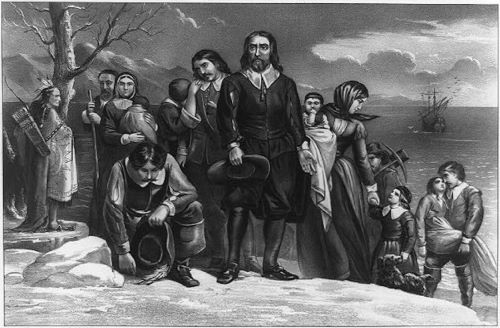
December marks the 400th anniversary of the Pilgrims’ landing at Plymouth, the moment habitually yet mistakenly thought of as the beginning of America. The conflation of New England’s history with that of the nation at large, encouraged by generations of Harvard-reared scholars, continues to warp Americans’ understanding of their past. By the time the Mayflower dropped anchor off Cape Cod, the Jamestown settlement in Virginia had survived (barely) for more than a decade, while Spanish settlements at Santa Fe, New Mexico, and St. Augustine, Florida, were far older.
In part, the importance of the Pilgrims has been exaggerated because of the peculiarly American values that they are said to have brought to the New World and spread through the colonies: rigid discipline, austere rejection of earthly pleasures, the fusing of religious impulses with political ideas. All of these indeed distinguished the Pilgrims from other groups of early trans-Atlantic migrants, though the old easy binary between profit-seeking Virginians and pious Yankees no longer commands much respect among scholars.
Yet it is another attribute of the Pilgrim influence that arguably holds even greater sway four centuries after their arrival. Understanding that influence starts with the history of their name. The Pilgrims weren’t called that in their day. Instead, they were known as “Separatists,” for their desire to break completely from the Church of England, rather than cleanse and reform it from within—the approach urged by the more moderate Puritans.
That separatist impulse to leave an established community in protest of its corruption, to choose the remedy of “exit” rather than “voice,” would set the pattern for countless American protest movements to come. The Pilgrims, by word and deed, established separation as an actionable precedent for any American group alienated from the status quo. From colonial times to the present—especially in the Revolution and the Civil War—that secessionist impulse would define American history, and sometimes threaten to overturn it entirely.
READ ENTIRE ARTICLE AT ZÓCALO PUBLIC SQUARE
Lord of Misrule: Thomas Morton’s American Subversions
When we think of early New England, we picture stern-faced Puritans. But in the same decade that they arrived, Morton founded a very different kind of colony.
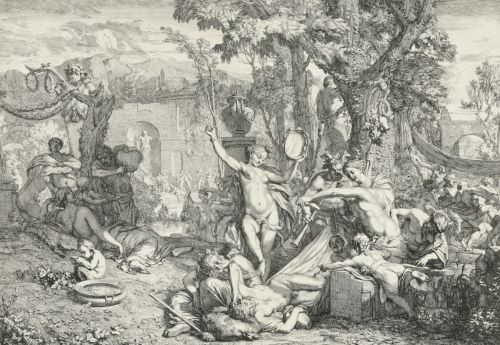
In 1620 the Mayflower shepherded in the founders of Plymouth Plantation, and in 1630 the Arbela brought John Winthrop with his sermons about the “city on a hill”, but during the decade that separates these canonical arrivals a very different sort of English colonist would establish a very different sort of colony on the South Shore of Massachusetts. Merrymount — founded as Mount Wollaston in 1624 near present-day Quincy, Massachusetts — was the brainchild of the Devonshire-born lawyer, raconteur, libertine, rake, and crypto-pagan Thomas Morton (1579–1647). His ideas for colonizing the New World were distinct from either the Plymouth or the Massachusetts Bay Colony. While generations of historians have claimed that Americans are intellectually the descendants of stern Calvinist Puritans and Pilgrims, Morton (who stood in opposition to both groups) had his own ideas. The utopian Merrymount, it has long been argued, was a society built upon privileging art and poetry over industriousness and labor, and pursued a policy of intercultural harmony rather than white supremacy. The site where it stood — now an industrial area across the road from a Dunkin’ Donuts — once bore witness to a strange and beautiful alternative dream of what America could have been.
Morton had first arrived in Massachusetts in 1622, only two years after the Mayflower had made its landing, but he returned to England after expressing dissatisfaction with Puritan governance. A year later he returned and helped to establish a colony with his associate Captain Richard Wollaston, a notorious pirate and distinctly un-Puritan figure who named the settlement after himself. Mount Wollaston would come to an end shortly after its founding, when Morton discovered to his horror that the titular leader of the colony was selling its settlers into Virginian slavery. As a result, at some point in 1626, he encouraged an uprising against Wollaston, and upon the captain’s exile Morton became the new leader, renaming the colony variously “Mount Ma-Re” or “Merrymount”, a play on the Latin for sea, the Mother of God, and an emotion not associated with the Puritans — joy.
As Morton recounts, it was decided to mark, on May 1, 1627, this new naming of the colony with a party of “Revels and merriment after the old English custome”. For the occasion Morton set up a gigantic maypole, a “goodly pine tree of eighty feet long . . . with a pair of buck’s horns nailed on somewhat near unto the top of it, where it stood as a fair sea mark for directions on how to find the way”. Settlers and local Massachusett alike were encouraged to join in the revelry for which there was “brewed a barrell of excellent beare and provided a case of bottles, to be spent, with other good cheare, for all commers of that day.” Such mixing with Native Americans and drunken carousing around a maypole, with its pagan associations, was a direct affront to Morton’s Puritan neighbours. A repeat celebration the following year, after a further twelve months of Merrymount subverting Puritan norms, saw the Plymouth commander Myles Standish (a short man later slurred by Morton as “Captain Shrimp”) march a garrison into the idolatrous settlement, cut down the maypole, and have Morton sent off back to England in fetters.
READ ENTIRE ARTICLE AT THE PUBLIC DOMAIN REVIEW
The Pilgrims’ Attack on a May Day Celebration Was a Dress Rehearsal for Removing Native Americans
The Puritans had little tolerance for those who didn’t conform to their vision of the world.
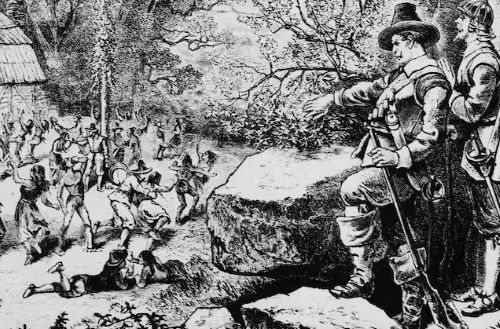
Ever since the ancient Romans decided to honor the agricultural goddess Flora with lewd spectacles in the Circus Maximus, the beginning of May has signaled the coming of spring, a time of revival after a long, dark winter.
In Europe, the holiday – usually celebrated on May 1 – became known as May Day. Though traditions varied by country and culture, celebrants often erected maypoles and decorated them with long colorful ribbons. Townspeople, while indulging in food and drink, would frolic for hours. These rituals continue today in parks and on college campuses across the U.S. and Europe.
Throughout history, millions have embraced the holiday – except for the Puritans of early modern England. Though we tend to lump them together, the term “Puritans” included different groups of religious dissenters. Among them were the Pilgrims, who eventually decided to migrate to North America to create new communities according to their religious vision.
It is tempting to attribute the Pilgrims’ hostility toward the holiday to the doom-and-gloom stereotype of the Puritans as humorless and overly pious – the same tendencies that led them to ban Christmas festivities. But their attack on a maypole in Plymouth Colony in 1628 reveals much about their approach toward those who didn’t conform to their vision for the world.
READ ENTIRE ARTICLE AT THE CONVERSATION
The “Indianized” Landscape of Massachusetts
In Massachusetts, the inclusion of Native American names and places in local geography has obscured the violence of political and territorial dispossession.

My wife and I, as relative newcomers to Massachusetts, decided to immerse ourselves more firmly in local history, and an internet search brought us to a website about Moswetuset Hummock. The next day, we drove to the South Boston shore, parked in a small lot, and walked up the hill. Heavily wooded, the hummock faces the Atlantic, backing into a tidal flat at the mouth of the Neponset River. It is not particularly tall, but despite ongoing efforts to drain the surrounding marsh, it dominates the landscape. Beside the trail stands a stone marker stating that this was the “home of the Moswetuset after whom the Commonwealth of Massachusetts is named.”
It is obvious that the state’s name is Native American, but I had never heard of Moswetuset Hummock or of the Moswetuset — now more properly known as the Massachuseuk. Not even my sons, who went to school here, knew of it or them. Yet the official seal of the Commonwealth features a sachem dressed in deerskin. This is an updated version of the first seal of Massachusetts Bay Colony, in use from 1629 to 1691, that showed a nude man with a bush covering his groin and a scroll extending from his mouth bearing the plea “Come over and help us” — adapting a message supposed to have been registered by St. Paul in a dream about the Macedonians, and highlighting, at least theoretically, the Puritans’ evangelizing mission. The figure looks more like a conventional 17th-century portrayal of a Caribbean than a Massachuseuk, indicative of limited knowledge on the part of the colony’s founders-to-be regarding the people they intended to convert. After all, the seal was designed in England, before the Puritans set sail. Though the figure was later “corrected” in terms of clothing, it remained a fiction that has served for centuries to represent the Commonwealth, with the sachem holding an arrow pointing down, indicating his acceptance of colonial morality and authority.
READ ENTIRE ARTICLE AT PLACES JOURNAL
The Puritans Are Alright
A review of “Hot Protestants: A History of Puritanism in England and America.”
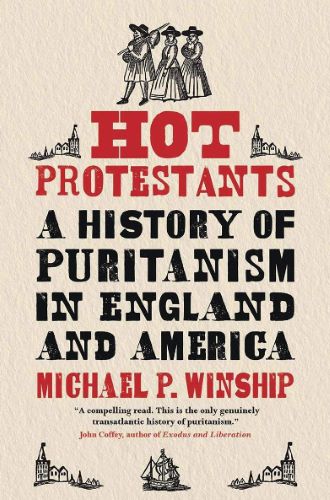
I do this penance for my naughty living and for fornication.
John Griffith, forced to publicly declare his sins in a Gloucester market, 1552
A puritan is such a one as loves God with all his soul, but hates his neighbor with all his heart.
John Manningham, 1602
H.L. Mencken, better known for his bon mots than the systemization of his thought, famously quipped that the essence of Puritanism was the “haunting fear that someone, somewhere, may be happy.” Classic Mencken — funny, cutting, memorable. The sort of joke that has Mencken elevated into the pantheon of a Mark Twain or an Oscar Wilde, even if it takes a bit of flatulence to reach such an apotheosis. It’s also the sort of witticism that tells you something about the man who phrased it. The Puritans were a particular bugaboo for Mencken, as he (anachronistically) identified them as the ancestors of contemporary fundamentalists, and they were a convenient cipher for everything he found priggish, uninspired, prosaic, mundane, and tyrannical about American culture. As an aphorism, Mencken’s contention about Puritanism is easily quotable, and helps to establish he who is using those words as being on the journalist’s side of rationalism, of good humor, of joie de vivre.
Mencken prided himself on his rationalism, materialism, secularism, and atheism — the sort of man who, despite writing for a newspaper in a mid-sized Mid-Atlantic city, could still declare himself to be the “American Nietzsche.” This was a gentleman who was to have no time for the archaic faith, superstition, or bunkum that he thought defined American life; the stalwart critic of our simple-minded “boobocracy,” the reporter dutifully filing copy from the 1925 Scopes Trial in Dayton, Tennessee. “The way to deal with superstition is not to be polite to it,” wrote Mencken for the Baltimore Evening Sun, “but to tackle it with all arms, and so rout it, cripple it, and make it forever infamous and ridiculous.” Who wouldn’t prefer to have martinis at the Maryland Club with Mencken rather than praying in a back-numbing pew with Cotton Mather? And yet Mencken has always had his own tyrannical side — he was the racist, elitist, antisemite opponent of the New Deal who claimed that “[l]iberty and democracy are eternal enemies,” and who said of Benito Mussolini that “he is probably the most perfect specimen […] on view in the world today.” Suddenly, one wonders if they haven’t given Mather short shrift by comparison, at least in considering the source of our distaste.
Duplicitous to claim that, because Mencken was a nasty piece of work — bigoted, intolerant, and overrated — his great straw-enemy of Puritanism can somehow by exonerated. Certainly, it’s possible to hold these as two separate truths — that Mencken was a bit of a tyrant and that the Puritans were an unpleasant influence on the American mind, weighing us down psychically like an anchor dropped in Boston Harbor. Worth making us take a bit of an extra look though, for like Ambrose Bierce before him and Christopher Hitchens after, Mencken had the not unadmirable ability to simply assert something and through sheer power of rhetoric and humor make you ignore the fact that whatever was said is at best completely unsubstantiated and at worst totally incorrect. “The great artists of the world are never Puritans,” Mencken confidently wrote, as if he’d never heard of Daniel Defoe, Thomas Nashe, or Anne Bradstreet. Of John Milton. “No virtuous man […] [has written] a book worth reading,” he claimed, though Paradise Lost certainly seems worth it. Yet the Puritans remain our embarrassing grandfathers, they of buckled black shoe and wide-brimmed hat, remembered once a year as part of the saccharine civil ceremony of Thanksgiving and otherwise shunted away as our button-upped ancestors freezing in distant New England. For all that we’re dimly aware of these serious men, authors of the Mayflower Compact and “A Model of Christian Charity,” founders of Harvard and Yale, we can’t quite shake the feeling that they’re the sort of people who’d have brief, uncomfortable sex on a knotty wooden board. “Let us thank God for having given us such ancestors,” wrote Nathaniel Hawthorne, “and let each successive generation thank Him […] for being one step farther from them.” Seems about right.
READ ENTIRE ARTICLE AT LOS ANGELES REVIEW OF BOOKS
Why the Puritans Cracked Down on Celebrating Christmas
It was less about their asceticism and more about rejecting the world they had fled.
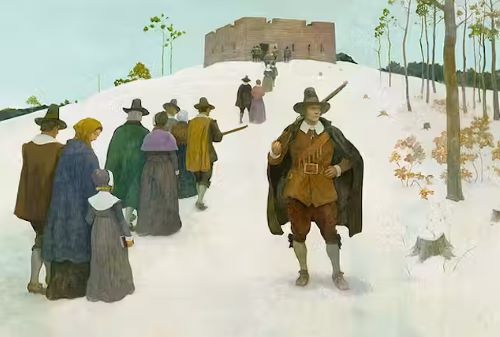
When winter cold settles in across the U.S., the alleged “War on Christmas” heats up.
In recent years, department store greeters and Starbucks cups have sparked furor by wishing customers “happy holidays.” This year, with state officials warning of holiday gatherings becoming superspreader events in the midst of a pandemic, opponents of some public health measures to limit the spread of the pandemic are already casting them as attacks on the Christian holiday.
But debates about celebrating Christmas go back to the 17th century. The Puritans, it turns out, were not too keen on the holiday. They first discouraged Yuletide festivities and later outright banned them.
At first glance, banning Christmas celebrations might seem like a natural extension of a stereotype of the Puritans as joyless and humorless that persists to this day.
But as a scholar who has written about the Puritans, I see their hostility toward holiday gaiety as less about their alleged asceticism and more about their desire to impose their will on the people of New England – Natives and immigrants alike.
READ ENTIRE ARTICLE AT THE CONVERSATION
Read More Puritan Poetry
Coming to love Puritan poetry is an odd aesthetic journey. It’s the sort of thing you expect people partial to bowties and gin gimlets to get involved with.
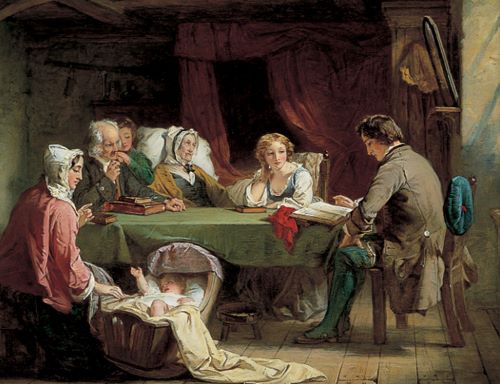
“I am drawn, in pieties that seem/the weary drizzle of an unremembered dream.”
John Berryman, Homage to Mistress Bradstreet (1956)
At the height of their dominance, the North American mastodon traversed from the Arctic Circle to as far south as Costa Rica, going extinct during the Pleistocene about 11 millennia ago. With an average height of 14 feet and a weight of around eight tons, the pachyderm foraged throughout the frozen American forest for millions of years; white tusk glinting in moonlight, coarse brown hair hanging in ragged clumps from massive haunches, trumpeting trunk echoing in Yosemite, the Berkshires, the Adirondacks. Sometime in the last 20, or 30, or 40 thousand years, one of these mammoths perished in those virgin woods near what would be Claverack, N.Y., her body covered over in rich soil and her bones transmuted into fossils. Above her decaying corpse the glaciers would recede, then the ancestors of the Mahican would arrive, after them came the Dutch, and finally the English. A Knickerbocker whose name is lost to posterity was digging in a marsh by the Hudson in 1705 when he unearthed a five-pound honey-comb ribbed bright-enameled ivory molar. On July 23, the Boston News Letter printed report of a “great prodigious Tooth brought here, supposed by the shape of it to be one of the far great Teeth of a man.” Some of those who were enslaved, recalling their lives in Africa, remarked that the tooth looked similar to that of an elephant, but those observations were dismissed.
Edward Hyde, the infamous cross-dressing 3rd Earl of Clarendon and Governor of New York and New Jersey, had the molar dispatched to the Royal Society in London, with his own evaluation being that it was from some Antediluvian monstrosity, possibly the Nephilim spoken of in Genesis, the giant progeny of fallen angels and loose women. The Puritan divine Cotton Mather came to the same conclusion, citing the teeth in his Biblia Americana as evidence of the flood. And in Westfield, Mass., a minister named Edward Taylor wrote a poem about the gargantuan teeth. A private man, Taylor was taken to penning verse entirely for himself, and in the molar he saw a muse, writing 190 verses about how it evidenced the glory of God. “This Gyants bulk propounded to our Eyes/Reason lays down nigh t’seventy foot did rise/In height, whose body holding just proportion/Grew more than 7 yards round by Natures motion.” Taylor recorded his epic in a commonplace book of some 400 pages, which included lyrics that would eventually be regarded as the greatest of early American verse, described by Michael Schmidt in Lives of the Poets as a “strange voice, new and yet with old and tested tonalities,” sealed away in a leather-bound volume donated by his family to Yale’s Beinecke Library and fossilizing on some shelf until discovered in 1937, like an ivory tooth sifted from the silt.
READ ENTIRE ARTICLE AT THE MILLIONS
Perry Miller and the Puritans: An Introduction
Historians often treat Miller as a foil, but the Father of American Intellectual history retains untapped potential to inspire new modes of inquiry.

Perry Miller was a complicated person. He was a teacher, writer, reader, literary scholar, O.S.S. officer, world-traveler, messy-eater, social critic, academic, alcoholic, atheist, spiritualist, philosopher, and, of course, historian. Was he the Father of American Intellectual history? I suppose there are a number of mid-century historians who might deserve that title, if it’s a valuable title at all, which is questionable. Regardless, Miller’s thought, if taken seriously and explored in all its delightful complexity, still retains untapped potential to inspire new modes of inquiry and writing in U.S. Intellectual history. Here is a brief (re)introduction to Miller as most of us first encountered him: historian of New England Puritanism.
By his own account, Perry Miller’s interest in the Puritans began when he was a student of literature at the University of Chicago in the late 1920s, after an accidental encounter and instant fascination with John Winthrop’s journal. Miller’s description of the incident resembles Hawthorne’s “discovery” of the scarlet letter in a custom-house, except that Miller’s fascination was with an idea rather than an object. But Miller found himself in an intellectual environment decidedly hostile to the study of ideas and even more hostile to the Puritans themselves. Progressive historians, most notably Charles Beard and Carl Becker, argued that material concerns, not ideological imperatives, were the motivating forces of history; ideology was merely a fig-leaf for these base motives. Furthermore, due to their unrelenting belief in progress, these historians viewed the Puritans– conservative even for the seventeenth century– as the enemy. Puritanism, social critic H. L. Mencken satirized, was “the haunting fear that someone, somewhere, might be happy.” In this context, Perry Miller began his life-long argument that Puritan ideology should be taken seriously.
Perhaps in response to this hostile environment, perhaps because it was his nature, or perhaps not wanting to be out-done by H. L. Mencken, Miller’s writings contain sardonic denunciations of the value of the history of the material. “I am fully conscious that . . . I have treated in a somewhat cavalier fashion certain of the most cherished conventions of current historiography,” he wrote in the introduction to his first book, Orthodoxy in Massachusetts, published in 1933. “I lay myself open,” he continued sarcastically, “to the charge of being so very naïve as to believe that the way men think has some influence upon their actions, of not remembering that these ways of thinking have been officially decided by modern psychologists to be just so many rationalizations.” In 1961, in a new preface to The New England Mind: From Colony to Province, he again denounced the value of social history in the same cantankerous fashion, writing that after he once remarked ironically that the history of Puritan thought seemed to some historians “as much written by the actions of men of business as by theologians,” he was “soon appalled by the eagerness with which . . . reviewer[s] seized upon this . . . as a welcome release from the burden of ideas which my treatment had imposed upon them.” The most generous sentiment Miller could muster for the history of the material in this preface was his concession that “trade routes, currency, property, agriculture, town government and military tactics . . . indeed require an exercise of a faculty which in ordinary parlance may be called intelligence.”
READ ENTIRE ARTICLE AT SOCIETY FOR U.S. INTELLECTUAL HISTORY
Reading Puritans and the Bard
Without the bawdy world of Falstaff and Prince Hal and of Shakespeare’s jesters, there would have been nothing for those dissenting Puritans to dissent from.
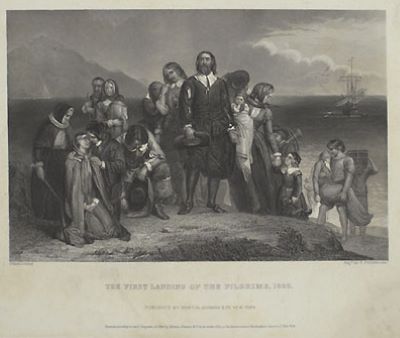
History has a kind of conscious life in the institutions, ideologies, movements, and forces that seem to constitute the daylight workings of society; but it has a kind of nocturnal life as well—a dream world ruled by the various alchemies of metaphor and symbol, where the boundaries between one institution and another with which it is constantly at war, between an idea and its contrary, swim about in a kind of cultural ectoplasm where forms change places with one another, sending the spirit of one into the body of its sworn antagonist, bringing the dead back to life in new incarnations.
Robert Cantwell, When We Were Good: The Folk Revival (Cambridge, Mass., 1996)
Last year, over spring break, I attended the annual meeting of the Shakespeare Association of America (SAA), which happened to be held in Bermuda. For a historian accustomed to events like the AHA, OAH, or the Omohundro Institute’s annual conferences, let me tell you, SAA in Bermuda was an eye-opener. First of all, the Shakespeareans know how to party. Their receptions were lavish—one night, it was a buffet dinner with open bar in a swank Bermuda hotel, with a steel drum band and dancing. Why can’t we historians live like this?
But the conference was revealing in another way, or at least it confirmed a suspicion that had been growing on me for some time. As I listened with interest to the remarkable range of panels and papers devoted to Shakespeare and his world, it seemed ever clearer to me that Shakespeare is the major figure in the “nocturnal life,” the “dream world,” of early American history, if I may borrow Robert Cantwell’s compelling image. For a variety of somewhat surprising reasons, I have been exposed to more Shakespeare over the past dozen years than I might have anticipated. In addition to the Bermuda meeting, during which I forced myself to pay close attention to The Merchant of Venice in order to think about the problem of money in the Atlantic economy, I have also had the pleasure of watching my children, ages twelve and ten, appear in productions of The Tempest and Hamlet, and these experiences have fed a minor Shakespeare obsession on their part. Abetted by the theater opportunities of a smallish college town, they have attended at least a dozen full-scale productions of various Shakespeare plays—comedy, history, and tragedy—and seen versions of many others on video and DVD. For a historian of early America, especially one who has so far specialized in Puritan New England, all this Shakespeare has had a salutary effect.
READ ENTIRE ARTICLE AT COMMON PLACE
This “Miserable African”: Race, Crime, and Disease in Colonial Boston
The murder that challenged Cotton Mather’s complex views about race, slavery, and Christianity.
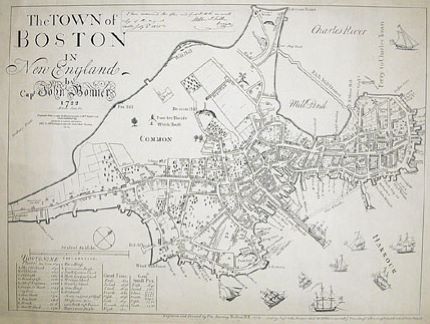
This is a story about how a small piece of historical evidence, just a few words on an old map, shed new light on a dramatic murder case from early-eighteenth-century Boston. The evidence involves the spread of a horrible disease that was a scourge of both the Old World and the New and that, recently, has returned to haunt our own. The legal case is that of Joseph Hanno, a freed slave from Africa who, in 1721, was executed for killing his wife. It was a crime of brutality, enacted on the margins of colonial society–and one that, ironically, would challenge the authority of one of the most important religious leaders of the day.
I had encountered the story of Joseph Hanno before. As a graduate student, I had read an essay titled “Narratives of Negro Crime in New England, 1675-1800.” The author described a sermon given upon Hanno’s execution as having “[set] the pattern” for the pamphlet accounts of black robbery, rape, and murder that peppered the colonies, stories that frequently implied that blacks were inherently inferior to whites–criminals by nature. As I debated how to begin a new book on the history of Afro-American citizenship, I recalled the article, and I soon found myself squinting at the first page of a sermon projected on the screen of a microcard reader. It bore an impressive title and an imposing array of typefaces (fig. 1): TREMENDA: The DREADFUL SOUND with which the WICKED are to be THUNDERSTRUCK, Delivered upon the Execution of a MISERABLE AFRICAN for a most inhumane and uncommon MURDER.
Who was this “miserable African”? From what evidence remains, we know that Hanno was a former slave, probably from Madagascar, who arrived in New England as a child around 1677. His masters were said to have “brought [him] up in the Christian Faith,” and Hanno, baptized and literate, came to be known in Boston for the breadth of his Christian knowledge: he once was described as “always vain gloriously Quoting of Sentences from [the Bible] wherever [he] came.” In 1721, about thirteen years after he was set free, Hanno was accused of murdering his wife, Nanny Negro, as she was getting ready for bed, by hitting her over the head with the blunt end of an axe. He was indicted, tried before a jury at the court of assize and general gaol delivery, convicted (after the trial, he admitted his guilt), and sentenced to die by hanging.
READ ENTIRE ARTICLE AT COMMON PLACE
‘Easy Money’ Review: The Currency and the Commonwealth
Saddled with debt and forbidden by the crown to mint money, Boston’s Puritans dreamed up a novel monetary system that we still use today.
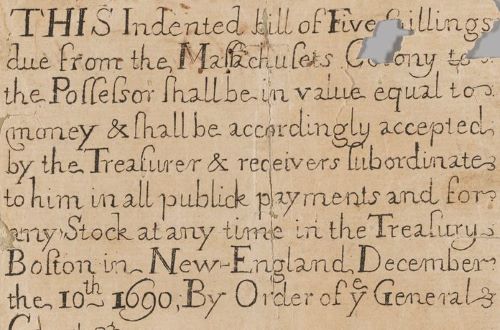
The year 1692 is infamous in Massachusetts history. It was then that, in Salem, hundreds of women—and men too—were accused of witchcraft, and 20 were tried and executed for an imaginary crime. In the same year, another momentous event took place in the colony, though it has nothing of the same notoriety: The Puritan leadership that had overseen the Salem Witch Trials—responding to some of the same social pressures that had fueled the witch craze—perfected a financial instrument that would prove to be the template for modern currency. In brief, they reimagined money primarily as legal tender for taxes, a conceptual revolution that makes the government’s authority the only source of a currency’s value. This is the basis of the monetary system that prevails throughout the world today under the reign of the Almighty Dollar.
Dror Goldberg’s “Easy Money” provides an engrossing narrative account of this lesser-known crucible. Although scholarship about the first American colonies could fill the Mayflower, Mr. Goldberg’s chronicle is the first book-length attempt to explain why a defining concept in our global financial system emerged within a desperate theocracy on the fringes of the British Empire.
Unlike Virginia and other early colonies in the New World, Massachusetts was led not by aristocratic adventurers but by the upwardly mobile middle classes of English society. And, as Mr. Goldberg points out, the colony was founded at precisely the moment when England was beginning the leap from an agricultural to a capitalist economy. Devout religious motives led the Puritans to Massachusetts, but financial ingenuity allowed their pious enterprise to survive and thrive.
Lacking the institutional structures that reinforced social order in the Old World, Massachusetts’s leaders relied on consensus and consent. Though the ministerial elite tolerated no dissent in its religious mission, on practical matters, such as raising revenue and spending it, the colonial government was the most democratically accountable in the world at the time. For good reason, Alexis de Tocqueville identified the colonial New England township as the seedbed of American democracy.
READ ENTIRE ARTICLE AT THE WALL STREET JOURNAL
How America Became “A City Upon a Hill”
The rise and fall of Perry Miller.
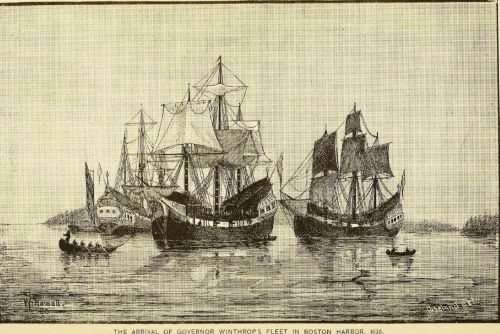
Perry Miller, a midcentury Harvard scholar of history and literature, was a giant of academe. From 1931 to 1963, as the scholar Michael Clark has summarized, Miller “presided over most literary and historical research into the early forms of American culture.” He helped establish the study of what he called “American Civilization,” contributing to the rise of a new discipline, American Studies.
Devoting himself to what he called “the meaning of America,” he tried to unravel its mystery and understand “America’s unending struggle to make herself intelligible.” After he died, the theologian Reinhold Niebuhr said that “Miller’s historical labors were . . . of such a high order that they not only gave delight to those who appreciated the brilliance of his imaginative and searching intellect, but also contributed to the self-understanding of the whole American Nation.”
That self-understanding, for Perry Miller, started with the Puritans. In graduate school, as Miller once recalled, “it seemed obvious that I had to commence with the Puritan migration.” The short prologue of his most widely read book, Errand into the Wilderness (1956), uses the words “begin,” “beginning,” “began,” “commence,” and “origin” fourteen times in three short pages, and almost all of those words applied directly to the Puritans. And because he began America with the Puritans—because he did so in such an original way and with such overwhelming force—he left in his wake a long train of scholars who took up the study of early New England with fresh interest, all of them re-envisioning Puritanism for the twentieth century.
Miller’s most lasting influence, however, came not from his overall study of the Puritans but from his assertions about one particular text. In deciding that “the uniqueness of the American experience” was fundamentally Puritan, Miller turned to the precise origin of America—the founding of Boston in 1630 with the arrival of John Winthrop on the Arbella. Or, to be more precise, he turned to the moment marked as an origin in a mostly forgotten text. After all, other Puritans founded Salem in 1628; the Mayflower Separatists established Plymouth in 1620; the Dutch arrived in Manhattan in 1609; the Spanish set up St. Augustine in 1565; and Native Americans had been here all along. Then, too, there was that other English colony farther south, Virginia, founded in 1607, which Miller dismissed for lacking the “coherence with which I could coherently begin.”
READ ENTIRE ARTICLE AT NATIONAL ENDOWMENT FOR THE HUMANITIES
What the Republican Debates Get Wrong About the Puritans
Pence invoked them at the Republican debates, but a true reckoning with their history provides a different vision of the nation’s future.
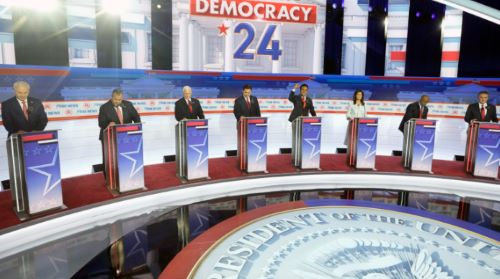
During the first Republican presidential primary debate, on August 23, former Vice President Mike Pence spoke of founders of the nation conquering the American “wilderness.” It was one of many mentions of American history: Candidates also name-checked the Declaration of Independence, the U.S. Constitution, and the legacy of President Ronald Reagan. Toward the end of the evening, Pence stressed the wilderness theme: “If we renew our faith in one another and renew our faith in Him, who has ever guided this nation since we arrived on these wilderness shores, I know the best days for the greatest nation on earth are yet to come.”
Historical references are so ubiquitous in presidential debates and stump speeches that they can seem superficial. This year’s Republican candidates seem especially committed to the idea that the past matters, perhaps because of battles over history and ethnic studies curricula spreading in some states. If, as Florida Gov. Ron DeSantis opined, “We cannot be graduating students that don’t have any foundation in what it means to be American,” then perhaps we also need to pay closer attention to what kind of American identity candidates are finding in history.
When Pence referenced conquering the wilderness, he used a keyword lifted from the Puritans. Those early American immigrants make cameos in plenty of political speeches, but often in ways that are misquoted or misunderstood, because their writings reflect a world of the 1600s, whose concerns are not identical to those of our time.
In England, the Puritans constituted a religious minority who opposed the state-sanctioned Church of England, which they believed had betrayed true faith. By leaving for North America, many believed they were testing whether their distinct vision of Protestant Christianity could survive in a new continent.
READ ENTIRE ARTICLE AT ZÓCALO PUBLIC SQUARE
Great Awakenings
Darkness Falls on the Land of Light
Divisions in society and religion that still exist today resulted from the “Great Awakenings” of the 18th Century.
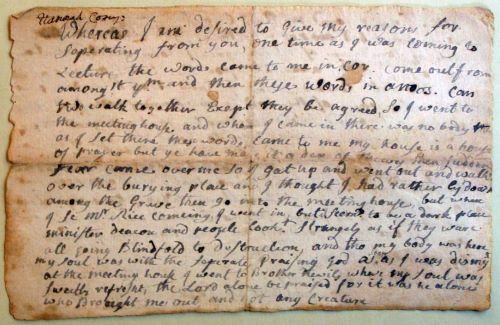
For my Part I can’t but think … That it is highly Incumbent on all who are not Seized with a Vertigo, to Stand upon their Guard, and in the most ardent Strains to lift up their Voice to the Most High, when the Religion of the Bible is like to be laid aside, for Some present immediate Inspirations—And not only so, but that Men should be often, and earnestly call’d upon and caution’d to Avoid that New Light which will lead Us into Darkness.
JOSIAH COTTON TO SAMUEL MATHER, 1742
Deep in thought, Hannah Corey stood alone among the gravestones of the Sturbridge, Massachusetts, burial ground, gazing across the common at the Congregational meetinghouse. She and her husband, John, had affiliated with the church in the west parish of Roxbury by owning the covenant shortly after their marriage in 1741. Two years later, they moved to the recently settled frontier of central New England and proceeded to join the Sturbridge church in full communion. They had presented each of their four children for baptism shortly after their births. Now, during the fall of 1748, Corey faced serious—even supernatural—misgivings about her place within the sole, tax-supported religious institution in town.
Corey had arrived early that afternoon for Caleb Rice’s weekday lecture. As she sat in the empty pews awaiting the Sturbridge minister and her neighbors, the words of Jesus’s stern rebuke to the moneychangers in Luke 19:46 suddenly darted into her mind: “My house is the house of prayer but ye have made it a den of thieves.” Corey had a strong intimation that this was no ordinary meditation, daydream, or idle musing. Instead, she interpreted the scriptural words as an oracular communication from the Holy Spirit. It was the third revelation she had received that day. Two other biblical passages had impressed themselves on her mind as she walked along the road to the meetinghouse. Amos 3:3 and 2 Corinthians 6:17 spoke directly to her reservations regarding the fitness of the Sturbridge church. “Can two walk together, Except they be agreed”? “Come out from amongst them.” The words thundered in her ears. Could she continue to walk with her neighbors in Christian fellowship? Was God commanding her to leave the church? With mounting concern, Corey confronted the troubling possibility that she had been worshipping for years in a den of thieves. “I thought,” she later recalled, “that I had rather ly down among the Graves than go into the meeting house.” So she fled to the adjacent burial ground to collect herself and contemplate the meaning of God’s powerfully intrusive messages!
Corey eventually quelled her fears and returned to her pew, but, as she listened to Rice’s sermon, she was overcome by a queer feeling. The entire meetinghouse “Seemed to be a dark place,” she remembered. The minister, deacons, and congregation “lookt Strangely as if they ware all going Blindfold to destruction.” Shaken by the peculiar turn of events, Corey and her husband abandoned their pew and retreated to the home of a neighbor named Isaac Newell. There, they gathered in prayer with a small group of disillusioned men and women who had just renounced their membership in the Sturbridge church. The dissenting faction included the town’s first deacon, Daniel Fisk, his outspoken brother Henry, and perhaps a dozen former church members and discontented parishioners from several neighboring towns.
READ ENTIRE ARTICLE AT AMERICAN HERITAGE
The Person Formerly Known as Jemima Wilkinson
Awakening from illness, the newly risen patient announced that Jemima had died and that her body had been requisitioned by God for the salvation of humankind.
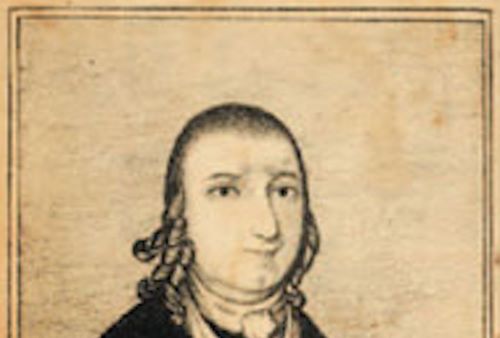
Mere months after the signing of the Declaration of Independence, a strange figure on horseback began to circulate throughout the New England colonies. The body atop the horse responded to the name of Public Universal Friend, and the double column of riders who followed behind their leader all believed that the Friend’s body housed the Spirit of God, sent to Earth to deliver an urgent message. Paying little heed to worldly skirmishes between Revolutionaries and Redcoats, the Friend galloped across the countryside announcing that the Apocalypse was drawing nigh. The Public Universal Friend exhorted audiences to heed heaven-sent warnings meant to save those who would listen, believe, and endeavor to live righteously — that is, according to the Friend’s advice.
God had selected a handsome female body for the Universal Friend to inhabit, one that had recently belonged to Jemima Wilkinson of Cumberland, Rhode Island. Jemima was known as an intelligent and attractive 23-year-old woman when she was struck by fever on October 5, 1776. Her family summoned a doctor when her condition worsened, but there was little to be done; the patient seemed doomed by the 10th, when her illness climaxed in babbling delirium.
Miraculously, the fever broke and the body calmed. According to family lore, Jemima’s body had chilled in death before it warmed and revived. The other Wilkinsons were astonished when her body arose from the bed on October 11. But if the family at first rejoiced that Jemima had been spared, they were mistaken: the newly risen patient announced that Jemima had died and that her body had been requisitioned by God for no less holy a purpose than the salvation of humankind.
Unusually, Jemima Wilkinson was unwed at the time of her illness: most of her peers were married mothers by their early 20s. She was born November 29, 1752, the eighth child of Jeremiah and Amey Whipple Wilkinson, and was named after one of Job’s daughters. Amey would go on to have four more children, the last of these deliveries killing her in 1764. Jemima was only about 12 years old when this occurred but would later understand that her mother had spent her entire adult life pregnant and nursing.
Jeremiah Wilkinson did not remarry, carrying on with the family by himself. Like any young woman of farmer’s stock, Jemima was expected to help with chores and raise her younger siblings. Formal education was out of the question; at the time, women bore much of the responsibility of instructing their children, their daughters in particular. Lacking a mother, and expected to labor in the home, Jemima turned to books, proving herself a prodigious autodidact. Aside from the Bible, she read deeply from the work of esteemed Quakers, including George Fox, William Penn, and the martyr Marmaduke Stephenson, one of three Quakers executed in Boston in 1659.
READ ENTIRE ARTICLE AT LOS ANGELES REVIEW OF BOOKS
God and Guns
Patrick Blanchfield tracks the long-standing entanglement of guns and religion in the United States.

“But a storm is blowing from Paradise; it has got caught in his wings with such violence that the angel can no longer close them. The storm irresistibly propels him into the future to which his back is turned, while the pile of debris before him grows skyward. This storm is what we call progress.”– Walter Benjamin, Theses on the Philosophy of History
“The truth about the world, he said, is that anything is possible. Had you not seen it all from birth and thereby bled it of its strangeness, it would appear to you for what it is, a hat trick in a medicine show, a fevered dream, a trance bepopulate with chimeras having neither analogue nor precedent, an itinerant carnival, a migratory tentshow whose ultimate destination after many a pitch in many a mudded field is unspeakable and calamitous beyond reckoning.”- Cormac McCarthy, Blood Meridian
READ ENTIRE ARTICLE AT THE REVEALER
The Unquiet Hymnbook in the Early United States
Exploring the ways that religious ideologies and communities shaped the revolutionary era.
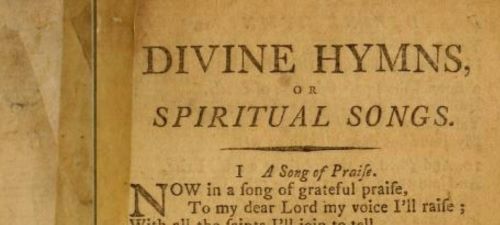
It’s not much to look at. Just over 13 centimeters tall, wrapped in a rough paper over scaleboard and a cheap leather spine (the paperback binding of early America), this book wasn’t even allowed to stay in the local historical society that glued shelf-marks to its cover. And yet Divine Hymns, or Spiritual Songs; For the Use of Religious Assemblies and Private Christians (New London, Conn., 1797) was an engine of social and cultural change, alongside tens of thousands of similar copies and hundreds of titles that flooded the Anglophone print market of the later eighteenth century. Those ubiquitous volumes were hymnbooks, words-only collections of a new kind of worship text that spent the eighteenth century migrating from a private devotional context to the heart of the Sunday church service. Only almanacs were produced in greater numbers; only Bibles were read more often. Yet we have been slow to recognize the historical role of these books that seemed to be everywhere, leaving them in the background of our understandings of religion, print, reading, and identity. As it turns out, many of our stories of reading, piety, and secularization (among others) can look quite different once hymnbooks are given their due.
Much of the hymnbook’s success in the latter half of the eighteenth century lies in a central tension in the genre: while the book’s various texts could fire the emotions, its paratexts—stanzas, numbering systems, indices—gave a collective sense of control, of system, and thus of rationality. In this sense, the hymnbook exerted its influence at the cutting edge of secularism in an age of both revival and reason. These books were unquiet, in the sense developed by Colin Jager, containing and distributing energies and emotions in their texts and the performances they afforded; these energies resisted control or explanation. As Jager argues, “a simple but crucial fact” often neglected in studies of early American and transatlantic religion is “that secularism is not first and foremost about religion but concerns instead power.” As religious change in the eighteenth century led to “new forms of social significance,” Jager writes, those forms readily appeared in “noisy” or “unquiet” ways, from large revival meetings to heightened individual affect. And few religious practices in early America were as noisy as hymn-singing.
READ ENTIRE ARTICLE AT AGE OF REVOLUTIONS
A History of the Jerks: Bodily Exercises and the Great Revival
A digital archive of first-person accounts from the turn of the 19th century chronicling an unusual display of religious ecstasy.
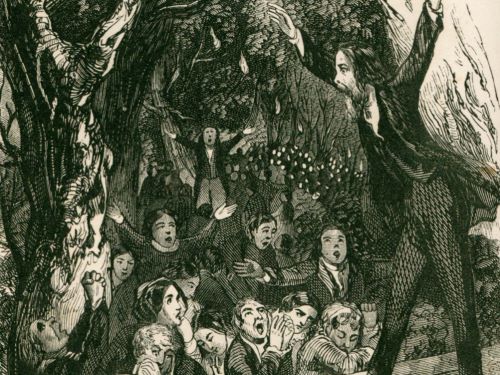
Between 1799 and 1805, the backcountry settlements of the early American frontier blazed with religious excitement. From western Pennsylvania to northern Georgia, middle Tennessee to the Carolina piedmont—but especially in the Bluegrass Country of Kentucky and southern Ohio—tens of thousands of frontier settlers gathered for multi-day, open-air religious meetings in which teams of Baptist, Methodist, and Presbyterian ministers preached from morning until late at night. Ministers claimed to have converted thousands at camp meetings during the first decade of the nineteenth century. From innovations in theology and hymnody to church organization and denominational proliferation, the Great Revival played a decisive role in the development of early American evangelicalism and the southern Bible Belt.
The revivals also stimulated the development of innovative new religious practices known collectively as the “bodily exercises.” Men and women in the throes of conversion collapsed to the ground, then rose up and began dancing. Others lay insensate for hours, enraptured with dramatic visions of heaven and hell. Camp meeting participants barked liked dogs, scampered up trees, engaged in trance walking, ran headlong through the woods, faced off in mock boxing matches, and burst into uncontrolled peals of holy laughter. Observers witnessed people speaking in unknown tongues and claimed to have heard music issuing miraculously from the chests of young converts.
Of the various somatic religious exercises that spread across the trans-Appalachian frontier and southern backcountry during the Great Revival, none drew more astonished commentary or more virulent opposition than “the jerks”: involuntary convulsions in which the subjects’ heads lashed violently backward and forward. More than half a century before the derisive phrase holy roller was coined to describe the ecstatic worship practices of Holiness and Pentecostal evangelicals in Appalachia, the subjects of these extraordinary bodily fits were known as “Jerkers.”
This Storymap sketches the controversial history of the so-called “jerking exercise” of the Great Revival and provides access to a curated digital archive of rare letters, diaries, journals, autobiographies, and published documents chronicling the history of the jerks over more than a century.
READ ENTIRE ARTICLE FROM THE UNIVERSITY OF RICHMOND
Paradise Lost
Why a hundred thousand Americans were ready to believe that Christ would return to earth in 1843.
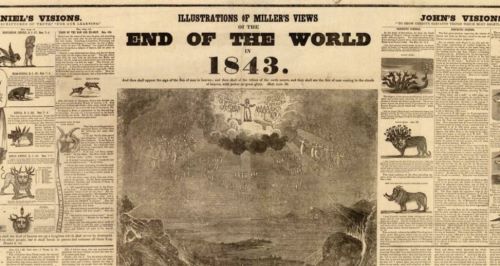
BRIAN: This is BackStory with the American Backstory hosts. I’m Brian Balogh, 20th Century Guy.
ED: I’m Ed Ayers, 19th Century Guy.
PETER: And I’m Peter Onuf, 18th Century Guy. Our show today is all about the history of doomsday in America– prophecies and proclamations about what comes next, if anything.
ED: It’s hard to separate talk of the apocalypse from talk of religion. The very term apocalypse is most often associated with the New Testament book of Revelation. It means an uncovering or a revealing. Back in the 1830s and 1840s, America was experiencing a wave of religious fervor.
The Second Great Awakening, as it’s come to be known, was a time when many Americans thought the Second Coming of Christ was eminent. And so they threw themselves into reformed movements like temperance and abolition. They wanted to make America a fitting place for the coming kingdom of God, scrubbing out the sins of this world to pave the way for the next. It’s in this context that one particular end times prophecy caught fire and became remarkably mainstream. Jess Engebretson tells the story.
VOICE-OVER FOR WILLIAM MILLER: I’m fully convinced that sometime between March 21, 1843 and March 21, 1844 Christ will come and bring all His saints with him.
JESS ENGEBRETSON: This particular prophecy was the work of a small town Vermont farmer named William Miller. Miller had become convinced of Christ’s imminent return back in the 18 teens, after applying some complicated arithmetic to the book of Daniel. But he was a cautious man, and didn’t want to spread the extraordinary news until he was quite sure he’d gotten it right.
Separation of Church and State Has Always Been Good for Religion
The US Supreme Court’s most recent decisions undermine centuries of established secularism within American government.
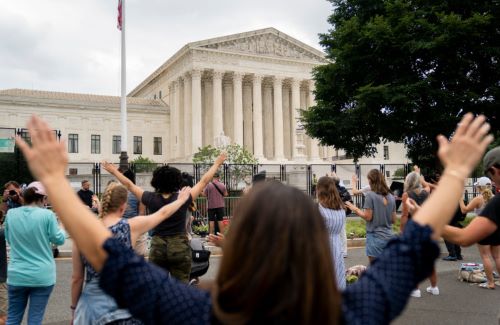
During the autumn of 1831, as the United States was in the midst of fervent religious revivals known as the Second Great Awakening, the French intellectual Alexis de Tocqueville attended a service at a Quaker meeting house in Philadelphia. Tocqueville was initially confused by the experience, writing in his classic 1835 account Democracy in America how he was unsettled by the silent gathering of women and men in a plain church. He finally said to a worshiper next to him, “I wanted to attend a divine service, but you seem to have conducted me to an assembly of deaf-mutes.” He was then gently corrected by the Quaker, who answered: “Dost thou not see that each one of us is waiting for the Holy Spirit to illuminate him? Learn to moderate thy impatience in a holy place.” Benevolently chastised, Tocqueville sat alone with himself and the spirit, contemplating the man’s words, until there was an interruption. Another Quaker stood up and spoke of the “inexhaustible goodness of God and of the obligation of all men to help each other, whatever might be their beliefs or the color of their skin.” After the U.S. Supreme Court’s rulings these past two weeks, it would be helpful to revisit this history.
Of aristocratic stock and nominally Catholic, Tocqueville had never quite observed anything like this Quaker service. This denomination was periodically persecuted in Europe but had found a home in Pennsylvania since that colony’s founding in the 17th century. It had thrived alongside other non-conformist denominations since the new Republic had been founded as an officially disestablished state which recognized no official creed. Leo Damrosch writes in Tocqueville’s Discovery of America that “Philadelphia had every possible shade of belief on view. One visitor counted thirty-two churches representing seventeen different sects, as well as two synagogues.” This must have been dizzying to the Frenchman who came from the land—as his countrymen Voltaire had joked—of a thousand sauces and one religion.
This month, the Supreme Court released rulings for Carson v. Makin and Kennedy v. Bremerton School District, both 6-3 decisions which broke among the justices according to predictable ideological lines. In the first case, the court ruled that it was unconstitutional for the state of Maine to deny taxpayer funded educational vouchers for parents to pay for student tuition at schools with an explicitly sectarian curriculum. The second case ruled in favor of a Washington state football coach, employed by a public high school, who officially ended each game with a Protestant prayer and reprimanded students who refused to join. By setting this dangerous precedent, the Supreme Court threatens a truly distinguishing feature about American democracy. It breaches the wall of separation between church and state, betraying the ethos which so impressed Tocqueville.
READ ENTIRE ARTICLE AT RELIGION & POLITICS
The Rise of Pentecostal Christianity
While the world’s fastest-growing religious faith offers material benefits and psychological uplift to many, it also pushes a reactionary political agenda.
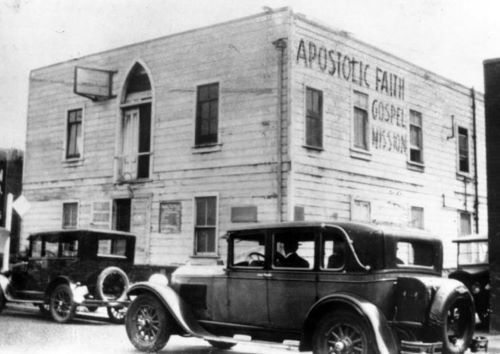
Robinson
I do want to discuss the ways that your book documents how these churches are adapting to the 21st century through being very social media savvy. But first, let’s go back. Where did this come from? This distinct Holy Spirit-infused sub-branch of evangelical Christianity?
Hardy
So it’s generally attributed to what’s called the Azusa Street Revival, which happened in Los Angeles in 1906. And it was led by the son of freed slaves from Louisiana, a man named William J. Seymour. He’s credited as the founder of Pentecostalism, although I think his mentor, who was a white man, probably has a better claim. His name was Charles Fox Parham, an itinerant Methodist preacher from Kansas. And he was practicing a lot of stuff that was coming around in 19th-century America, with frontier culture and all sorts of things that happened after the Civil War—whether it was women starting to preach or people perhaps angry with organized religion or things just changing and that real kind of wandering, conquering spirit that I think was going on in America. Some strains of new thought, like Ralph Waldo Emerson.
So it really emerged out of Methodism. And that’s where Charles Fox Parham really got going. He had a dispute pretty early, because he wanted to practice some of these new bents on really taking on the Holy Spirit, and speaking in tongues, and getting those blessings bestowed upon you that people started to talk about. This stuff had really died out a couple of centuries after Jesus. Things like speaking in tongues were really confined to the monastery for millennia, and people started bringing some of these ideas back. So he and a group of followers in Kansas were really interested in healing; Parham and his young son were both quite sickly. If there isn’t great health care now, there certainly wasn’t back then. So a group got together in 1901, they were fasting and praying. And the Spirit came upon a woman called Agnes Ozman, and she started speaking in tongues. And I believe that at the time, they thought it was Chinese, and they were mocked in the press. They said that this wonderful moment had happened, and they were called the Tower of Babel and really ridiculed. But Parham was a pretty headstrong dude. And he began taking it around Kansas and Texas and Oklahoma and preaching this new bent on faith. And in Houston in 1906, he met his protégé, William J. Seymour. Because of Jim Crow laws at the time, Seymour had to take his instruction out in the corridor while the white men sat inside. But obviously, they were very, very different men in every way. But they had something in common and saw something in each other, and they used to go out preaching on street corners. Parham preached to the whites, and Seymour would preach to the Black people, and Seymour was then invited up to a church in Los Angeles and pretty soon locked out, which always seemed to happen to Pentecostals—someone would lock them out. He had this huge moment. He had a group of followers then and they were praying and fasting for days on end.
READ ENTIRE ARTICLE AT CURRENT AFFAIRS
The ‘Psychic Highway’ that Carried the Puritans’ Social Crusade Westward
Elements of the Puritans’ unique worldview were handed down for generations and were carried westward by their descendants, the people we call Yankees.
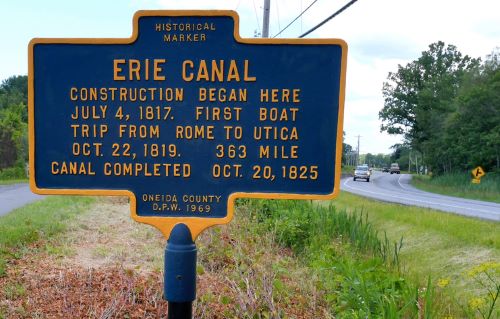
It took me six days to drive the 700-odd miles from Boston, Massachusetts, to the grave of Charles Grandison Finney in Oberlin, Ohio. My last-minute trip wasn’t terribly well planned. I had allowed for some audible calls, serendipity, and unrelated detours. (Like an opportunity to tour the Lucille Ball Desi Arnaz Museum in Jamestown, New York. It was fabulous.)
My journey was part historical tourism and part pilgrimage. There’s nothing like being in a particular city or region to make history and its stories come to life, even if you are hundreds of years removed.
I’d long wondered how, in a nation that fetishizes size, tiny New England managed to inject so much of its culture into the American mainstream. I’d been reading about the Puritans for years, but at some point I realized that my interest was less in them and more about the legacy they left to America.
New England Puritanism, historians tell us, ran its course by the early 1700s. But elements of the Puritans’ unique worldview were handed down for generations and were carried westward by their descendants, the people we call Yankees. This culture was transmitted in a variety of ways, through the establishment of schools, universities, publications, lecture series, social and political causes, commercial enterprises, as well as in the founding of cities and towns throughout the United States.
Long confident in their superiority, New Englanders sought to impose their culture on the country at large. Their first major regional expansion ran through Western New York State onto the northeastern quadrant of Ohio known as the Western Reserve.
READ ENTIRE ARTICLE AT CONTRA MUNDUM
Spiritualism
The Fox Sisters
The story of Kate and Margaret Fox, the small-town girls who triggered the 19th century movement known as Spiritualism.
Joanne Freeman: But first we’re going to begin in the 19th century when the idea that the living could commune with the dead turned into a full fledged American religion. It was known as spiritualism. And while there’s been plenty of debate about what to make of it, most people agree on when and where it started. In 1848 in a tiny town in upstate New York. I’m going to hand things over now to Nate Dimeo to tell us the story of the Fox sisters.
Nate: People said the house was haunted and that was even before the two girls started talking to the dead. Kate Fox was 11, her sister Margaret was 14 when they moved into a little house in a nothing village, 40 miles East of Rochester, New York. A little house that all their neighbors knew as the one where the traveling salesman had been invited in years before and was never heard from again. Never heard from that is until one night in March of 1848 when their parents first heard the sound. Some nights it would sound like knocking other nights like furniture moving and it always seemed to come from the girl’s bedroom. But they’d open the door and their daughters would be fast asleep.
Nate: They never suspected that their daughters could be tricking them. They were just young girls, but they were tricking them. What started with a little tap tapping on the wall and tiptoeing back into bed with giggles muffled by pillows, got more sophisticated as the nights went on. And on the night of March 31st the Fox sisters revealed the latest in their growing repertoire of ghost stimulating techniques. The one that would place the two girls at the center of a cultural and religious revolution.
Nate: They call their mother into the room. Margaret snapped her fingers once and they heard a tap and response. She snapped twice and it tapped twice the next night. All of their neighbors squeezed into the girls candle it room. They explained that one tap meant yes, two taps meant no. And then they started asking questions. And in the morning the audience left convinced that they had spent the night in the presence of a dead man and two girls with incredible powers.
Nate: Mr and Mrs. Fox wanted to protect their daughters and they sent them to live with their responsible older sister, Leah. But they soon found that the ghost followed the girls and Leah found an opportunity. She had booked her little sisters in a 400 seat theater in Rochester. By 1850 they were the toast of New York city. People would wait in line for hours to ask the sisters for words of their dead loved ones on the other side. William Cullen Bryant caught their act, James Fenimore Cooper, George Ripley, though we don’t know whether he believed it or not. The newspaper man, Horace Greeley introduced them to New York nightlife in the pages of his paper, introduced them to the world. Soon people were holding seances like we hold dinner parties, but even as spiritualism was sweeping the nation, it was leaving the sisters who started it behind.
Nate: On October 21st, 1888 a 54 year old Margaret Fox sat on the stage at the New York Academy of Music in front of 2000 paying customers and her sister Kate and showed them all how she spoke to the dead. She told them about how 40 years before back in that little house in the nothing town after a few nights of knocking and tiptoeing back to bed, she and her little sister realized that they could both crack their toes and no one could see them doing it. And that when they did, people actually believed they were hearing from dead people. Because sounds are hard to place in space and because you believe pretty much anything if you really want to believe it.
Nate: She revealed all of that but not everything. She didn’t tell them about how she and her little sister started to unravel not long after Horace Greeley introduced them to the world. And to worldly things like power in wealth and wine. She didn’t tell them about how her sister began to believe that maybe there was something to it all, even as they both struggled under the growing weight if their shared secret. And she certainly didn’t tell them about the night she tested her own belief. After scurvy had taken the life of a polar explorer who had taken her heart. Now she broke down and tried to contact him, tried to do for real what she had spent the last nine years pretending to do. She didn’t say how she called out to him and how he didn’t call back. And how she sat in the dark knowing that he never would.
Nate: Kate and Margaret Fox weren’t forgotten, but at the times of their deaths, they weren’t remembered fondly. Each died poor, neither living to see 60. The people who still clung to spiritualism were glad to see them go. And people who never believed, they were too. Now, there is a postscript here that really can’t be resisted and you can do with it what you will. They tore that little house down in 1904 and inside one of the walls near the girls room. They found the skeleton of a man believed to be a traveling salesman who appeared to have been murdered a few years before the Fox family moved in. It’s true.
The Plunder and the Pity
Alicia Puglionesi explores the damage white supremacy did to Native Americans and their land.
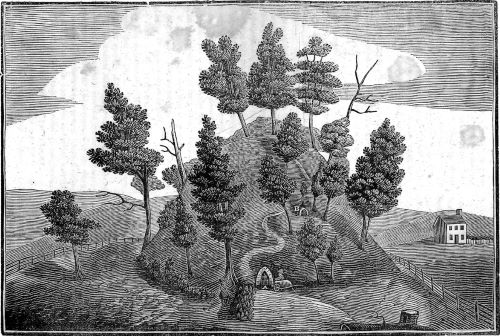
The American Society for Psychical Research still exists. A group of scholars and scientists including William James founded it in 1885 to promote the study of dreams, clairvoyance, mind reading, premonitions, séances, hallucinations, out-of-body states, and other such phenomena. At the time many people in the United States had been caught up in the Spiritualist movement, with its mediums who contacted the dead and reported back. The ASPR wanted to determine whether the mediums were frauds; if they weren’t, could the spirits’ special info, or the cryptic message in a dream, somehow make a person rich? Its archives contain thousands of accounts by everyday citizens who said they had firsthand knowledge of unexplainable psychical occurrences. As the oldest institute for such research in the US, the society has been located at a few addresses, mostly in New York City. Today it is in a town house on the Upper West Side.
When Alicia Puglionesi, a writer with a Ph.D. in the history of science, medicine, and technology, began to work on a book about the society, its staff figured she must be a researcher from a ghost-chasing cable show, of which there are many; apparently the society gets a lot of nonserious inquiries. She e-mailed, called, left messages—no answer. Finally, she took a bus to New York from her home in Baltimore and went to 5 West 73rd Street. After a day of alternately sitting on the steps in front of the locked and iron-gated entry and leaning on the buzzer, she got in. Persuading the society’s president of her seriousness, she was allowed into the archives.
The rule “Be careful what you wish for” always applies. Letters about people’s psychical experiences (especially yellowing, crumbling letters from more than a century ago) tend to be incredibly boring. She was not the first to discover this. Back in the early days of the society James himself was almost defeated by the correspondence: the piles of letters the society received were “a weariness, and I must confess…almost intolerable to me.” But Puglionesi stuck with it. In the book that resulted, Common Phantoms: An American History of Psychic Science, she describes her research as, often, “an aimless drift through the flotsam of the unremembered dead.” This had been the main challenge for the ASPR right along—reading all the mail and making note of what, if anything, the letters contained. As the hours went by, Puglionesi found herself confronting a tedium requiring a “devotion to something beyond the self, something so vast that it can only be glimpsed through the labor of many human lifetimes.”
READ ENTIRE ARTICLE AT THE NEW YORK REVIEW
Throngs of Unseen People
A new history of spiritualism during the Civil War era suggests an unexpected link between the Lincoln family and that of John Wilkes Booth.
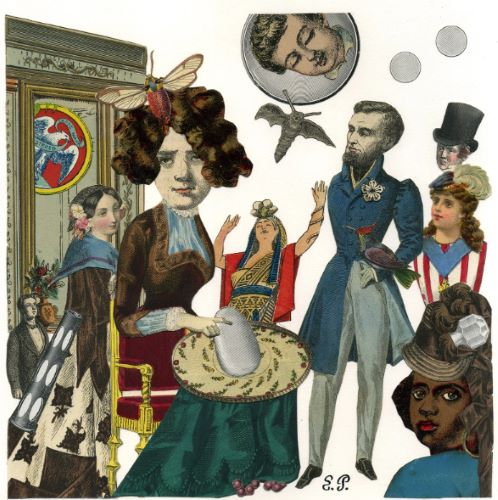
When eleven-year-old Willie Lincoln died of typhoid in the White House in February 1862, his parents were devastated. For weeks President Lincoln held solitary grieving sessions every Thursday, the day of his son’s death. Mary Lincoln swung between agonized sobbing and passive despair. She wore mourning clothes for months, wrote on stationery trimmed in black, and could not bear to look at photos of Willie or enter the room in which he had died.
Solace came to her through spiritualism, the popular movement that allegedly put the living in direct contact with the dead. Mary communicated with Willie and other deceased loved ones through mediums and her own powers of spiritual sight. She told a relative about Willie’s private visits to her: he “comes to me every night and stands at the foot of my bed with the same sweet adorable smile he has always had. You cannot dream of the comfort this gives me.” President Lincoln, who attended some of the dozen or so séances that were held at the White House during the Civil War, was not, like his wife, a devotee of spiritualism, but he viewed it with genuine interest.
Contact with the other world was not considered unusual in America during spiritualism’s heyday, from the late 1840s to the 1880s. Rooted in various kinds of mysticism, spiritualism mushroomed in America during the 1840s—an age of marvelous inventions, notably the telegraph, which was first demonstrated in 1844. If communications could travel thousands of miles within seconds, surely the “spiritual telegraph” could connect the living and the dead through what was thought to be invisible electromagnetic fluid. Emma Hardinge Britten, a leading spiritualist, wrote, “Our city streets are thronged with an unseen people, who flit about us, jostling us in thick crowds; and in our silent chambers, our secret closets.”
READ ENTIRE ARTICLE AT THE NEW YORK REVIEW
“Pajamas from Spirit Land”: Searching for William James
After the passing of William James, mediums across the U.S. began receiving messages from the late Harvard professor.
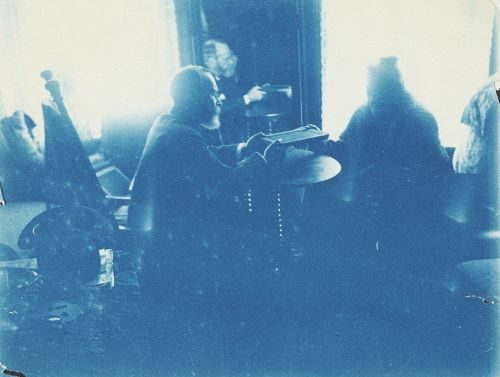
I’ve been writing a book about a failed and forgotten science, poring over the testimony of people who saw and heard impossible things, for years now. I joke that it will make me crazy. People ask if I believe in ghosts, and I can always tell if they’re asking because they experience reality as haunted in some way, or because they think I’ve fixed on a wrong idea. Walking out of the icy American Society for Psychical Research (ASPR) library into the sunset-saturated clamor of evening on the Upper West Side, I feel like a shade among the living. I have my feet in other people’s inner worlds, their yearnings and anxieties are mine. Traffic, bodegas, the cartoon animals on children’s backpacks wash over me, meaning obscured by a curtain of sheer sensory noise. Unmoored, I take my cell phone out of my pocket and call whoever will answer. It’s as simple as trading gossip with my high school best friend or an old roommate. Unbeknownst to them, they’re talking me back into our common reality. But where am I when I’m drifting? What if no one answers the call? Over time, the people we love slip out of range.
It was hard for his friends to let William James go. “I always thought that [he] would continue forever”, declared the irascible editor John Jay Chapman, “and I relied upon his sanctity as if it were sunlight.” James’ death in August of 1910 came on quickly, though he had long suffered from ill health. The fact that he was so often sick, and the causes of his illness so obscure, made even James doubt that his heart would finally fail. Perhaps he could still think his way out of it. If only he could overcome the growing anxiety that his major contributions to philosophy, 1907’s Pragmatism and 1909’s A Pluralistic Universe, were being misinterpreted and poorly received. His gasping for breath was “partly a spasmodic phenomenon”, he insisted, something in the mind. Yet, as his brother and wife rushed him across the Atlantic after another failed Alpine rest cure, it became clear to all of them that it would be his last return to New England. In constant pain, he could no longer walk and had to be carried on a litter. Sixty-eight years of chaotic comings and goings, restless transmissions, had come to an end. This ending left Henry James “in darkness . . . abandoned and afraid”. The elder brother was a pillar shoring up Henry’s unstable emotions. “His death changes and blights everything for me”, Henry wrote, staggering under the weight and finality of loss.
READ ENTIRE ARTICLE AT THE PUBLIC DOMAIN REVIEW
The Emancipatory Visions of a Sex Magician: Paschal Beverly Randolph’s Occult Politics
How dreams of other worlds, above and below our own, reflect the unfulfilled promises of Emancipation.
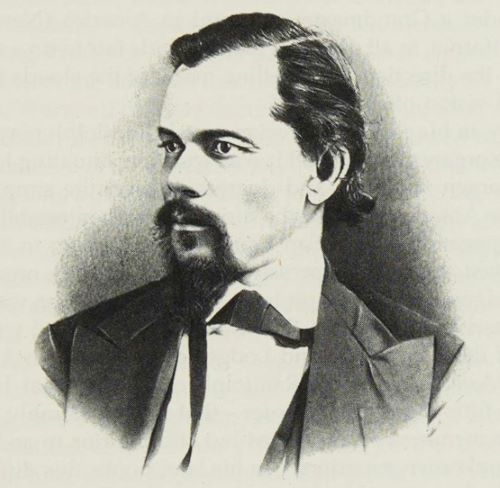
Born in Five Points, Manhattan to a Black mother and a white father who left soon after his birth, Paschal Beverly Randolph (1825–1875) grew up in poverty that deepened after his mother died of cholera when he was six. After a difficult, itinerant childhood, he recounts working on ships sailing between New England, Cuba, and Britain, before beginning to lecture on spiritualism and perform as a trance medium. In 1858, however, he publicly broke with the spiritualists, citing their racism, the hypocrisy of their radicalism, and their narrow view of the immaterial world. In a series of lectures, he attacked the characters of leading spiritualists, ridiculed their trances as “jugglery” (or worse, demon possession), dismissed their “business of world-bettering” as hypocrisy, and railed against some of their central tenets, such as the belief popularized by Andrew Jackson Davis that only select souls are immortal and thus all spirits are good. He concludes, “My crime was rete mucosmal”, residing in the color of his skin. Randolph relates that after a harrowing suicide attempt (or, as he explained it elsewhere, a transformative experience with Egyptian hashish), he finally left spiritualism behind.
While Western occultists balked at a “tawny student of Esoterics” like Randolph, they often invested their knowledge with power by racializing it, attributing its secrets to Oriental, Chaldaic, Persian, Egyptian, Asiatic, or Arab sources. Randolph trafficked in this manufactured exoticism too, but also developed a philosophically and politically complicated theory of the occult anchored in his own racialized identity. “I owe my successes,—mental,—to my conglomerate blood; my troubles and poverty to the same source”. He spent two of his most productive writing years in Louisiana, where he encountered the area’s rich African diasporic religious life. Although in one of his lectures he boasts of exposing “the whole tribe of voudeaux in New Orleans”, he also concedes “it was from one of the voudeaux queens . . . that I gained much of my knowledge”, and elsewhere he cites hoodoo and obeah practices and flaunts the secrets he learned from “the quadroons of Louisiana”. His self-identification as a “sang mêlée” — Randolph’s curiously feminized form of the colonial intellectual Moreau de Saint-Méry’s term for people with the smallest fraction of African ancestry — afforded him “peculiar mental power and almost marvelous versatility”. Because he already channeled multiple racial identities within his body, Randolph reasoned, he was predisposed to channel other identities, not of this world.
Although at times Randolph insisted that “not a drop of continental African, or pure negro blood runs through me”, over the course of his life he increasingly identified with the struggles of Black people. When the Civil War began, he recruited Black troops for the Union army, and during Reconstruction he worked as a teacher and agent for Freedmen’s Bureau schools in Louisiana, participated in important Black and Republican conventions, and served as a correspondent for the Weekly Anglo-African. But from within these established institutions, Randolph was also developing a subterranean praxis that he called “angular and eccentric” and which L. H. Stallings describes as that of a “funky black freak”. He founded a series of secret societies organized around his idiosyncratic interpretation of Rosicrucianism, an esoteric religious movement claiming to preserve the wisdom of a mysterious ancient order, and he dreamed of building still more. Randolph produced a huge body of writing, which he mostly self-published with his first wife, Mary Jane Randolph, and his second wife, Kate Corson Randolph, both gifted spiritual practitioners in their own right. In handbooks, pamphlets, novels, newspaper articles, manifestos, historiography, a wildly embellished memoir, printed “private letters”, handwritten manuscripts, and more, he taught curious students a kind of DIY occult practice that used their own bodies — through study, sex, and drugs — to make connections with the spirit world. But the gospel of a hallucinatory, cosmic sex magic was not an easy path for anyone in the late nineteenth century, much less a Black man. Randolph struggled against racism (which he deeply internalized), economic precarity, and an abiding sense of being an outsider his entire life. Even when it came to his own theories, he seems to have vacillated between belief and doubt. In 1875, he shot himself in the head at age forty-nine.
READ ENTIRE ARTICLE AT THE PUBLIC DOMAIN REVIEW
She Spoke to the Dead. They Told Her to Free the Slaves.
In 1850s Vermont, Achsa Sprague swore that the spirits who helped her walk again also possessed her with a crucial mission: freeing every soul in America.
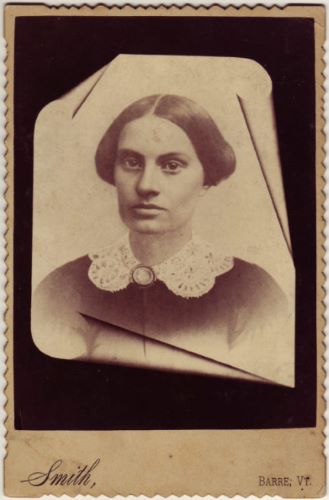
A woman with dark, glossy hair and sharp cheekbones stood confidently under a tent with her eyes closed. About a thousand convention-goers waited for her to speak, standing patiently or sitting on the grass. Five full minutes ticked by on the timepiece the organizers had provided to keep the convention schedule on track. Still she stood there with her eyes closed, and the crowd waited.
It was Friday, June 25, 1858, and the first day of the Rutland Free Convention had already been momentous, and hot. The massive tent was set in a green field on the outskirts of Rutland, Vermont, then a city of about 7,500 people, and it was visible from half a mile away. Booths surrounded the tent, selling lemonade, root beer and soda pop. “The whole aspect of the locality was precisely that of a Country Fair,” a New York Times reporter wrote. The convention-goers’ only other relief from the heat was ice water poured out of faucets set into two casks that were continuously being refilled by men driving horse-drawn wagons. The overheated crowd congregating here were a motley crew of people dedicated to various causes: abolitionists, women’s rights advocates, supporters of nonviolence, death penalty protesters, Spiritualists (followers of a religious movement based on communicating with the dead) and other progressives dedicated to ideas considered radical in 1858.
The woman the crowd was eagerly waiting to hear was not just another convention speaker.
Achsa W. Sprague was one of the convention’s instigators, among 150 people to petition for a convention of “all philanthropists and reformers” to be held in the small, central-Vermont city “to discuss the various topics of reform now engaging … progressive minds,” according to an announcement from the organizers. That morning, the 30-year-old Sprague had been elected one of the convention’s 18 vice presidents, one of three women chosen for the role.
Five years earlier, few (if any) who knew Sprague would have imagined her playing a lead role in something like this, or even standing in front of a thousand people. Back then, she struggled to walk across a room, due to debilitating chronic pain. She rarely left her family’s house, except for frequent visits to doctors. But things had changed dramatically, and Sprague’s gratitude toward the “spirit friends” who had taken away her pain would motivate much of the rest of her life, including her involvement in the Rutland Free Convention.
After the election of officers that morning in Rutland, the congregators took turns proposing resolutions for the convention to adopt. The second of the 11 resolutions stated, “that Slavery is a wrong which no power in the universe can make right.” Taking a radical stance against slavery’s institutional enablers, the resolution explained that any government or any religious body or figure that “by silence or otherwise, authorizes man to enslave man, merits the scorn and contempt of mankind.”
READ ENTIRE ARTICLE AT NARRATIVELY
William James and the Spiritualist’s Phone
A story of a philosopher, his sister, and belief.
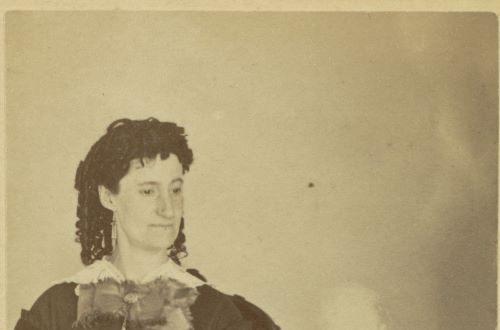
The dead spoke through Leonora Piper, and the living answered through her hand. Shouted, really, because the connection between her hand and Eternity was often spotty. Calling on the dead required this kind of stagecraft in the waning days of the Spiritualist movement, when every quack with a set of candles claimed knowledge of the occult.
Leonora would first enter into a trance, goosefleshed and murmuring. The sitters would take her hand. They would then scream questions at her open palm, as though it were a murder suspect, or a bad dog, or the receiver of an old-timey telephone. In fact Leonora called her hand “my spiritual telephone.” Perhaps she knew, psychically, that her séances would one day resemble something far more terrifying: bad improv comedy.
Alice James did find it hilarious. Her brother William—a professor at Harvard, one of America’s most important philosophers and psychologists, and the brother of its most famous living novelist, Henry James—had been fooled by a Boston housewife who claimed to speak to dead people. By the time the eldest James sibling wrote to Alice in 1885 requesting a lock of hair (to test Leonora’s “psychometric” abilities), he had already sat for multiple sessions in the psychic’s darkened parlor, scribbling notes as she stuttered out communiqués from the spirit world. Leonora had distinguished herself from pretenders with the maternal exactness of her insights. She knew things about the dead that mothers know—the hue of a birthmark, the shape of a scar. It helped that she was a mother herself and looked the part, with her high-necked dresses and fussily wreathed hair.
The twenty-eight-year-old Leonora never advertised her abilities. If anything, she seemed embarrassed by them. But word had gotten around the previous year, when she had visited a clairvoyant, a blind former judge, to ask about a pain in her side and passed out at his table. When she came to, she hastily scribbled a note: a message for your honor, she explained, from his dead son. Leonora had not intended to upstage a stooped provincial psychic in his own home. Back then, she wanted only to have more babies and live out her tidy little life. As she got older, she refused to travel for any psychic business unless her kids could come, too. But she lived in a war-ravaged country of worn-out people, all broken from burying children and pledged to private ghosts. They pleaded for her help. Who was she to refuse them?
READ ENTIRE ARTICLE AT LAPHAM’S QUARTERLY
Modern Mindfulness is Rooted in a Racist History
Before Americans turned to Buddhism for life hacks, they treated it like a dangerous cult.
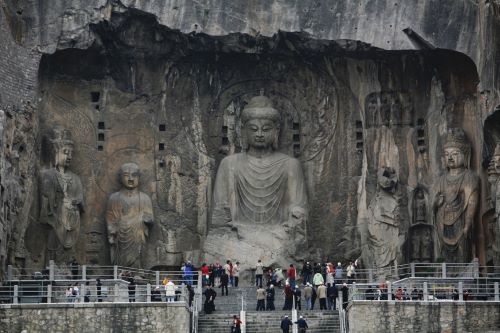
In January 1902, Reverend Clarence Edgar Rice warned Americans of a religion that “both in theory and practice…degrades women,” practices “crass brutality” towards animals, and “goes hand-in-hand with vice…that blushes not at unspeakable practices.” Even more terrifying, this “cruel” and “pessimistic” tradition was making inroads in the United States through both immigration and the conversion of American citizens. Similarly, American newspapers during the Progressive Era warned of “the religion of gloom and melancholy,” being spread by debaucherous “priests of unutterable cruelty [who] traffick in human flesh.”
What was this terrible creed, with its awful priests? It was Buddhism—a tradition today often heralded in popular culture as the path to everything from a better professional career to world peace.
Within a century, Buddhism in America has gone from being frequently portrayed as a “dangerous cult” to becoming the prime spiritual practice of the business elite. Americans now generally view Buddhism favorably, according to Pew Research Center, while Canadians view Buddhism in equal favorability with Christianity, according to an Angus Reid poll. Mindfulness is taught in schools, and Buddhism is presented as a sort-of spiritual science. How can our views of Buddhism have changed so much in so little time?
Why Did Everyone in the 19th Century Think They Could Talk to the Dead?
On the spiritualists of New York City and beyond.
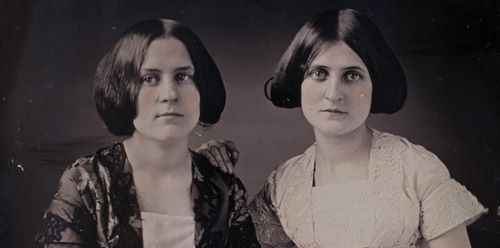
From about the last week of May through mid-July 1850, a steady stream of visitors made their way to a parlor in Barnum’s Hotel on Broadway. On the door of the room, they found a notice giving the rules for guests: the admission fee (one dollar per person), seating arrangement, and instructions to act as if in a solemn religious gathering. Visitors then took a seat at a long table that sat up to thirty people, to put questions about their deceased loved ones, or general questions about the afterlife, to “the spirits,” courtesy of Maggie and Kate Fox, teenage sisters from a small village upstate whose Morse code-like communication with a disembodied being had received wide attention after a demonstration in November 1849 at Corinthian Hall in Rochester.
The sisters had begun their “spiritual telegraph” innocently enough, playing with a household poltergeist as if with a cat, but this cat had a voracious appetite and began to devour the unsuspecting girls and any who would follow them. The story of the Fox sisters and the birth of Spiritualism has been told many times: on April Fool’s Eve in 1848, two sisters aged 10 and 14—having grown up in a house reputed to be haunted—play at speaking with the ghost by way of a rapped code; the invisible entity tells the girls lurid tales about a murdered peddler; the girls’ older sister exhibits them as having the ability to speak with the dead, giving birth to the many-colored movement known as Spiritualism. To get at the truth of this seemingly eccentric episode of American history requires a certain sideways glance.
At the very same moment when the Fox sisters arrived in Manhattan, another poltergeist was grabbing headlines across America. On Sunday, March 10, the Reverend Eliakim Phelps of Stratford, Connecticut, returned with his family from church to their sprawling mansion on Elm Street to find all the doors and windows open. Inside, they found the furniture knocked over, dishes smashed, books, papers, and clothing scattered all over. They had not been robbed; Reverend Phelps found his gold watch, silver heirlooms, and even loose cash undisturbed. In an upstairs bedroom, a sheet was spread over a bed, and Mrs. Phelps’s nightgown was laid out on it. At the bottom, a pair of stockings were stretched out, and the arms of the gown were folded across the chest, like a corpse.
READ ENTIRE ARTICLE AT LITERARY HUB
The Man Who Photographed Ghosts
The work of William Mumler and the mysteries of spirit photography.
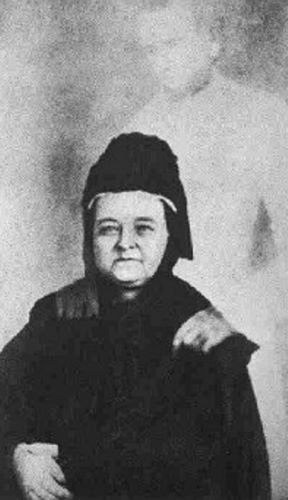
Before there’s even a chance to delve into “The Apparitionists,” the frontispiece gives the whole thing away. It’s a quote — I’d never seen it before — from Franz Kafka: “Nothing can be so deceiving as a photograph.” It immediately caught my interest because it captures something that I already believe: that photography is inextricably connected with lying. How could it be otherwise? I have a theory of how language started. Whether it was in the Garden of Eden or in some primal swamp, Og was trying to trick Ug into believing the wildebeest went to the right when in fact it had gone to the left. He at first tried various forms of gesticulation and pointing, but was unclear whether he had effectively communicated his deception to Ug. Suddenly it occurred to him that if he said, “The wildebeest went to the right,” he could more effectively trick Ug into believing this falsehood. It’s hard for me to imagine that language could have been invented without the simultaneous need to communicate and to deceive. In fact, in my more pessimistic moments — they occur fairly frequently — it’s hard for me to imagine communication without deception. They go hand in hand.
So how does photography fit in with all of this? Isn’t lying, if you buy into my argument, an artifact of language? Where are the verbs, the adjectives, the nouns in a photograph? They’re nowhere to be found. That alone has led me to assert that photographs have no truth value. They can’t be true, false or anything in between, whatever that might be. However, stick a sentence next to a photograph and you have a potent missile more powerful than anything dreamed up by either Donald Trump or Kim Jong-un.
In “The Apparitionists,” Peter Manseau takes us on an expedition through the beginnings of photography and its deceptions. No sooner had people invented a way of creating photographic images (whether it was a daguerreotype, an ambrotype or a hallotype) than people found ways of altering the images — and, even more relevantly, of lying about their contents and how they were obtained. A photograph, as we well know, can’t talk back. It’s like a piece of taxidermy. It can’t say to us, “No, I’m not a picture of Abraham Lincoln.” And often the provenance of a photograph, its causal connection to the world, is hidden. All we’re left with is an image that, for all intents and purposes, could have been given to us by aliens. This is where Manseau comes in. In a world overcome with death and the horrible losses of the Civil War, people turned to photography hoping to be united with deceased loved ones in perpetuity. It’s that strange combination of desire, hope and the presence of an image that seems almost alive that makes us think we’re in contact with a timeless realm that transcends death.
READ ENTIRE ARTICLE AT THE NEW YORK TIMES
The Strange Revival of Mabel Dodge Luhan
The memoirist is at the center of two new, very different books: a biography of D. H. Lawrence and a novel by Rachel Cusk. Has she been rescued or reduced?
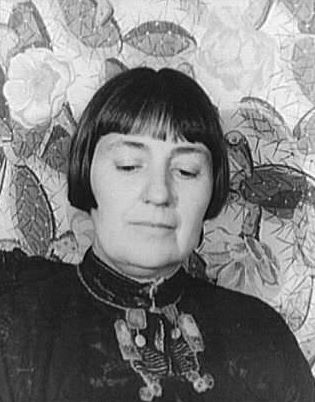
“Now don’t you keep going on to me about introverts and extraverts and insides and outsides,” D. H. Lawrence wrote to Mabel Dodge Luhan in 1924. Instead, he continued, she should wash the dishes until she could keep up a rhythm “with a grace.” At the time, Luhan was reading up on mysticism and Jungian psychoanalysis, and she had written to Lawrence about her discoveries. He was not the right audience. Lawrence regarded Luhan alternately as a source of irritation; as an embodiment of his bête noire, the dominating woman; and as a model for some of the most cruelly portrayed heroines he would ever write. He had vowed to destroy her, and she would come to believe, at times, that he had succeeded.
A former Greenwich Village radical, Luhan considered herself divinely appointed to “save the Indians” in order to restore the spiritual and sexual life of a white American society in decay. This vocation led her to New Mexico, where she ditched husband No. 3 for Tony Lujan, a man from the Taos pueblo. In Taos, she launched an artist colony, wrote volume after volume of a tell-all memoir, and hosted a parade of famous guests, Lawrence included. Their relationship is a central subject of two new books: Frances Wilson’s “Burning Man: The Trials of D. H. Lawrence,” a biography of the author, and Rachel Cusk’s “Second Place,” a rewriting of Luhan’s memoir “Lorenzo in Taos.”
It is a strange moment for a Mabel Dodge Luhan revival. Long the butt of historians’ jokes, she resists an easy feminist reading, and even the flowering of women’s histories in the seventies and eighties produced no unbridled celebrations. But she doesn’t make for a natural villain, either. Although, by today’s standards, her racial beliefs sit somewhere on the spectrum between troubling and deranged, they led her to support a multiracial array of artists and fight doggedly, and effectively, for indigenous land rights. Even her memoirs, which are peppered with occult vernacular and accounts of unhinged behavior, are essentially harmless—a modernist sex-and-gossip log, at high pitch. All the same, plucking her out of oblivion is a fraught endeavor: to mine the archive for characters to rediscover is to engage in a kind of revisionism, casting elements of the past as contemporary fables. Sometimes, that process is a cautionary tale all its own.
READ ENTIRE ARTICLE AT THE NEW YORKER
The Mediums Who Helped Kick-Start the Oil Industry
Apparently some people communed with spirits to locate the first underground oil reserves.
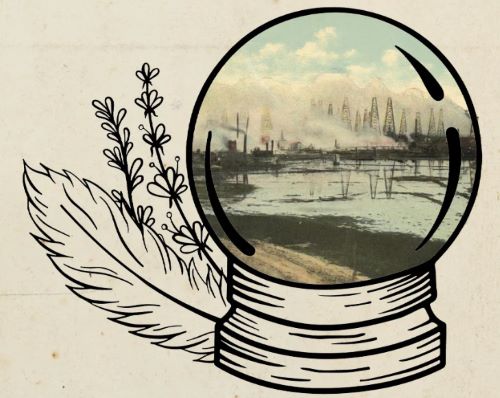
In the 1860s, the petroleum industry was in its infancy. As with the gold rush, hordes of inexperienced prospectors tried to strike it rich. But according to oil historian Paul H. Giddens, they didn’t trust scientists to tell them where to drill. The few professional geologists who tried to use “scientific means” to locate wells were “regarded as quacks” by the practical oilmen.
Instead, oilmen trusted people who relied on “spiritual, sensory, or extrasensory sources” for their authority, writes literary scholar Rochelle Ranieri Zuck.
That’s right—skeptical oilmen didn’t trust the eggheads, so they turned to diviners, mediums, and spiritualists. As Zuck writes, these people utilized “trick guessing, superstitious devices, and spiritualistic means” to sniff out oil—sometimes literally, as with “oil smellers” (who did exactly that).
Mediums used a variety of other divinatory methods, too, including dream interpretation and dowsing rods. These rods, y-shaped twigs made of witch hazel or peach-tree wood, quickly became the most acceptable form of well location. A medium would grip the wood, passing around the property. “A swift downward dip of the wood, often imperceptible to the naked eye, would show where one should locate a well,” writes Zuck.
READ ENTIRE ARTICLE AT JSTOR DAILY
Overlooked No More: Rose Mackenberg, Houdini’s Secret ‘Ghost-Buster’
Working undercover for the illusionist, Mackenberg exposed phony psychics who claimed they could connect people to their dead loved ones.
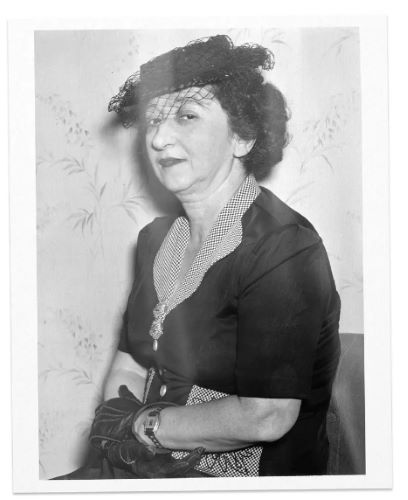
Spiritualism, the religious movement centered on the belief that the spirit survives earthly death and can communicate with the living, was at its peak in the early 20th century; its most famous advocate was probably Arthur Conan Doyle, the creator of Sherlock Holmes.
With that movement came thousands of phony psychics claiming to be mediums who could connect people with their dead loved ones.
Harry Houdini, the renowned illusionist and escape artist, attended hundreds of séances, trying to communicate with his dead parents, before deciding that many self-described seers were in fact con artists soaking the gullible.
He hinted at having occult powers of his own, but ultimately declared that his stage act was “merely a matter of a sleight of hand,” as Christopher Sandford related in his book “Masters of Mystery” (2011).
By 1924, however, Houdini wasn’t content with renouncing any claim to having mystical abilities of his own. That year he published “A Magician Among the Spirits,” a book in which he debunked some of the effects that mediums produced, like wobbling tables and floating objects. “Whenever any of these alleged spiritual mediums tell you that they have supernatural aid,” he told a reporter at the time, “you may safely set them down as frauds.”
READ ENTIRE ARTICLE AT THE NEW YORK TIMES
Dispatches from 1918
Thinking about our future, we look back on the aftermath of a century-old pandemic.

JAD: Okay, so the 1918 flu is kind of famous for being forgotten. It wasn’t widely taught in schools. You won’t find it written about in a lot of novels and plays. But what I didn’t realize is that it wasn’t just forgotten after the fact, it was ignored in the moment as it was happening. And there are a lot of reasons for this. I mean, you had censorship in certain countries. You had self-censorship in this country, journalists feeling like maybe they had to keep morale up and stay focused on the war. Not to mention there wasn’t much anyone felt that they could do about the flu. It was even kind of familiar, came around every year. And that year there was just more of it. But on top of that, and this is what I find interesting, they didn’t even know what it was. Like, think about a couple months ago, March, coronavirus. Immediately, you began to see these illustrations in the paper of this spiky ball. My kids started drawing pictures of the spiky ball. We all had something we could visualize. Back then, they had no picture of the enemy. They didn’t even know the flu was a virus. It was truly invisible.
JAD: And yet this tiny unseen unspoken of force was reshaping human history in all kinds of surprising ways. This show began with a simple question. What happens afterward, after this? And Molly Webster, who you’ll hear from later in the program suggested well, let’s look back at what happened after that one. And that’s what we’re gonna do today. As we enter the summer of coronavirus and look forward to the fall, we have five stories of how the invisible hand of that flu has continued to guide and shape us for the last hundred years and has left the world a very different place.
This House Is Still Haunted: An Essay In Seven Gables
A spectre is haunting houses—the spectre of possession.

As we have seen some languages in use today can only render the German expression “an unheimlich house” by “a haunted house.”
Sigmund Freud, “The Uncanny”
To have a ghost, you must first have a past.
Nathaniel Hawthorne was an author with a past. His fictions repeatedly return us to the foundations of the United States, weaving narrative from the way that his past lingered in his present, from a haunting. He prefaces The House of the Seven Gables (1851) with a simple lesson, that “this Romance might effectually convince mankind (or, indeed, any one man) of the folly of tumbling down an avalanche of ill-gotten gold, or real estate, on the heads of an unfortunate posterity, thereby to maim and crush them, until the accumulated mass shall be scattered abroad in its original atoms.” This lesson—past evils will destroy those who come to benefit from them—guides the haunted house tale, wherein the cracked foundations of the past must be repaired, lest the house, like Poe’s House of Usher, crumble into the earth, along with all it signifies: family, nation, hope. These are vast problems, bigger than any one house, but locating evil in a haunted place lets Americans concentrate the past’s wrongness. The haunted house is a place where we deal with how things have gone wrong.
The United States is a nation where ghosts are real. At least, they’re as real as the houses they haunt. The House of the Seven Gables depicts a house that is not ostensibly haunted by ghosts or demons; rather, it is demonized by the generational reproduction of wrongs and inequalities where haunting provides the syntax for Hawthorne to make sense of this repetition. The haunted house tale, as Hawthorne tells it, has governed the way that Americans reckon with their out-of-joint past. Hawthorne positions House as a “romance,” rather than a novel, and the former genre’s capacity for moralistic fables captures something of this House’s function as a floor-plan for a particularly American haunting. In Richard Brodhead’s account, Hawthorne’s widespread influence in American literature often has less to do with anything he himself said or wrote than with the way that later authors bring their own concerns to Hawthorne and rework his myths to their own ends. So, it’s not that Hawthorne haunts American literature; rather, that literary tradition has haunted him.
Across this history, the word “haunted” provides a vocabulary for the forces outside individual control, as well as the way that we, as individuals, are constrained by them, even and especially when we cannot perceive or even comprehend what they are. As Sigmund Freud points out, “haunted” is already a limited translation of “unheimlich,” and the repeated description of houses in particular as haunted illustrates some of the way that this vocabulary guides both thought and actions. Being haunted is, in a sense, the experience of being constrained, whether by another’s will or by the blunt necessity of historical circumstance. So, if I tell you a house is haunted, you might expect to encounter ghosts, dead bodies, perhaps the devil himself, but what you’ll find is, unfortunately, much worse.
READ ENTIRE ARTICLE AT DILETTANTE ARMY
American Spirit: A History of the Supernatural
On the occasion of Halloween, an exploration of previous generations’ fascination with ghosts, spirits, and witches.
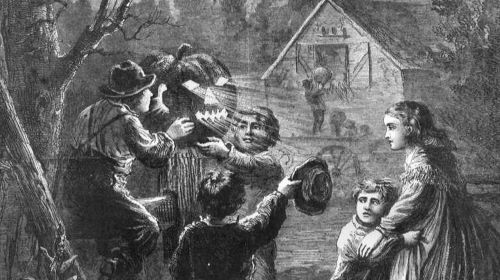
Halloween—despite its solemn Celtic roots—has become a safe way for Americans to transgress social norms and toy with the idea of ghosts in a family-friendly fashion. But for some, spirits from another plane have always been a very real part of life on this plane. So this episode of BackStory delves deeper into Americans’ ongoing fascination with the supernatural, and explores why witches, spirits, and ghosts have haunted American history.
Why were colonists so fearful of New England “witches”? How is it that progressive social reformers found a home in the Spiritualist movement of the 19th century? Why do new media technologies tend to conjure up talk of the undead? Brian, Ed, and Peter look for answers.
Music and Spirit in the African Diaspora
The musical traditions found in contemporary Black U.S. and Caribbean Christian worship originated hundreds of years ago, continents away.
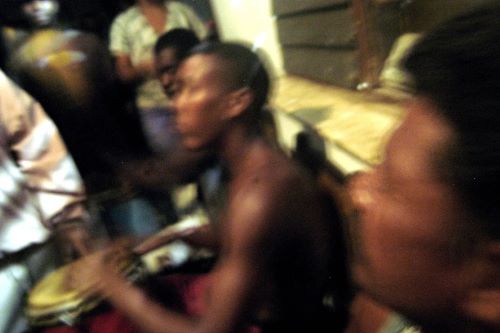
When enslaved Africans were brought to the Americas, their experiences were very different across different parts of the region. Their musical, religious and cultural traditions were frequently suppressed, and always adapted and mixed with those of other cultures. And yet, as music theory scholar Teresa L. Reed writes, religious musical traditions, often derived from West African Yoruba practices, still have remarkable parallels across U.S. and Caribbean cultures today.
Reed attended a Black Pentecostal church in Gary, Indiana as a child from the late 1960s through the early 1980s. There, it was common for a congregant to “catch the Spirit,” dancing energetically even after the church music went silent. She and her fellow parishioners recognized this as a spiritually significant event. But they were unaware that, thousands of miles away in Trinidad, Haiti and other parts of the Caribbean, worshippers in a range of religious settings experienced something very similar.
“Although Americanized in format and Christianized in content, spirit possession was every bit as much the goal, the raison d’être, of our worship as for that of our diasporal counterparts,” Reed writes.
READ ENTIRE ARTICLE AT JSTOR DAILY
Necromancers, Killers and Presidents, Summoned From the Pages of History
Did Abraham Lincoln, like John Wilkes Booth, ever find solace in spiritualism?
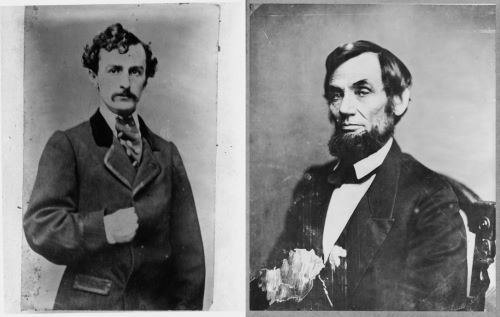
Is there anything more unknowable than a politician’s soul? Even a figure as exhaustively documented as Abraham Lincoln — whole tomes have been devoted to his marriage, his melancholy, his hats — remains in some essential way a mystery, the private man subsumed by two-plus centuries of folklore and iconography. But he was of course a person who lived and loved and grieved like any other — and like his assassin, John Wilkes Booth, found perhaps some solace in the prospect of an afterworld still reachable from this one.
At least that’s the case intermittently made by Terry Alford’s “In the Houses of Their Dead,” a well-sourced if slight piece of sideways biography that often strains to justify its thesis, but makes a lively study of two wildly disparate clans nonetheless. The ties that bound an American president and an acting scion from Maryland are somewhat legend now, a series of kinships and coincidences that range from the quotidian (both men had difficult fathers and revered Shakespeare) to the genuinely strange (Booth’s brother Edwin once purportedly saved Lincoln’s eldest son’s life on a train platform).
What’s sure is that both men were products of their time — an age, Alford writes in his colorful introduction, of great social and scientific progress, but also one where “millions of Americans clung to beliefs that seemed irrational. They believed in ghosts. They studied omens, dreaded comets and feared witchcraft. Apocalyptic writing flourished and credence was given to visions, spells and curses. Prophets and mystics abounded.” And there was profit in all that, naturally: dividends duly pursued by the parade of charlatans, schemers and true believers who parlayed their “mystical” gifts and parlor tricks to gain access to the highest halls of 19th-century power and celebrity.
Whether Lincoln ever put real stock in the self-proclaimed psychics and seers who streamed through the White House during his tenure there, largely at his wife Mary’s behest, is as often as not contradicted in the text. Though his family belonged to a Baptist church, Lincoln himself was a natural iconoclast who “had no particular religion,” according to his own stepmother, and put little faith in the concept of eternal damnation and other standard Christian orthodoxy of the day. He also, Alford dutifully notes, stopped well short of Mary’s keen, even consuming passion for spiritualism, once confiding to an Army officer that while he took solace in the words of mediums who claimed to channel the dearly departed, he understood that “it just wasn’t real. Communications from the other world were delusions, he said.”
READ ENTIRE ARTICLE AT THE NEW YORK TIMES
Speaking with the Dead in Early America
A new book recovers the many ways Protestant Americans, especially women, communicated with the dead from the 17th century to the rise of séance Spiritualism.
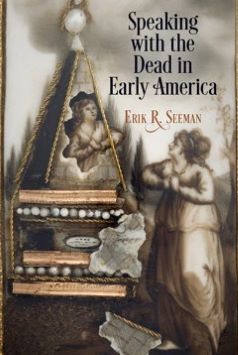
JUNTO: Your book recovers the many ways Protestant Americans, especially women, spoke with the dead from the 17th century up to the well-known rise of séance Spiritualism around 1850. What do you think caused previous historians to miss all of this pre-Spiritualism activity? Did the fact that speaking with the dead was a gendered phenomenon lead to this oversight?
ERIK SEEMAN: Yes, gender is definitely a big part of the story. For the complex of beliefs that I call the antebellum cult of the dead, the sources I use are ones historians have largely overlooked: women’s spiritual journals and sentimental literature.
Take, for example, Sally Hersey’s 200-page journal. As far as I can tell no other scholar has ever used it. Who cares about an ordinary woman’s religious musings, right? Yet in that journal are dozens of prayers Hersey composed to her dead son, daughter, and husband. “Dear departed shade,” she addressed her son, “I shall behold the[e] no more in the land of the living.” That’s not how Protestants were supposed to think about the dead.
JUNTO: There is a fascinating section in the book on the conspicuous presence of ghosts and the dead during the Salem Witch Trials. You use this to draw out the 17th century “science of the dead,” as you term it. What was the “science of the dead” and what does this framework tell us about the speaking with the dead in colonial American life?
ERIK SEEMAN: The science of the dead included efforts by minister-scientists such as Joseph Glanvil in England and Increase Mather in Massachusetts to learn about what happened to the soul after death. These ministers feared the ideas of Hobbes and like-minded materialists who were skeptical about whether the soul even existed. Glanvil and Mather felt it was a short step from “Hobbism” to a denial of God’s existence. Therefore, they became active ghost hunters. They sought credible evidence of the supernatural to prove God’s existence.
READ ENTIRE ARTICLE AT THE JUNTO
The Twisted Transatlantic Tale of American Jack-o’-Lanterns
Celtic rituals, tricks of nature, and deals with the devil have all played a part in creating this iconic symbol of Halloween.
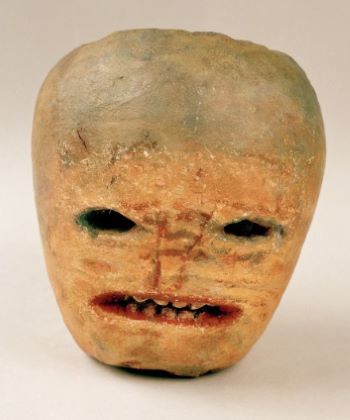
Washington Irving’s “The Legend of Sleepy Hollow,” first published in 1820 and republished in 1858, propelled the pumpkin into American culture like never before. In the short story’s climax, the Headless Horseman chucks an uncarved pumpkin at Ichabod Crane, who is never seen again. But most images of the terrifying villain portray him holding a fiery jack-o’-lantern, which helped the story become a perennial Halloween favorite.
“The legend is considered a Halloween story, probably because it was one of the first internationally well-known horror stories,” says Sara Mascia, executive director of The Historical Society of Sleepy Hollow and Tarrytown. “The pumpkin became associated with that element of fear, and that’s why the jack-o’-lantern comes out, because it’s with the galloping Hessian [soldier], the Headless Horseman, whatever you want to call him.”
In the 19th and early 20th centuries, the influx of Irish immigrants, who brought their traditions and folktales, also helped shape the story of jack-o’-lanterns in America. They discovered that pumpkins, not indigenous to Ireland but common in North America, were much better suited to carving than turnips or potatoes.
As more Americans began to celebrate Halloween, the jack-o’-lantern emerged as its most iconic image. A review in the Atlanta Constitution described the 1892 “All Halloween” party at the home of Atlanta mayor William Hemphill in glowing terms: “Never in the annals of Atlanta society has a more unique and brilliant entertainment been given,” with decor showcasing “all sorts of smiling lanterns made of pumpkins, cleverly carved with faces.”
The carved gourds have come to serve as much more than mere decoration. Despite their often fearsome look, jack-o’-lanterns now symbolize a welcoming sense of community. “At Halloween, you don’t go up to someone’s house unless they have a jack-o’-lantern,” Ott says. “It’s about cementing a community, projecting good values, neighborliness. The pumpkin and jack-o’-lantern take on those meanings, too.”
Over the past decade, the jack-o’-lantern’s popularity hasn’t dimmed. According to the U.S. Department of Agriculture, more than 1 billion tons of pumpkins were harvested in 2018. Many end up as jack-o’-lanterns on porches—although a few make television appearances on shows like HGTV’s Pumpkin Wars or Food Network’s Outrageous Pumpkins.
READ ENTIRE ARTICLE AT THE NATIONAL GEOGRAPHIC
Native American Resistance
What Tecumseh Fought For
Pursuing a Native alliance powerful enough to resist the American invaders, the Shawnee leader and his prophet brother envisioned a new and better Indian world.
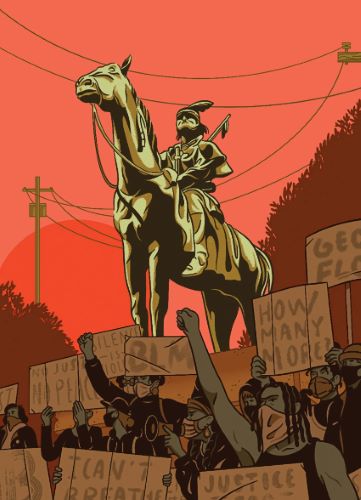
The ghosts of forgotten histories haunt America’s heartland, begging to be remembered and exorcised. George Floyd’s Minneapolis, as we have lately come to understand, has never been a harmless Midwestern town of grains and lakes. The enslaved Dred Scott’s eighteen-thirties sojourn at Fort Snelling (now part of the Twin Cities) and his subsequent return downriver to Missouri gave rise to the nation’s most notorious Supreme Court decision, Dred Scott v. Sandford, which ruled that Black Americans—slave or free—had “no rights which the white man was bound to respect.” Floyd, who died choking on that assertion, was from North Carolina by way of Houston, and the string of memorials following his death sent a mourning cry out of Minnesota back along Dred Scott’s path, downriver to the South before turning east toward the Atlantic and the distant memory of Africa.
In 1811, the Shawnee leader Tecumseh, anticipating the movements of Scott and Floyd, departed the Ohio Country and journeyed two thousand miles across the South, seeking to recruit tribes to a Native confederacy able to withstand the land hunger of the United States. The stakes could not have been higher: Tecumseh’s effort marked the last time Native peoples would be able to mobilize in concert with a formidable European military. His British allies—advancing their own geopolitics, to be sure—thought such a confederacy might buttress an Indian state, which, in turn, could serve as a barrier to American expansion. Today, one mountain, a few statues, eight towns, and several streets and schools bear Tecumseh’s name; a small collection of myths and fictions tell some version of his story. What he had hoped would be an Indian state, a consolidation of Native power, is now what Americans call the Midwest. And Tecumseh, his alliance, and his war linger only as a trace memory.
To resurrect his story is to recognize that the United States confronts not a singular “original sin” of slavery, threaded through centuries of systemic racism and extending to George Floyd’s death in Minneapolis, but two foundational sins, intimately entangled across geographies stretching from the Great Lakes to the Mississippi Delta. The Shawnee homelands were the first epic battleground in the United States’ acquisition of new territory, a process characterized by the violent plunder of Native land and its conversion into vast American wealth. After Kentucky militiamen killed him in battle, in 1813, Tecumseh and his dead comrades became fetishes of conquest in the most literal sense (the white men carried off Native belongings and carved long swaths of skin from Indian bodies to make souvenir razor strops), even as the forceful taking of the land came to seem like a lesser sin, a regrettable but necessary wrong justified by the expectation of American goodness.
READ ENTIRE ARTICLE AT THE NEW YORKER
A History and Future of Resistance
The fight against the Dakota Access Pipeline is part of a centuries-long indigenous struggle against dispossession.
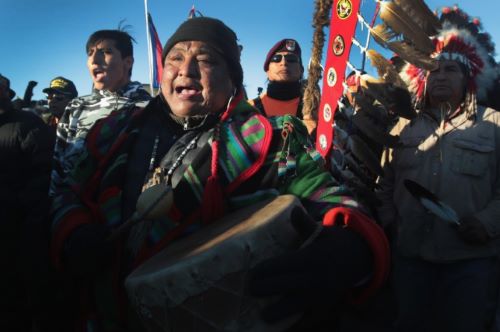
Mounted Lakota warriors, their horses resplendent in traditional regalia, charge a line of law enforcement. They gallop headlong, push back the police, pull up only at the last moment, and then circle back for more.
The scene could be the Battle of the Little Bighorn, circa 1876. But it’s not. Here, along the banks of the Missouri River, just beyond the boundary of the Standing Rock Sioux reservation in North Dakota, indigenous land and water defenders are standing together to block the Dakota Access Pipeline, which threatens their land, water, ancestral burial grounds, and future generations. They are part of a decades-long struggle to assert and reclaim indigenous lands, jurisdictions, and sovereignties. And they are doing so on ground that has given rise to indigenous resistance for centuries.
For the average American, it’s easy to mistake the resistance at Standing Rock for a one-time re-run: indigenous warriors emerge from the wild, put up a brief, fierce, but ultimately tragic fight before succumbing to progress and providence. Cowboys and Indians II: Pipeline edition.
Vine Deloria Jr, the father of Native American Studies, called this the “cameo theory” of American history. In this version of events, indigenous people are cast in fleeting roles — movie set extras in the grand drama of American progress — only to be dropped from the next episode’s storyline.
But such a narrative obscures the fact that indigenous people — not only in the United States, but across the settler colonized Angloworld in Australia, Canada, and New Zealand — have starred in a series of long-running, quietly successful movements to oppose natural resource extraction and neoliberal colonization.
READ ENTIRE ARTICLE AT JACOBIN
Wounded Knee and the Myth of the Vanished Indian
The story of the 1890 massacre was often about the end of Native American resistance to US expansion. But that’s not how everyone told it.
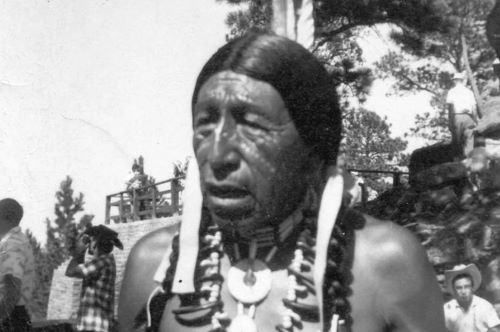
On December 29, 1890, US troops descended on the Oglala Lakota Pine Ridge Reservation in South Dakota—where the religious movement known as the Ghost Dance had taken root—and killed more than 200 men, women, and children. Starting immediately, and for more than a century since, the white public interpreted what became known as the Wounded Knee Massacre as a symbol of the closing of the American frontier and the “end” of Native people in the United States.
Lisa Tatonetti takes a close look at two books that white audiences have adopted at different times as part of that story: Santee Dakota author Charles Eastman’s From the Deep Woods to Civilization, and Black Elk Speaks, an as-told-to narrative written by John G. Neihardt based on the words of Nicholas Black Elk, an Oglala Lakota holy man. Tatonetti argues that both books rose to prominence among white audiences at least partly because their accounts of Wounded Knee fit into the widespread narrative of the “vanishing Indian.”
Eastman’s book, published in 1916, described his conversion to Christianity and “civilization.” In a commonly excerpted passage, he describes his search for survivors of the massacre as a “severe ordeal” but adds that he “passed no hasty judgement” on the perpetrators. Tatonetti explains why it became a hit among white audiences: “Here was a Native writer whose sentiments appeared to legitimate not only their own lives but also the entire doctrine of manifest destiny.”
She goes on to argue that contemporary white audiences may have read Eastman’s words as fitting a story in which Native people were responsible for their own “disappearance.” In this narrative, the emotional religious ritual of the Ghost Dance threatened white society, legitimizing the massacre.
READ ENTIRE ARTICLE AT JSTOR DAILY
Native Networks and the Spread of the Ghost Dance
A digital companion to “We Do Not Want the Gates Closed Between Us,” telling the story of Native American resistance to forced resettlement on reservations.

In the 1860s and 1870s, after years of resistance, most western Native Americans were forced to settle onto ever-shrinking pieces of land created by the United States government to relocate, contain, and separate them. Native Americans were colonized peoples living on reservations, which, the US government hoped, would keep them away from each other and from the white populations coursing through the Plains. Despite this colonial control and confinement, Native Americans were able to remain mobile in the late nineteenth century. This tenacious mobility, defined not only as the freedom of geographic movement but also the ability to share ideas and information widely, allowed western Native Americans to create vast networks of communication that traversed the boundaries of the US government’s reservations. These intertribal networks, threaded together in the 1870s and 1880s by intertribal visiting and letter writing, facilitated the dissemination of important information and ideas to Natives on a continental scale, often in opposition to US colonialism, including religious knowledge and practices like the Ghost Dance.
Networks of Visitation
Natives throughout the West, particularly those living great distances apart, visited continuously, some more than ever before, in part because of the growing networks of intertribal correspondence and the transportation provided by new western railroads. Intertribal visits were made for social, economic, political, and religious reasons. Men and women from different backgrounds shared knowledge (often anticolonial in nature), related experiences, and exchanged aspects of their cultures. But intertribal visiting persisted only because Natives demanded it. Office of Indian Affairs agents tried to limit the movement of men and women across agency boundaries, but visiting was never outright banned. Those who could not or did not care to obtain permission to visit other reservations often traveled anyway, despite the threats of punishment that might result.
Networks of Correspondence
The written language, passed along in letters through the US Postal Service, bridged the gaps among reservations, allowing men and women to communicate efficiently across the vast distances that separated them. With their own words, distant contacts could share news and express their thoughts and beliefs outside of colonial control, accelerating the development of larger intertribal communities. Natives used the US government’s suppressive education to communicate for their own purposes, to limit colonial control, direct their own lives, and expand their cultures. By 1889, nearly 12,000 Lakotas, Santees, Yanktons, Yanktonais, Mandans, Assiniboines, Gros Ventres, Utes, Paiutes, Shoshones, Bannocks, Arapahos, Cheyennes, Kiowas, Comanches, Apaches, Wichitas, Poncas, Pawnees, Otoes, Sac and Foxes, Nez Perces, Blackfeet, Crows, Omahas, Ho-Chunks, and others could read in English or their Native language. Only nine years earlier, fewer than 3,500 had been able to read. Four percent of the individuals from those tribes could read in 1880, but by 1889, the number reached 18 percent.
READ ENTIRE ARTICLE AT NATIVE AMERICAN NETWORKS
Perhaps the World Ends Here
Climate disaster at Wounded Knee.
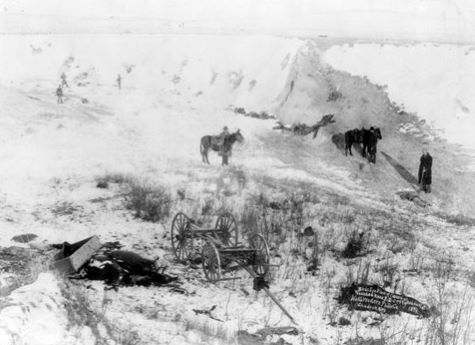
White’s filmmaking initially helped him escape the weight of Wounded Knee’s histories—his first film was a short about New Zealand, inspired by his love of Lord of the Rings, that was shot on his father’s hunting camera. But if stories and films offer creative and intellectual freedom, the heavy histories, places, and experiences from which they spring also inspire him and keep him grounded here, rather than setting out for Los Angeles or Brooklyn. White wants one of his future projects to be about the dueling legacies of Wounded Knee—the massacre and the liberation. He hopes to focus on the lesser-known aspects of these struggles, and at Red Cloud, he has access to archival photos of memorializations of the carnage as well as images of some ceremonies held here over generations. He also intends to put the lives of the women in AIM, like Madonna Thunder Hawk, who are often overlooked in favor of men, at the center of the narrative.
On Sunday, as we ascended the hill at Wounded Knee, White told me about his relative Swift Bird, who was killed and buried alongside Big Foot and the Ghost Dancers. At the top of the hill, we happened to run into Jeff Moreno, the son of American Indian Movement (AIM) leader Dennis Banks, who helped lead the takeover. “We were the prophets, the messengers, the fire-starters,” Banks wrote in his autobiography, Ojibwa Warrior, cowritten with Richard Erdoes. “Out of AIM came a new breed of writers, poets, artists, actors, and filmmakers.”
“We figured we’d come here and pay our respects,” Moreno said, accompanied by his wife Melinda and daughter Jordilyn, whose hair was tied in pigtails.
After Moreno departed, White and I spent a few minutes there, surveying the ground, still searching for meaning.
“It gets me really reflective—just the different things that our people have been through,” White said. “I’m constantly reminded about things like this, events like this, that really shaped our history, shaped our communities, and how that’s evolved into some of the challenges that we face today.”
Wounded Knee holds both the bloody abyss and the unconquered vision of this continent’s First Peoples. It is the site of a massacre and of the Independent Oglala Nation. Both stories are ours equally: genocide and its aftershocks in the climate; the Ghost Dance, the American Indian Movement, and the campaign against the Keystone XL pipeline. Some days, I feel we have been condemned to the most wretched fate of any people—a slow, painful, and intergenerational death. But then, I see our people rising. And sometimes I see both at once, in the same frame, and in the same place. As the climate breaks down, we remain caught between both legacies of Wounded Knee—genocide and freedom—the horror of the massacre and the dream of the massacred.
READ ENTIRE ARTICLE AT HARPER’S
The Heartbeat of Wounded Knee
“Our cultures are not dead and our civilizations have not been destroyed. Our present tense is evolving as rapidly and creatively as everyone else’s.”
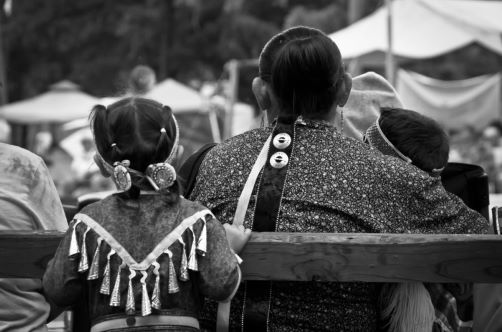
This book tells the story of what Indians in the United States have been up to in the 128 years that have elapsed since the 1890 massacre of at least 150 Lakota Sioux at Wounded Knee Creek in South Dakota: what we’ve done, what’s happened to us, what our lives have been like.* It is adamantly, unashamedly, about Indian life rather than Indian death. That we even have lives — that Indians have been living in, have been shaped by, and in turn have shaped the modern world — is news to most people. The usual story told about us — or rather, about “the Indian” — is one of diminution and death, beginning in untrammeled freedom and communion with the earth and ending on reservations, which are seen as nothing more than basins of perpetual suffering. Wounded Knee has come to stand in for much of that history. In the American imagination and, as a result, in the written record, the massacre at Wounded Knee almost overnight assumed a significance far beyond the sheer number of lives lost. It became a touchstone of Indian suffering, a benchmark of American brutality, and a symbol of the end of Indian life, the end of the frontier, and the beginning of modern America. Wounded Knee, in other words, stands for an end, and a beginning.
What were the actual circumstances of this event that has taken on so much symbolic weight?
In 1890, the Lakota were trying to make the best of a bad situation. Ever since the Battle of the Little Bighorn in 1876, the U.S. government had been trying to solve the “Indian problem” on the Plains with a three-pronged approach: negotiation and starvation in addition to open war. Open war on its own had not been going too well. Led by Red Cloud, Crazy Horse, American Horse, Ten Bears, and Sitting Bull, the Plains Indians had won such decisive victories that they had forced the government to the treaty table, not the other way around. This resulted in the second Treaty of Fort Laramie in 1868 and secured a large homeland for the Lakota in southwestern South Dakota and northern Nebraska.
The massacre at Wounded Knee became… emblematic. It neatly symbolized the accepted version of reality — of an Indian past and an American present.
But the terms of the treaty were violated by the United States shortly thereafter, when gold was discovered in the Black Hills. In response, the Lakota attempted to throw out the gold-seekers and enforce the terms of the treaty. This is what led, directly, to the Battle of the Little Bighorn, where Custer and the Seventh Cavalry were wiped out. During the final hours of the battle, the Lakota and Cheyenne dismounted, put away their guns, and killed the remaining cavalry with their war clubs and tomahawks in a ritual slaughter. Some Dakota women, armed with the jawbones of buffalo, were given the honor of dispatching the soldiers with a sharp blow behind the ear. After that rout, the U.S. government switched tactics. Instead of confronting the Indians head-on, it encouraged widespread encroachment by settlers (one sees the same tactics in play in the West Bank today), reneged on treaty promises of food and clothing, and funded the wholesale destruction of the once vast buffalo herds of the Plains. The hides and bones were shipped east, the hides for use in industrial machine belts, decoration, blankets, and clothing, the bones and skulls for fertilizer and china. It is estimated that by the late 1870s about five thousand bison were being killed per day.
READ ENTIRE ARTICLE AT LONGREADS
Ghost Dancers Past and Present
Thinking beyond the dichotomies of oppressor and victim reveals the human urges that inspire so much of our expressive culture.
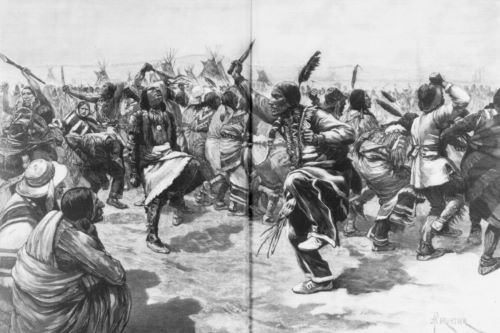
Having consulted the assigned materials, my students in the second half of the US History survey have no trouble supplying the basic information about the Ghost Dance. Introduced by a Paiute holy man named Wovoka and performed by groups of western plains Indians, the Ghost Dance was “a ritual,” “a ceremony,” “a belief,” “a superstitious behavior.” The dead warriors would come back, the game would return, the whites would be buried underground, and all that was lost would be restored. Some of the dancers wore “sacred garments,” “decorated with special symbols.” Some believed that when performing the ritual, bullets would not penetrate these garments.
Students go on being students. Most report dutifully and await for the next instruction. The Ghost Dance doesn’t seem to knock them in the head the way it does me. Of all the horrors that populate US History since 1865, few seem to me as unrelentingly sad. If one was ever tempted to see religious belief as an escape from reality, borne of the sheer desperation that comes from looking extinction in the face, what better evidence than the Ghost Dance might one find?
Therefore, it’s hard for me to check the Ghost Dance off the items-to-cover list and leave it at that. I don’t want to leave the ghost dancers in the pathetic place that history seems to assign them. I don’t think my reaction is all that unusual. Let’s not depict certain classes of folk as victims all the time, it’s sometimes argued; let’s point out instances of defiance, of collective and individual agency. The losers of history aren’t always losers. Sometimes they defy power. Sometimes they fight back just as nobly as the winners do.
In the case of the Ghost Dance, I’d like to try a different tack. I don’t want to think in terms of oppressors and victims, of winners and losers, but more generally of human beings and the kinds of things they do. The western Indians had tried everything. They tried resisting, and they tried assimilating. They tried signing treaties, and they tried giving up and asking for protection. If the Ghost Dance is where a people arrive when they’ve tried everything and nothing worked, they haven’t for a moment stopped being human. The Ghost Dance is the kind of thing human beings do.
READ ENTIRE ARTICLE AT THE SOCIETY FOR U.S. INTELLECTUAL HISTORY
The Gods of Indian Country
How American expansion reshaped the religious worlds of both settlers and Native people.
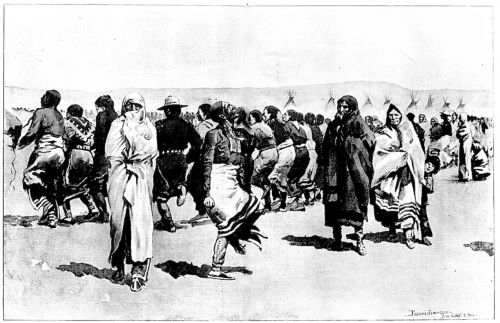
Historians of American religions have rightfully turned away from Sweet’s conclusions. Indeed, since the 1960s the study of American religions has been transformed from a sleepy corner of the historical profession to what commentators have identified as an increasingly popular subfield. The scholarship now includes excellent monographs on long-neglected groups, oft-overlooked sources, and is shaped by theoretical insights from critical work on religion, race, gender, ethnicity, and labor. During the field’s much-needed transformation, the frontier faded into the background, at least for a time.
A new generation of scholars has returned to the frontier, bringing with them all the critical tools now available in the subfield. Rather than asking how religion fueled American expansion, they have investigated how the experience of expansion reshaped American religions, those practiced by both settlers and Native people. It’s within this new mode of writing that I set out to study the religious transformations prompted by the invasion and defense of lands inhabited by Kiowa Indians and later designated Indian Territory (and eventually Oklahoma) by Americans.
Americans got their first long-term experiences on Kiowa lands and engagements with Kiowa ritual activity when Quakers were assigned to administer the Kiowa, Comanche, and Apache Reservation in 1869. Ready to engage their fellow humans trapped in “heathen darkness,” Quakers distributed food rations, organized schools, and held meetings for worship among the reservation’s more than 5000 Native occupants. Quaker workers frequently mentioned Kiowa “superstition” as the greatest obstacle to their acculturation of Euro-American habits and assimilation into American life.
READ ENTIRE ARTICLE AT NOT EVEN PAST
Utopian Experiments
Exploring the Midwest’s Forgotten Utopian Communes
The American Midwest was once a site of radical experimentation for various communitarian groups. What has become of their legacy?
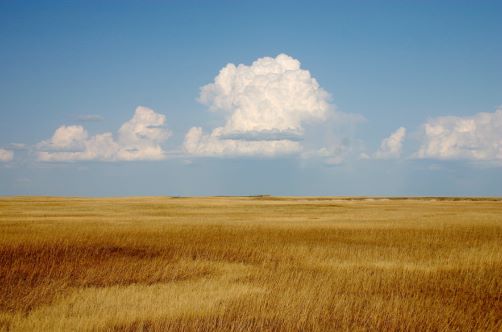
Orson S. Murray founded Fruit Hills in 1845, near present-day Loveland, inspired by his personally-held principles of atheism, socialist feminism, and economic cooperation. Murray hailed from the radical abolitionist movement, writing in The Struggle of the Hour that slavery “makes men into brutes, driving and being driven, crushing and being crushed.” He railed against church, state, and property as “a trio of monsters” in his newspaper, The Regenerator, and cofounded a group called the Society for Universal Inquiry and Reform. Fruit Hills was one of several efforts by Universal Reformers to translate theory into a practical utopia on the rural American frontier.
Murray once wrote that “Bibles and Constitutions are only the necessities of ignorance—things to be changed—to be outgrown and displaced by better things.” Change seems to have gotten the best of Fruit Hills, however; the commune collapsed within seven years. “All the necessaries of life could be raised in abundance,” wrote one contemporary observer, “but the laborers were mostly unused to agriculture and in many instances lacked industry.” From the vantage of the Meinecke lobby, no definition of success seemed generous enough to encompass the project’s fate.
This story is fairly typical. Inland America is pocked with the unmarked graves of communitarian utopias—primitive socialist and communist experiments—that tried to rebuild the world on what was assumed to be virgin soil. Ephrata, Pennsylvania; Germantown, Tennessee; Utopia, Ohio; Brentwood, New York; Iowa’s Amana Colonies: these and many other towns were originally settled by communalists with lofty visions of abolishing private property, quashing material inequity, and transcending divisive individualism.
It makes sense that those seeking the fringe of a New World might be driven by powerful ideological convictions. But while European settlers dreamed of abolishing old hierarchies in the map’s blank spots, these blanks were always a fantasy. The allure of self-directed freedom in unsullied lands largely folded back into a vanguard of dispossession and genocide, with naïve radicals paving the way for the extension of the very structures they had hoped to escape. Their intentions complicate the mythic image of a land settled by rugged individualists, but their ultimate fates suggest bleak prospects for liberation conceived as escape, rather than transformational conflict.
With my AC in working order, I pressed on from Loveland to survey what remained of the utopians’ dreams.
READ ENTIRE ARTICLE AT THE BAFFLER
The Communal, Sometimes Celibate, 19th-Century Ohio Town That Thrived for Three Generations
Zoar’s citizens left religious persecution in Germany and created a utopian community on the Erie Canal.
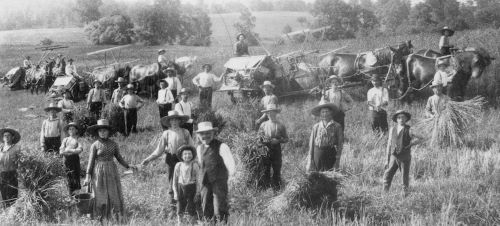
Quaint, rural, and hardworking, Zoar, Ohio, is the kind of place that wasn’t supposed to thrive in America.
The citizens of Zoar came to this country as religious dissenters in the early 19th century. In unorthodox fashion, they formed a communal society where all wealth was combined: men and women alike pooled their labor, their wealth, and their belongings for the benefit of the whole.
The community thrived. In a nation dedicated to individualism, Zoar’s citizens built a first-of-its-kind economic system, and persevered for three generations, becoming one of the longest-lasting communal societies in U.S. history. That Zoar was allowed to succeed, and was even admired for its efforts, serves as a reminder that America has often celebrated differences that fly in the face of mainstream beliefs.
Many immigrants to early 19th-century America had come to acquire property and better their economic future. But the Zoar dissenters—like the earlier Puritans who fled 17th-century England—came here to worship their God in their own way, and not have to conform to the strict rules of the state-run Lutheran Church.
These believers came from the German kingdom of Württemberg, and were known as Radical Pietists because they thought the established Lutheran church’s rules were too stringent and dogmatic. They desired a simple faith, one harking back to the early Christian Church, and personal relationships with God without the interference of ministers and church hierarchy.
READ ENTIRE ARTICLE AT WHAT IT MEANS TO BE AN AMERICAN
The Invisible Landscape: Tracing the Spiritualist Utopianism of Nineteenth-Century America
The hidden history of Utopian Socialism and its close relationship with cultures of esoteric spirituality in the nineteenth-century United States.
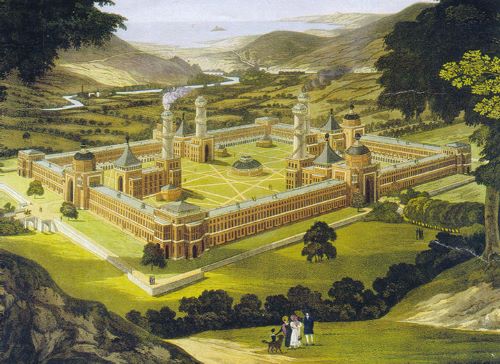
Take the highway east from Cincinnati, Ohio, and in no time the city with its lights and skyscrapers will fade in the rearview mirror, the dense concrete world giving way to the sporadic outcroppings of suburban life and then the wide openness of the American rural landscape. Lanes will be subtracted one by one until only two remain, one going in each direction, and to the north will be small rolling hills and to the south, snaking along the road, the waters of the Ohio River. Around forty miles or so and one will pass through a small town – an “unincorporated community”, as the US census puts it – with the curious name of ‘Utopia’. Blink and you’ll miss it: a few houses, a gas station, a historical marker. Get out and walk around and you might come across a hole in the group lined with ancient cut rocks; it’s the entrance to an underground church, one of the last traces indicating that Utopia was a major crossroads in what we might describe as America’s invisible landscape.
I have to confess to having pilfered this term from elsewhere. It’s actually the name of a book, published in 1975, by famed psychonauts Terence and Dennis McKenna. They use it to describe “an alien dimension all around us” that we can obtain glimpses of, if only obliquely, through tools such as mystical practices and the use of hallucinogenic drugs.1 This seems like a far cry from somewhere like Utopia, Ohio – but it seems appropriate to me on several levels. On one level, it’s because the history that produced Utopia is utterly alien to the experience of American life as we know it today, and actively challenges many of the core presuppositions that are currently baked into the construct of American identity. On another level, this alien world comes far closer to the turbulent slipspace that the McKenna brothers moved in: interweaving zones of fantastical possibilities encounters with spirits and an active eschatological element.
Something that becomes quickly recognizable about the invisible landscape is the elusiveness of a starting point. Unfolding across time and space in a way that denies a clear historical shape, it remains impervious to a fixed narrative. It is instead a bewildering strand of minor histories and counter-histories, unexpected slippages and surprising convergences – but if one is to pick a spot to act as an anchor, and for us here Utopia is just such a spot, then certain lines become clearer. From this forgotten location in Ohio, we unwind, as one is oft to do in tracking American history, back to the mythologized Old World – and in this case, France, and in particular, to the figure of Charles Fourier.
READ ENTIRE ARTICLE AT COSMONAUT
This Small Indiana Town is a Hotbed of Utopianism
New Harmony has attracted eccentric spiritual groups, social reformers, intellectuals, and artists.
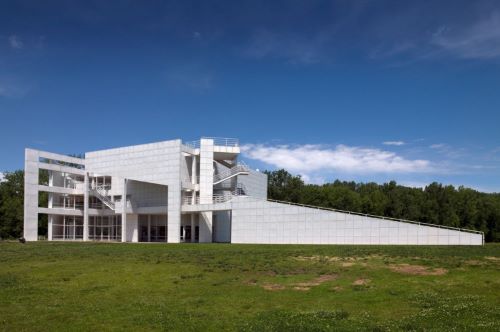
When Melissa Flower, a theater director, visited New Harmony, Indiana, for the first time earlier this year, she thought she’d stepped through the looking glass. “I felt like I was in Alice in Wonderland,” she says. “When people, including me, come here, they talk about it like it’s a magical place.”
The small town, located near Indiana’s southernmost tip, is not unlike many American towns. It has a main street lined with historic brick buildings, some painted in lively colors like San Francisco’s Victorians. There are trees and flowers everywhere, and plaques reminding you that it’s a historic site. And then there’s the hedge labyrinth and roofless church—hints that this isn’t just any ordinary rural community. New Harmony is a hotbed for utopians.
From the early 19th century until today, New Harmony has attracted people who go against society’s grain. First, religious separatists who dedicated their lives to God and preparations for the second coming of Christ, then secular reformers who believed a society based on equality and intellectual pursuits would lead to a better world for everyone. While these experimental communities failed, some of their utopian philosophies are still very much alive among New Harmony’s present-day artistic patrons.
But like many small towns, New Harmony is also experiencing depopulation. Flower came to the community not as a tourist, but to scout the area with the goal of recruiting performing artists to live and work there. The question remains: Can New Harmony thrive while retaining a connection to its utopian roots?
How Cults Made America
A new book argues that, politically, messianic movements were often light-years ahead of their time. But at what cost?
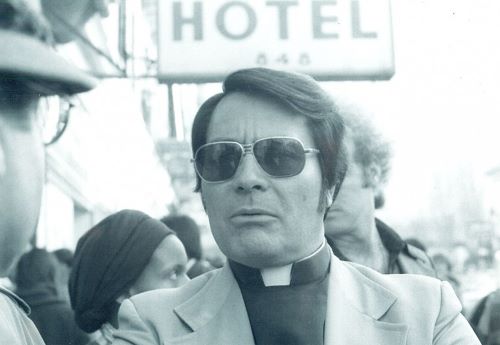
Most people have never heard of Cyrus Teed, which is a shame. He was born in Trout Creek, New York, in 1839. As a boy, he worked along the Erie Canal, experiencing some of the worst labor conditions that nineteenth-century America had to offer. As Adam Morris recounts in a new book, “American Messiahs,” Teed soon became a staunch anti-capitalist, and he spent much of his life trying to abolish wage labor entirely. This didn’t prevent him from pursuing a number of business ventures. At one point, he ran a mop factory; at another, he hawked something called an Electro-Therapeutic Apparatus, which provided its owners with the putative health benefits of mild, recurrent electrocution. Teed was a student of “eclectic medicine,” a branch of healing that rose in response to widespread—and frequently justified—fears of doctors. In Teed’s day, you didn’t become a surgeon if you didn’t have the stomach to wield a bone saw.
Teed also believed that he had, living within him, a spirit of some sort. He would go on to proclaim that this spirit had once empowered Enoch, Elijah, and Jesus. The New York Times headline wrote itself: “A Doctor Obtaining Money on the Ground That He is the New Messiah.” Teed called himself Koresh, a transliteration from the Hebrew version of the name Cyrus, and criticized mainstream Christianity as “the dead carcass of a once vital and active” faith. Then, in the eighteen-seventies, he founded a commune, Koreshan Unity, and announced that “the new kingdom” would be formed through women’s emancipation—he envisioned a group of celibate, bi-gendered beings—and the destruction of monopoly capitalism.
Teed is one of the case studies in “American Messiahs,” in which Morris exhumes the lives and beliefs of a linked procession of self-appointed prophets who tried to upend American religion—and the American way of life. They did so by attracting thousands (sometimes tens of thousands) of followers while preaching a version of what Morris calls “apostolic communism,” which has a clear basis in scripture. According to Acts 4:32, the first Christians, in Jerusalem, “were of one heart and soul, and no one said that any of the things that belonged to him was his own, but they had everything in common.” The typical history of Christianity will tell you that this passage has been influential in certain monastic communities but scarcely anywhere else.
Morris is out to prove this account wrong, and, in many ways, he succeeds. As it happens, a resilient strain of Christo-Marxist thinking has endured in America. Its adherents have almost always been celibate, anti-marriage, anti-family, relatively enlightened on matters of gender and race, and unblushingly communistic. The Americans who spearheaded these movements had another commonality: they all believed, in one manner or another, that they were living gods. For Morris, this fact has too often been exploited as an excuse to dismiss a radical tradition. “Far more than for their heretical beliefs,” he writes, “the communistic and anti-family leanings of American messianic movements pose a threat to the prevailing socioeconomic order.” In other words, these men and women were, morally speaking, light-years ahead of their time—and that’s why we don’t take them seriously.
READ ENTIRE ARTICLE AT THE NEW YORKER
The Cult Roots of Health Food in America
How the Source Family, a radical 1970s utopian commune, still impacts what we eat today.

The sun is dipping below the Santa Monica Mountains when Venus Aquarian stands up. She’s resplendent, dressed in royal purple velvet and dripping with crystals, as the dying light catches the halo of white hair framing her face. Next to Venus stands Isis Aquarian, dark eyes and extended arms both pointed to the heavens. Galaxy Aquarian, seated to my right, also rises.
The gentle tremor of a gong washes through the 40 guests seated in a field around a long wooden table strewn with halved papayas, clusters of grapes, and bunches of flowers. Servers in white linen robes glide past with baskets of flatbread accompanied by ivory pyramids of raw cultured butter. The vibe is somewhere between Midsommar and the Sunset Strip, circa 1972.
The Aquarians lift and lower their arms in unison, chanting as they turn to each cardinal direction: “Bless all to the East, YaHoWha! Bless all to the West, YaHoWha! Bless all to the North, YaHoWha! Bless all to the South, YaHoWha!”
READ ENTIRE ARTICLE AT ATLAS OBSCURA
The 19th-Century Cult That Gave Rise to an Incel Assassin
A new book links President Garfield’s killer to the free love and religious fervor that gripped Oneida, N.Y., in the late 1800s.
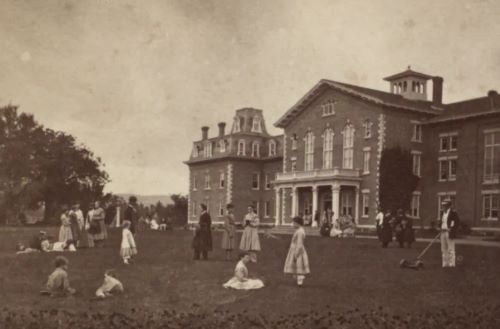
What do an experiment in free love, a renowned newspaper editor with a penchant for the occult, and a dour — then murdered — president have in common?
That’s the question that the prolific historian Susan Wels poses in “An Assassin in Utopia,” which explores the interwoven fates of the radical preacher John Humphrey Noyes, the media impresario Horace Greeley and the doomed James A. Garfield, who was shot four months into his tenure as president of the United States and died of infection two months later. It spoils none of the rollicking pleasures of the book to reveal that the answer is a proto-incel named Charles Julius Guiteau, so let’s set him aside for the moment.
Instead, we can start as Wels does, with the spiritual awakening of Noyes and his ensuing desire to establish a model of communal living based on audacious religious doctrine. Among his precepts: Monogamous relationships are a perversion of God’s will; marriage is a group effort, involving numerous sexual relationships with an unlimited number of partners; men and women alike should work and participate in all household responsibilities. Additionally, it is the sacred task of older men and women to “initiate” the post-pubescent, and birth control is the sole responsibility of men — who are expected to become proficient in the tantric art of “male continence.”
From the start, Noyes horrified more conventional Christians. But the once-timid theologian had graduated from Dartmouth and Yale and come to the same conclusion that countless alumni have since: He was “a perfect human being, incapable of sin.” Noyes launched two newspapers to spread his ideology, financed by his heiress wife, Harriet. He established what came to be known as Oneida in 1848, having acquired 23 acres of land from one of his disciples.
READ ENTIRE ARTICLE AT THE NEW YORK TIMES
The Sects That Rejected 19th-Century Sex
Why three religious groups traded monogamy for celibacy, polygamy, and complex marriage.
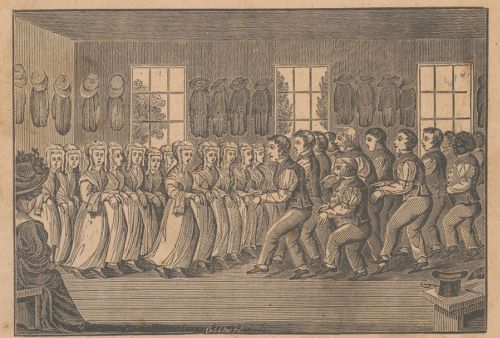
Disconsolate after his beloved’s marriage to another man in 1837, a young seminarian named John Humphrey Noyes declared in a bitter, anti-love poem to his ex:
I will not give you back your heart,
I’ve wooed and fairly won it,
And sooner with my life I’ll part,
You may depend upon it.
Not content with mere verse, Noyes would go on to turn his emotional anguish into a theological critique of the institution of monogamous marriage itself (or as he once called it, “Egotism for Two”). Condemning monogamy as “simple” and replacing it with a more heavenly, polyamorous version that he called “complex marriage,” in 1848 he founded a religious sect based on his teachings: the Oneida Community in upstate New York. There, people would be stripped as much as possible of their worldly “I-spirit,” and have it replaced with the godlier “we-spirit” of genuine Christian fellowship. Only with this kind of radical reorientation, Noyes held, could believers experience community, family, and marriage in the way that God had intended them.
You may be feeling down about a lack of romantic fulfillment or a recent break-up this Valentine’s Day, or its succeeding “Singles Awareness Day.” But as Noyes’ story illustrates, you are hardly alone, among your contemporaries in 2022, or throughout human history. Three 19th-century American sects—the Oneida Pantogamists as well as Shaker celibates and Mormon polygamists—waged wars against the so-called selfishness of monogamous marriage. All viewed romantic exclusivity as sinful, a hindrance to creating a more universal love for a community of fellow believers.
Monogamy, of course, won out. Experiments like Noyes’ commune now seem distant, strange, and historically specific. And yet, there is something familiar and universal in them. They revolved, as we still often do, around heartbreak. What can they teach us about love and sex today?
READ ENTIRE ARTICLE AT ZÓCALO PUBLIC SQUARE
In the Image of Jonestown
In our flattened historical imagination, pictures of atrocity and those of progress can coincide in unsettling ways.
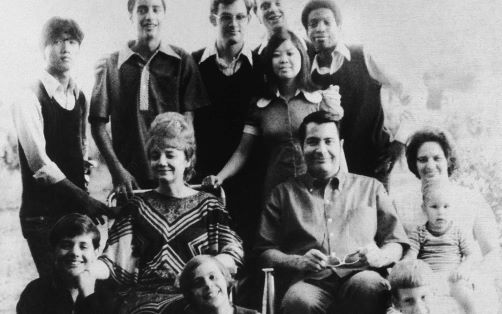
Just months before they set off for the jungles of Guyana, Jim Jones and the congregation of the Peoples Temple stood in front of the International Hotel in San Francisco, a single-resident-occupancy building in what was then called Manilatown. Stripped of context, the images from that night could serve as a type of nostalgia porn for the radical ’70s. The fight to save the hotel and its population of mostly impoverished, elderly Filipino men had been taken up by a coalition of Asian American, gay, and student activists. The Peoples Temple, whose congregation was mostly Black, provided foot soldiers for a prolonged confrontation. When the police finally arrived to evict the tenants, they were met by a multiracial, working-class coalition who put their bodies on the line to save housing for the indigent.
Everyone knows the plot twist at Jonestown. The set-up is assumed: A charismatic leader entices nearly a thousand impressionable young people to follow him into the jungle. The center does not hold. Nine hundred bodies are laid out for the obligatory helicopter shot. All the other gaps are filled in with the assumption that all the things Jones preached, whether apocalyptic gospel, communism, or equality among the races, will go bad when taken to extremes. This may well be the correct way to think about Jones, a mass murderer who led a mostly Black congregation to its death, including members of his own “rainbow family.”
“Jonestown fulfilled the most dire warnings of its opponents,” write John R. Hall, Philip D. Schuyler, and Sylvaine Trinh in their book Apocalypse Observed. “After the murders and mass suicide, Peoples Temple became the quintessence of the ‘cult,’ stereotypically portrayed as an organization that drains both property and free will from its members and ‘brainwashes’ them into a ‘group mind.’” There are certainly cults that do these things, but Hall and his coauthors’ scholarship makes an important distinction between Jones, the con-man preacher, megalomaniac, and murderer, and his congregation. The latter “sought to participate in an integrated community that transcended persistent racism in the United States. In a society where the practice of religion is largely segregated from everyday socioeconomic organization and practice, the group infused its members’ working lives and social relationships with new ‘religious’ meaning.”
Religious lessons about loving one’s neighbors and caring for the less fortunate, in other words, had been tangibly expressed by the Peoples Temple. Something similar could be said about the church’s ideas of socialist liberation: Well before Jones ever stood in front of a congregation, the left had sought what, in modern terms, would be called a “multiracial, working-class movement” built on solidarity and shared struggle. What that actually might look like has been clouded by history, in no small part by efforts to cast any type of communal living or emancipatory action as yet another Jonestown. I am not trying to make excuses for Jim Jones here or even to entirely separate the flock from its doomsday apostle—Jones did not act alone in Jonestown, and the killing of children, in particular, had to be carried out by loyal followers. Nor do I wish to argue that Jonestown’s role as a cautionary tale comes entirely from some unfair twisting of its intentions—918 dead are 918 dead.
But I first encountered the photos from the International Hotel a couple of years ago, while doing research for my upcoming book. While I recoiled at the sight of Jones with his dark sunglasses and bouffy hair, these were exactly the types of pictures that work well in the turbine of online historical associations: See? There have been examples of multiracial, working-class solidarity. The association with Jones, of course, made them unusable, but I wondered why there were so few obvious replacements.
READ ENTIRE ARTICLE AT THE NATION
The Last Shakers?
Keeping the faith in a community facing extinction.
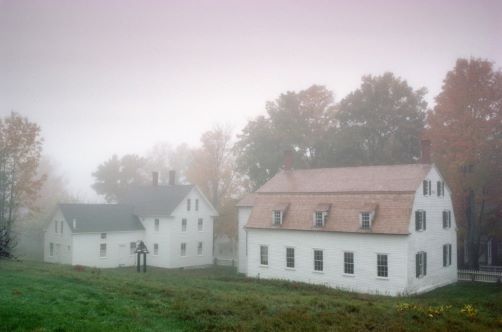
Sabbathday Lake, Maine, is home to the last community of Shakers on earth. Their sect, formally known as the United Society of Shakers, is well over two hundred years old. When I visited Sabbathday Lake in the summer of 2017, I met the only two Shakers who remained: Arnold, blue-eyed and stooped, aged sixty-two, and June, small and shy, aged eighty.
Arnold and June live together in the village Dwellinghouse, but sleep in separate beds. They are not married, nor are they lovers. They pray, read Scripture, and sing. They eat together but don’t take communion; to them, every meal is the Eucharistic feast. They maintain their land and buildings, and though Arnold can do some of the physical work, they must also hire outside help. Arnold and June use computers and cellphones—the Shakers, unlike the Amish, are not averse to technology. They invented paper seed packets, the circular saw, the flat-bottom broom, and clothespins.
Arnold and June are celibate, own property in common, and confess their sins to each other. These are the essential “three Cs” of the Shakers, modeled on the chaste, communal life of Christ. To become a Shaker, you must be debt-free: no mortgages or student loans. You must also be a pacifist. Shakers are wary of nitpicky dogma, and their theology is simple: God is love; Christ’s return is experienced spiritually by anyone open to the “anointing spirit of God.” Shaker faith seems to be more an emulation than a rigid creed. Arnold and June, like the Shakers before them, believe they have found the best way of living, a literal heaven on earth.
Most of the “world’s people” know Shakers for their woodwork: cabinets, chairs, tables. Shaker artifacts are displayed at New York’s Metropolitan Museum of Art. But Shakers are also known for numerous scratch recipes, and a Shaker song, “Simple Gifts,” inspired Appalachian Spring. James Fenimore Cooper, Charles Dickens, Herman Melville, and Nathaniel Hawthorne all wrote about Shakers; Ralph Waldo Emerson was an admirer.
At its peak before the Civil War, the Shaker population numbered around five thousand, spread across ten states in the east and midwest. By 1900, there were 855 practicing brothers and sisters. The population was aging—and dying. Celibate, Shakers couldn’t bear children into their faith; they had to rely on converts, and conversions were declining too. While villages had long taken in orphans or children from destitute families, few of those charges remained after reaching adulthood. Eventually, as states began to pass stricter laws, the Shakers, as a non-family unit, lost the right to adopt.
Over time, the loss has been compounded by a reluctance to evangelize. Shakers don’t knock on doors or preach fire-and-brimstone. Instead, they wait, hoping converts will come. Sometimes, today, people do inquire, attracted to Sabbathday Lake by its austere, contemplative lifestyle, making pilgrimages to be evaluated as novices. But nobody has stayed. Either the Shakers said no, or the candidates left.
READ ENTIRE ARTICLE AT COMMONWEAL
Jonestown’s Victims Have a Lesson to Teach Us, So I Listened
In uncovering the blackness of Peoples Temple, I began to better understand my community and the need to belong.
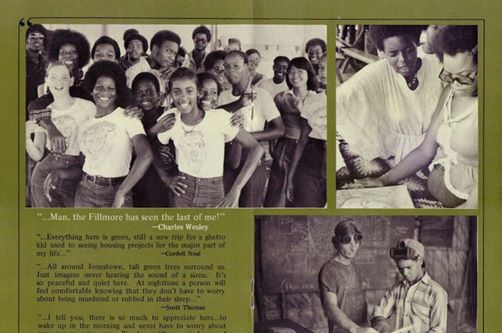
I was home in San Francisco earlier this year when my mom told me that our family had a connection to Peoples Temple.
We had just finished brunch and were crossing Divisadero, one of the main thoroughfares of the Western Addition neighborhood, also known sometimes as the Fillmore, in which we had both been born and raised. I think I must have prompted her on the subject, asked her if she’d realized the 40th anniversary of Jonestown was coming up in November and if she had known anyone who died there. That’s when she turned to me in the cross walk and said quite matter-of-factly: “Of course.”
Then she nodded her head north and told me where the church’s headquarters had been, a short walk from us. I stood next to her, a little shocked, a little eager, a little worried this was all I’d get from her. My mom’s prone to yawn off historical moments, figuring if you’re lucky enough to live through something, there’s no sense in talking about it.
She didn’t grow up in a particularly religious family—my grandmother had been something of a rebel, ditching her own parents’ thrice-weekly churchgoing for the local pool halls—but one of my mom’s close friends from junior high, Francine Mason, wouldn’t stop nagging her about a new church she found. It was a welcoming church for all people, it proclaimed to see all people, black or white, as equal, Francine had told her.
It was an era of opting in, in a neighborhood where there was no shortage of things to opt into. There was the rock scene at the Fillmore Auditorium, drug addled hippies in the Haight-Ashbury. The Black Panthers had an office near Divisadero. But Peoples Temple, the church my mom’s friend was so into, was bigger and and more politically influential than nearly everything else in the city in the mid- to late-’70s. Beyond that, part of the appeal was that it didn’t make you wait for the afterlife to find salvation. If the gas company was skimping on service but still badgering you about the bill, members would coordinate letter-writing campaigns. If your grandmother couldn’t afford retirement, the church provided free housing and food on a pristine patch of land two hours north.
READ ENTIRE ARTICLE AT MOTHER JONES
The Oneida Community Moves to the OC
The Oneida Community’s Christian form of collectivism was transported to California in the 1880s, when the original Oneida Community fell apart.
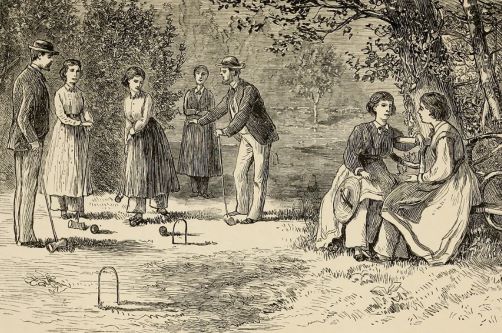
Bible communism was the governing principal of the Oneida Perfectionists, the most successful of the American utopian movements. This Christian form of collectivism—no sin, no private property, no monogamy—was transported to California in the 1880s, when the Oneida community broke up. As the historian Spencer C. Olin, Jr. explains, some of the founders of Orange County were members of this “most radical social experiment in American history.”
Christian Perfectionists believed they were born without original sin, a particularly outlandish notion in the eyes of a nation that was still largely Protestant. John Humphrey Noyes, the most renown of all the Perfectionists and the founder of Oneida, argued that this sinless state was a gift of God and, in his own words, “canceled out his obligation to obey traditional moral standards or the normal laws of society.”
And disobey Noyes did. His notion of “complex marriage,” or pantagamy (essentially, everybody is married to everybody) raised a lot of nineteenth century eyebrows, as well as the pitchforks of moralists. Yet for three decades, the Oneida community, numbering only about 300 at its peak, prospered in upstate New York.
READ ENTIRE ARTICLE AT JSTOR DAILY
Orphan Utopia
The story of a spiritual visionary who in 1884, set out to create a colony of orphans in the New Mexico desert.
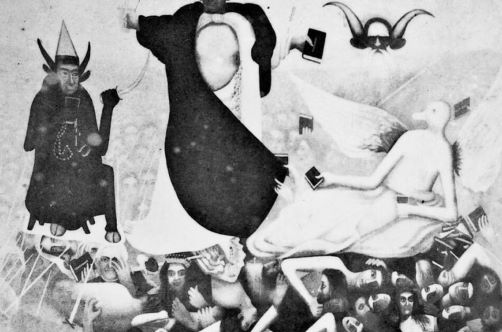
Reproduction of an undated painting by John Ballou Newbrough lost in a flood while in storage in El Paso, Texas. The complex iconography of the painting—said to be seventeen feet tall and ten feet wide—depicted a central tenet of Oahspe’s theology: that Christianity was founded when a powerful spirit usurped and distorted the teachings of the Jewish prophet Joshu/Jesus. Sometimes referred to as The Three Worlds, the painting depicts the three realms outlined in Oahspe—the work’s lower third, where the skeletons can be seen, depicts Corpor; the false God-Christ figure occupies the middle region, called Atmospherea; and the now-faded upper portion represents Etherea, the higher heavens. Thanks to Leslee Alexander for her assistance with the captions for this article.
When the angels appeared to John Ballou Newbrough early one morning in 1881, he was nothing if not well prepared. A dentist and Spiritualist, he had spent the last ten years purifying himself for supernatural contact by abstaining from meat, bathing twice a day, and rising before dawn. The visit was expected.
The angels wanted him to buy a typewriter, a newfangled device—Newbrough described typing as writing “by keys, like a piano” in a letter to the Boston Spiritualist journal The Banner of Light—that would allow him to transcribe their account of the world’s true spiritual history.1 He obeyed, and for the next fifty weeks the angels visited him in his New York City apartment every morning before sunrise, taking control of his hands in sessions that lasted exactly fifteen minutes. By the end, Newbrough had produced a nine-hundred page manuscript called Oahspe: a history of world religions that exposed their lies and elucidated their fundamental interconnections.2
The dictating angels were nothing if not thorough. To supplement the text, they provided Newbrough with images of religious leaders, which he painted in the dark. Among those reproduced in the 1891 edition of Oahspe are the austere, mustachioed Zarathustra, with a cherub grinning behind his left shoulder, and a serenely smiling Confucius, hair stroked by a ghostly figure while an enormous eye floats in the clouds above him. These luminaries appear alongside diagrams and illustrations, everything from language trees to astronomical models to illustrations of ancient temples. (Newbrough claimed to have copied them, according to the angels’ instructions, from technical books.)
READ ENTIRE ARTICLE AT CABINET
The Complex Marriage Complex
A descendant of the Oneida Community reflects on the famous 19th century experiment in managing sexual freedom.
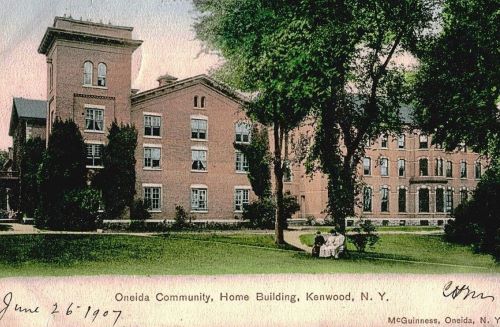
This past spring, for the second time in six years, the New York Times Magazine ran a cover story introducing its readers to the virtues of open marriage, or, as its practitioners sometimes call it to distinguish it from mere adultery, “ethical non-monogamy.” Both stories went about this introduction in much the same way: They took their reluctant, prudish reader by the hand and assured him that they appreciated his squeamishness about infidelity, but if he would just open his mind a bit, he might soon find himself opening up his marriage as well.
The great problem with monogamous marriage, as divorce statistics illustrate, is that it is difficult to sustain one. Some or even most of us are not naturally content with just one life-long sexual partner–cue the disquisitions on evolutionary biology and the practices of exotic tribes in the Amazon or Micronesia–and that arrangement is unjustifiably patriarchal and sexually repressive in any case. But according to both stories, we can rescue the floundering American family and liberate ourselves from artificial social constraints in one stroke by making marriage a more flexible arrangement, one that is capacious enough to allow for a lot more sex with a lot more people. That way, fewer married people will be condemned to suffer unfulfilled desires or to break up their families in efforts to fulfill themselves. Open marriage is, as Mark Oppenheimer cleverly concluded in his 2011 New York Times Magazine essay on the subject, an essentially conservative proposition, just one that also happens to be enticingly new and radical.
Only it is not quite so new and perhaps not so radical as some of its proponents might hope. Experiments in free love and sexual communism, and indeed communism of all other kinds, have been occurring in America’s nooks and crannies since the early nineteenth century. Any impartial observer of American history must admit that eccentric, separatist communities devoted to violating nearly every social taboo are just as traditionally American as monogamous marriage itself. But just as often as they have cropped up, these open-marriage intentional communities have failed.
In her new book, Oneida: From Free Love Utopia to the Well-Set Table, University of Southern California professor Ellen Wayland-Smith delves into the history of one of the longest lived of these efforts, the Oneida Community in upstate New York. Founded in 1848 in the ferment of the Second Great Awakening by the self-appointed Perfectionist prophet John Humphrey Noyes, Oneida grew out of Noyes’s contention that the Second Coming had already come, unnoticed by all but him, so men were now capable of moral perfection and even immortality in this life. The requisite means to such perfection was Noyes’s theology of “Bible Communism”–total communalism in property as well as in sexual partners. Sustaining itself on the profits from the manufacture of animal traps and silk thread (the flatware for which it is famous was introduced only later), the Oneida Community flourished under Noyes’s rule for more than thirty years, working out the nuances of its institution of “Complex Marriage” as it grew in number to more than three hundred by the time of its dissolution in 1881.
READ ENTIRE ARTICLE AT THE HEDGEHOG REVIEW
Families of Choice
On the Shakers and Catholics who found love and friendship in early America.
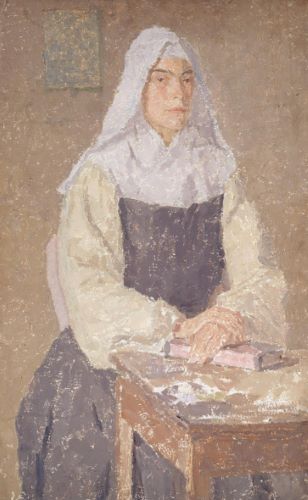
To be against sex in the nineteenth century was not only to challenge gender norms and sexual conventions but to propose a radical reorganization of society as nineteenth-century Americans knew it. Heterosexual sex was a linchpin of marriage, and by extension a linchpin of the family. Those who questioned the centrality of sex to human existence directly attacked the fundamental social conventions of their time. For Shaker and Catholic celibates, distance from one’s biological family could mean the creation of what gay humorist Armistead Maupin once termed “the logical family”—a community of people with shared values, or a family of choice. Families of choice have long been considered a cornerstone of queer culture. Prior to the legalization of same-sex marriage, these intentional families, networks of friends, lovers, and ex-lovers, were celebrated by queer scholars and activists.
The families of choice found within Shaker villages and Catholic religious communities provide important historical antecedents for understanding families of choice. Scholars within the fields of public policy and sociology have also recently pushed to decenter the nuclear family as the primary unit of study, recognizing that a great portion of our modern lives is spent outside family units, with friends, colleagues, and neighbors. Breaking away from families of origin and remaking them into families of choice were not incidental for Shaker and Catholic men and women, but should be understood as a deeply political act. The alternative structures of Shaker and monastic family life and the intimacies they created without sex built an explicit, nonnormative sexual culture in a society that rigidly presented heterosexual love and family as the only legitimate and legal option. The out-and-proud sexual abstinence of these groups also challenged dichotomies of public and private. Making their celibacy and sexual restraint an explicit aspect of group membership, rather than a privately held belief, allowed these subjects to create alternate institutions and family structures.
Groups that challenged sex and its role within the family sought more equitable gender relations and attacked men’s presumed ownership of women’s bodies. It is also important to note that within these remade and reformed families, abstinence from sex did not mean abstinence from love or affection.
READ ENTIRE ARTICLE AT LAPHAM’S QUARTERLY
Nation of Islam
The Charmer
Louis Farrakhan and the Black Lives Matter protests.
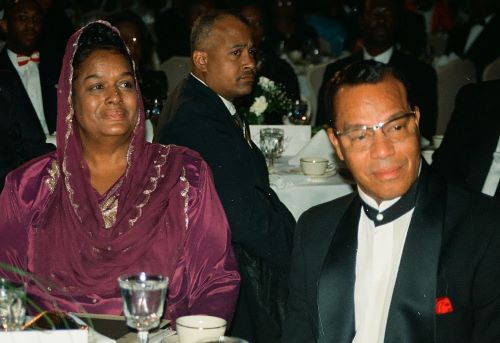
Twenty-one years ago, on the National Mall, Louis Farrakhan rose to speak to the largest gathering of African Americans in history. Flanked by a crowd of young men in navy-blue uniforms, Farrakhan looked out at the Million Man March, a sea of black humanity that stretched from the Capitol to the Washington Monument. The people had gathered at a time of profound suffering for black America. The fire of the civil-rights movement had burned out; the hope and progress of the 1960s had turned to cynicism and regression. The march had been conceived as part of the great legacy of black protest against injustice. And yet, curiously, when Farrakhan addressed the crowd, he spoke of atonement: that October day, he suggested, was a day to ask forgiveness.
Even now, estimates of the event’s attendance inspire considerable controversy, with figures ranging from 400,000 to more than 800,000. There is little question, however, that in both its origins and its scope, the march was unprecedented in the United States. As the late historian Manning Marable points out in Black Leadership, the 1963 March on Washington, which featured Martin Luther King Jr.’s famous “I Have a Dream” speech, was a coordinated effort in support of civil-rights legislation, and its planning intimately involved the Kennedy Administration. The Million Man March sought no such approval from white leaders. It was organized, after all, in part by the Nation of Islam (N.O.I.), which was led by Farrakhan, who had come to believe that racial reconciliation offered no hope for black Americans. The march was meant to prompt a look inward by black men. (And only black men; as Angela Davis complained at the time, the exclusion of women implied by the event’s title was neither coincidental nor casual.) Farrakhan called on his audience to interrogate their own lives, to stop seeking salvation in white America. With its bootstrapping mentality and narrative of deliverance through personal resolve, the Million Man March appears today to occupy a strange ideological space: part G.O.P. convention, part Black Panther rally.
Some have blamed the march’s conservative, self-criticizing impulse for its failure to develop into a durable black political movement. Adolph Reed, a political scientist and labor activist, has said that the march was “the first protest in history where people gathered ostensibly to protest themselves.” Marable notes that black turnout spiked in the elections immediately following the gathering, but no enduring protest movement developed in the streets of Washington that day; no major third party was organized; no new dedication to unions, or to community activism, or to fusions of religion and politics was born. In a world of entrenched racism, real, lasting victory was too much to ask of any individual protest. Even those impressed by the march, however, recognized its political moment as fleeting.
READ ENTIRE ARTICLE AT HARPER’S
The Nation of Islam’s Role in U.S. Prisons
The Nation of Islam is controversial. Its practical purposes for incarcerated people transcend both politics and religion.
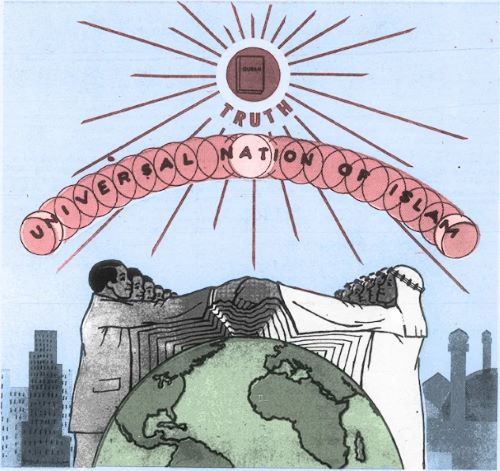
Howard Ayers, a member of the Nation of Islam, grew up in Bedford-Stuyvesant, Brooklyn. In 1993 he was sentenced to 25-years-to-life in prison. Between 1968 and 1993 the prison population of the United States grew by 400%. Lawyer Thomas B. Marvell attributes this increase to legislators, who in response to rising fears, “established longer sentences or mandatory minimum sentences for wide varieties of crimes and criminals.” The ‘tough-on-crime’ ideology that emerged received broad bipartisan support, lending the way to President Bill Clinton’s ‘Three-Strikes Bill’, which mandated life imprisonment without possibility of parole for anyone who had committed a minimum of three violent felonies or, in some states, drug trafficking crimes.
Ayers has been to every maximum-security prison in New York State, including Attica Correctional Facility, where in 1994, he joined the Muhammad Prison Mosques, an iteration of the Nation inside prisons. In 1971, Attica was the site of one of the largest prison uprisings in history. In the interim years, it has been notorious for totalitarian-like surveillance of the people incarcerated within it. So perhaps it’s not surprising that Ayers found himself punished for his affiliation with NoI, which has been associated with radicalism, especially in prisons.
The Nation of Islam intertwined religion with politics long before the famed Attica Uprising. In 1963, for the first time, New York State prisons’ population was majority Black. In 1964, a landmark supreme court case Cooper v. Pate ruled that prison authorities must give equal treatment to imprisoned practitioners of different faiths; in other words, a Black man has a right to practice his Islamic faith in prison. As the prisoners’ rights movement expanded in the 1970s, broader racial and political tensions spilled into the nation’s jails and prisons. In a Journal of Black Studies article, Christopher E. Smith quotes C. Eric Lincoln’s characterization of the Black Muslim movement as “a dynamic social protest that moves upon a religious vehicle.”
What Do the Nation of Islam and Marjorie Taylor Greene Have in Common?
Stuart compares the shared values of Christian nationalists and the Nation of Islam in the 1960’s and today.
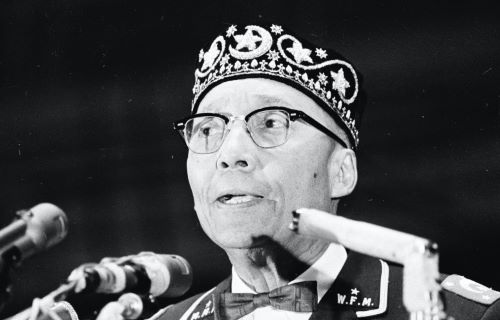
Last November, Republican Rep. Marjorie Taylor Greene of Georgia tweeted about the “common ground” shared by the GOP and the Nation of Islam (NOI). It was a surprising pronouncement, given that the far-right politician and social media star has risen to prominence on her Christian nationalist and, at times, anti-Muslim rhetoric. Her personal Twitter account was later permanently suspended over spreading misinformation about Covid. But before that, she had come across the Nation’s newspaper, according to her since-deleted tweets and The Hill newspaper, and some of the NOI’s vaccine skepticism resonated with her own. She noted that she knows a lot of people who don’t trust the government, including the Nation of Islam.
Greene wrote, “I also found out that the Nation of Islam sees the use and benefit of Ivermectin and is very angry that our media, Democrats, and Dr Fauci have attacked the drug and refuse to save people’s lives by not promoting it and shunning the use of it.” (The FDA does not approve or recommend Ivermectin for treating or preventing Covid-19 because its effectiveness has not been proven.) In the same thread, Greene said that while she opposes “radical Islam,” she supported the Nation of Islam’s stance. Knowing that the NOI opposes the vaccines, along with “many Christians,” she called for ensuring religious exemptions from vaccine mandates.
For its part, the Nation of Islam has not publicly responded to Greene’s message. But as of March 2, its online newspaper The Final Call still strongly opposed Covid-19 vaccines. The newspaper has peddled conspiracy theories about the vaccines, comparing them to the Tuskegee medical experiments, while touting the unproven benefits of Ivermectin.
At first glance, it may seem odd that Nation of Islam’s ideas would align with a Christian nationalist like Greene. After all, the NOI is unpologetically pro-Black and combines elements of traditional Islam with Black nationalism. Meanwhile, Christian nationalists believe that Christianity defines the United States’ nationhood and that the government should actively maintain laws that favor Christians and support their teachings. In some corners of the movement, Christian nationalists often define Muslims as un-American (Greene did so last year), and some, like Greene, have aligned themselves with white power movements. The Southern Poverty Law Center has labeled the Nation of Islam a “hate group” for their anti-white theology, antisemitism, and other issues.
READ ENTIRE ARTICLE AT RELIGION & POLITICS
Muhammad Speaks for Freedom, Justice, and Equality
The official newspaper of the Nation of Islam—published from 1960-1975—combined investigative journalism and Black Nationalist views on racial uplift.
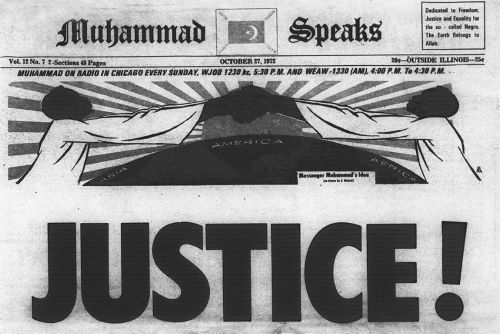
During the late 1960s, Muhammad Speaks was the most widely-circulated Black-operated newspaper in the United States. While it is often associated with the fiery images and ominous messaging of its front covers, it was far more than a sensationalist tabloid. Its combination of community-oriented investigative journalism and Black Nationalist views on racial uplift made it a distinct voice in Black communities for news and commentary. It served as an important source of information for civic leaders, and grassroots organizers, like CORE and the NAACP, as well as those surveilling Black communities such as the FBI and the Ku Klux Klan.
In 1960, the National Minister of the Nation of Islam, Malcolm X, published the first edition of a Harlem-Based newspaper titled Mr. Muhammad Speaks. It was a tabloid-sized city paper dubbed a “militant monthly dedicated to Justice for the Black Man.” Malcolm X enlisted professional Black writers and journalists to gather news, write stories, and edit galley proofs. The paper printed the teachings of the Honorable Elijah Muhammad, the leader of the Nation of Islam, and covered major racial justice issues of the day, with an eye towards both domestic and international struggles against racism and colonialism.
In 1961, the paper moved to Chicago, shortened its name to Muhammad Speaks and began national circulation, as a weekly paper, with a larger staff of writers, editors, and illustrators. The paper stood out for its colorful language, striking illustrations, as well as its layout and quality of writing about Black communities. Male members of the Nation of Islam hawked the paper on bustling urban street corners, calling Black passersby to “come back to your own” and “read Muhammad Speaks.”
READ ENTIRE ARTICLE AT JSTOR DAILY
A Malcolm for Our Times
“The Dead are Arising” may be the best Malcolm X biography yet. But its author seems unsure of how to write about a religion outside the American mainstream.
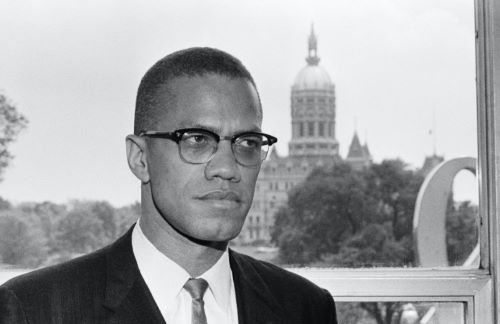
Since the global protests for Black Lives Matter gained momentum last summer, activists have continued to gather to protest police and state violence against Black people. At rallies all over the country and world, there have been signs with quotations and faces of civil rights leaders, including that of Malcolm X. The late leader and his insistence to defend Black lives—“by any means necessary”—received critiques in his own lifetime that echo today through critics of the Black Lives Matter movement: that he was too radical, did not give proper deference to authority, and that he was not the “right” kind of religious leader to champion these social justice movements.
Into this climate came the release of The Dead are Arising: The Life of Malcolm X, written by the late journalist Les Payne and his daughter Tamara Payne, which quickly appeared on award lists and won the 2020 National Book Award for Nonfiction. It also received deserved praise from the African American Intellectual History Society’s authors, who named it one of the twenty best books on African American history published in 2020. Based upon hundreds of interviews conducted by Les Payne and finished after his 2018 death by his daughter, Tamara, The Dead are Arising may be the best Malcolm X biography yet. It represents an outstanding contribution to American history, Malcolm X’s biographies, and the history of Black freedom movements. Previous biographical treatments have placed Malcolm X within broader American religious structures—such as Louis DeCaro’s On the Side of My People—or within the transnational Black American radical milieu in the mid-twentieth century—most notably Manning Marable’s Malcolm X: A Life of Reinvention. Payne, a journalist rather than an academic historian, concerns himself more with who Malcolm was and how that affected his relationship to the Black freedom movements. The Dead are Arising is the most complete look at Malcolm X’s personality and family relationships out of any other biography—a compassionate, riveting examination of one of the twentieth-century’s greatest revolutionary thinkers.
However, even as The Dead are Arising succeeds at portraying Malcolm as he adapted to survive through various periods of his life, Payne’s account struggles to capture the Nation of Islam’s place in Minister Malcolm’s life and politics. In its pages, Malcolm is not the “right” kind of religious until he leaves the Nation of Islam for Sunni Islam. For instance, in rightly describing why scholars must be skeptical of Malcolm’s Autobiography as a pristine source, Payne also describes the book as being “as jolting as that of a cult member undergoing the early shocks of deprogramming.” Payne uses terms like “cult” and “mystic” throughout his book to describe the Nation of Islam and its leader, Elijah Muhammad. These terms question the Nation of Islam’s legitimacy as a religious movement worthy of serious inquiry. Casting aspersions on whether the Nation of Islam is a religion—or merely a “cult” brainwashing its followers—undercuts Malcolm’s motivations and the actions he undertook for the organization for more than a decade. It also separates Malcolm’s thought process and intellectual maturity away from the Nation of Islam, the organization that made him an international spokesman for Black liberation.
READ ENTIRE ARTICLE AT RELIGION & POLITICS
The Legacy of Malcolm X
Malcolm X died fifty-one years ago today, just as he was moving toward revolutionary ideas that challenged oppression in all its forms.
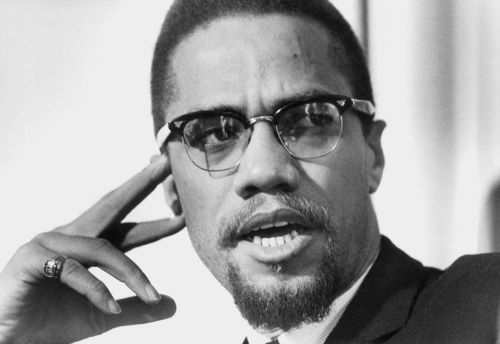
Racial segregation was not the law in the postwar North, but it was the reality. In virtually all aspects of life, Northern blacks encountered racism and segregation. Blacks who left the South found themselves forced to live in huge urban ghettos and educate their children in inferior schools. Skilled or professional jobs were reserved for whites. Blacks were constantly subject to white authority, especially police harassment.
Almost a quarter of blacks said they had been mistreated by the police, and 40 percent said they had seen others abused. Any illusions held by Southern blacks about the liberal North were not held by those already living there. And while Northern blacks were inspired by the struggles in the South, their conditions made them receptive to a movement independent of — and quite different from — the one led by Martin Luther King Jr’s Southern Christian Leadership Council.
In the first years of the civil rights struggle, the most significant organizational expression of this new movement was the Nation of Islam. By the late 1950s, the group’s membership reached an estimated one hundred thousand, with Malcolm X as its most prominent member.
In formal terms, the ideas of the Nation of Islam were profoundly conservative. The organization combined elements of orthodox Islam with ideas of its own making, preaching a doctrine of hard work, thrift, obedience, and humility. Seeing economic independence from white society as crucial, the organization also encouraged its members to “buy black.” The Nation of Islam established dozens of businesses, owned farmland, and built mosques in most major Northern cities. The organization did not condemn capitalism, only whites. Indeed, many Black Muslims looked to emulate the success of white capitalists.
READ ENTIRE ARTICLE AT JACOBIN
Malcolm’s Ministry
At the end of his remarkable, improbable life, Malcolm X was on the cusp of a reinvention that might have been even more significant than his conversion.
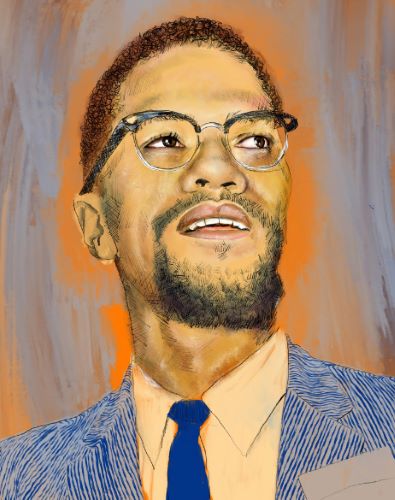
At the end of his remarkable, improbable life, Malcolm X was on the cusp of a reinvention that might have been even more significant than his conversion in prison from criminal predation to religious piety. Although he rose to prominence preaching the bleak, racialist metaphysics of Elijah Muhammad and the Nation of Islam (NOI), which depicted whites as “devils by nature,” in March 1964 Malcolm defected from the Nation and converted to Sunni Islam. Charging Muhammad with the sexual exploitation of his teenage secretaries, and the NOI with corruption, criminality, and idolatry, Malcolm pushed a dangerous feud toward its deadly conclusion.
As assassins from the NOI closed in, the NYPD and FBI infiltrated both Muhammad’s group and Malcolm’s nascent Organization of Afro-American Unity (OAAU) with undercover police and paid informants, seeking to exacerbate sectarian hostilities. Meanwhile, Malcolm traveled frenetically around the globe, making the hajj to Mecca as part of his conversion and conducting subversive diplomacy on behalf of oppressed African-Americans, pleading for newly decolonized nations to bring charges in the United Nations for the United States’ systemic abuse of their human rights. While navigating the ire and surveillance of CIA operatives, Malcolm tried, speech by speech, to cobble together a political philosophy for Black militantsout of revolutionary Black nationalism, Pan-Africanism, anti-imperialism, and a populist critique of Black elites. Manning Marable, whose Malcolm X: A Life of Reinvention (2011) won the Pulitzer Prize for history, lamented that Malcolm’s murder in February 1965 prevented his full evolution toward a “gentle humanism and antiracism” that “could have become a platform for a new kind of radical, global ethnic politics.”
This sense of the assassination as a collective tragedy, of an entire culture haunted by a road not taken, was a vital spur to the Black Arts and Black Power movements of the 1960s and 1970s. For poets like Margaret Walker, Amiri Baraka, Sonia Sanchez, and E. Ethelbert Miller, writing elegies to Malcolm bordered on liturgical practice, granting the martyred hero a blinding countercultural sheen that obscured his suffocatingly conservative views on sex, gender roles, and personal comportment.
READ ENTIRE ARTICLE AT THE NEW YORK REVIEW
Why Tamika Mallory Won’t Condemn Farrakhan
To those outside the black community, the Nation of Islam’s persistent appeal, despite its bigotry, can seem incomprehensible.
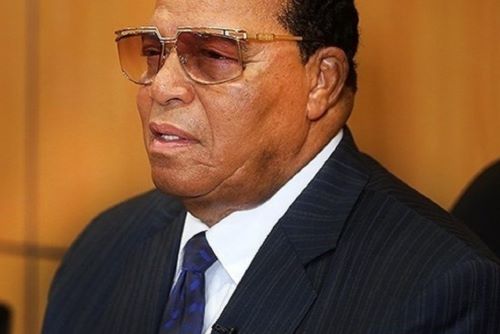
Most people outside the black community come into contact with the Nation of Islam this way—Farrakhan makes anti-Semitic remarks, which generate press coverage, and then demands for condemnation. But many black people come into contact with the Nation of Islam as a force in impoverished black communities—not simply as a champion of the black poor or working class, but of the black underclass: black people, especially men, who have been written off or abandoned by white society. They’ve seen the Fruit of Islam patrol rough neighborhoods and run off drug dealers, or they have a family member who went to prison and came out reformed, preaching a kind of pride, self-sufficiency, and entrepreneurship that, with a few adjustments, wouldn’t sound out of place coming from a conservative Republican. The self-respect, inner strength, and self-reliance reflected in the polished image of the men in suits and bow ties can be a powerful sight.“Even before Farrakhan, the Nation was the first group to really go into the prisons to rehabilitate, or to call incarcerated men and women towards a kind of rehabilitative lifestyle,” said Zain Abdullah, a professor at Temple University who used to teach Islam to people in prison. “They command some respect because of their visibility and presence in lower-class communities. People don’t see them selling out to corporate America, selling out to government. I think people see them as a grassroots organization. They still speak to the poor, to racial injustices, and that’s where their power lies.”
The Nation of Islam had an estimated 50,000 members as of 2007, far from its heyday in the 1960s. Farrakhan’s inability to grow the Nation’s ranks indicates that sympathy with his critiques of white racism does not necessarily translate into broad affection for the man himself.
“What’s interesting is, why is Farrakhan still relevant to these communities, and why is he still as visible as he is? He still commands 20, 30 thousand people,” Abdullah said. “I think people see the Nation as a voice of dissent. A viable voice of dissent. Leadership in these communities, few are as visible as Farrakhan.”
READ ENTIRE ARTICLE AT THE ATLANTIC
The Religious Right
How Christian Is Christian Nationalism?
Many Americans who advocate it have little interest in religion and an aversion to American culture as it currently exists. What really defines the movement?
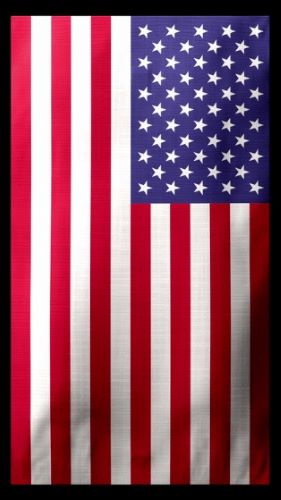
Anyone looking for a charter of American Christian nationalism might begin in 1630, the year John Winthrop, the future governor of the Massachusetts Bay Colony, delivered his speech comparing the settlement to a “city upon a hill,” in “covenant” with God, serving as a beacon to “all people.” (The famous phrase came from Jesus’ Sermon on the Mount: “Ye are the light of the world. A city that is set on a hill cannot be hid.”) In the eighteenth century, arguments for American independence were often cast in religious terms. Congregationalists, who structured their churches around ideals of self-governance and free conscience, were particularly influential: Jonathan Mayhew, a Congregational minister in Boston, published a sermon in 1750 in which he denounced the “tyranny and oppression” of Charles I, the former king. (One of Charles’s transgressions: “He authorized a book in favor of sports upon the Lord’s day”; on this front, anyway, America is indisputably less Christian than it used to be.) And in November, 1777, the Continental Congress issued a message of wartime commemoration and gratitude—it is sometimes considered the first Thanksgiving proclamation—which extolled “the Principles of true Liberty, Virtue, and Piety.” There is a certain tension, of course, between the principle of liberty and that of piety: in 1791, the First Amendment to the Constitution prohibited the “establishment of religion” by the new federal government, but Massachusetts did not officially break with the Congregational Church until 1833.
Then, as now, Christian identity in America was often tribal—which is to say, anti-tribal. In a fascinating book called “Heathen,” the religious historian Kathryn Gin Lum suggests that, in many times and places, the divide between Christian and “heathen” was the central divide in American life. The original British colonies were sometimes taken to be efforts to promote the “propagation of the Gospel of Jesus Christ amongst those poor heathen,” as a 1649 act of Parliament declared. The term could justify both exclusion and engagement: the scourge of heathenism was later adduced as a reason to oppose Chinese immigration to California, and to support the annexation of the Hawaiian Islands. But “heathen” is an unstable identity, because it denotes a condition that ought to be cured. A heathen is someone who has not yet been exposed to and converted to Christianity.
Africans and their descendants were sometimes held to be heathens of a peculiar sort, because they were considered to be both a Biblical people and a cursed one: descendants of Canaan, the son of Ham and grandson of Noah. In the Bible, Ham has an ambiguous encounter with a drunk and naked Noah, and is punished with a generational affliction: “Cursed be Canaan; A servant of servants shall he be unto his brethren.” Frederick Douglass, in his autobiography, described this view of Africans as a perversion of the Bible. He wrote that he abhorred what he called “the religion of the South,” but also that he cherished “the pure, peaceable, and impartial Christianity of Christ.” He was making a version of an argument that appears throughout American history: that this country is not truly Christian enough.
READ ENTIRE ARTICLE AT THE NEW YORKER
Christian Nationalism Is Surging. It Wasn’t Inevitable.
How the decline of liberal religion transformed American Christianity — and politics.
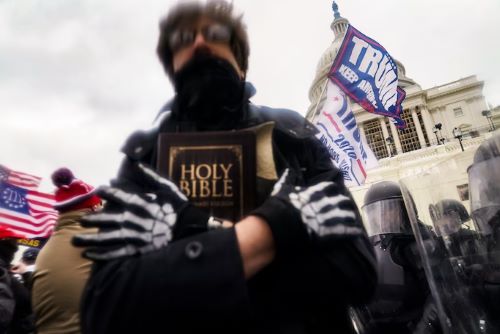
Standing behind the rostrum of the House chamber on Jan. 6, 2021, Jacob Chansley, one of the now-convicted protesters who stormed the Capitol that day, began to pray. “Thank you, Heavenly Father, for being the inspiration needed to these police officers to allow us into the building, to allow us to exercise our rights, to allow us to send a message to all the tyrants, the communists and the globalists that this is our nation, not theirs.”
Chansley’s prayer was part of a troubling chorus of Christian nationalism heard during the insurrection that day. From White House insider Paula White to pastors storming the Capitol, calls rang out for God’s help in returning the nation to its rightful owners: White, conservative Christians.
This Christian nationalism is guided by the fervent belief that the United States was founded by and for Christians and that its borders are sacred. A fear of sinister forces beyond America’s shores also propels Christian nationalism. These ideas are as old as the United States but Christian nationalism wasn’t always a major force in politics. And its rise is as much about the stumbles of its opponents in the period before the Religious Right began to dominate American politics in the 1970s as the success of those promoting this ideology.
READ ENTIRE ARTICLE AT THE WASHINGTON POST
How Pat Robertson Shepherded His Flock into Politics
Farewell to the senator’s son who pioneered a TV genre, helped create the Christian right, ran for president, and earned the grudging respect of Abbie Hoffman.
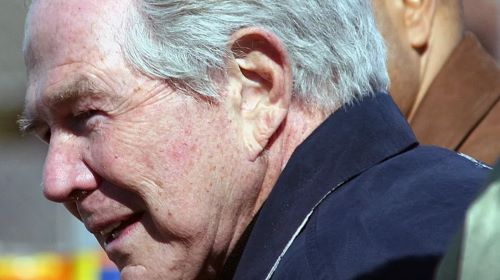
Marion “Pat” Robertson, one of the fathers of the modern religious right, has died at age 93. The televangelist was linked to the Republican Party for so long that many people are surprised to hear that the first presidential candidate he went out of his way to boost was Jimmy Carter.* But Robertson voted for Carter in the 1976 Democratic primary—the man was, after all, the born-again Christian in the race—and shortly before Election Day he traveled to Georgia to interview the candidate for his TV show, The 700 Club.
Yet the marriage showed signs of trouble from the start. Like a lot of Christian conservatives, Robertson was put off by Carter’s decision to give an interview to Playboy (and by Carter’s comment in that conversation that he had “committed adultery in my heart many times”). Some of Carter’s foreign policy views were too dovish for Robertson too, though it took a while for that to become fully clear. And then there was the letter the evangelist sent the incoming president once the voting was over. After the ballots were counted, historian Rick Perlstein writes in his 2020 book Reaganland, Robertson pored through the “Plum Book,” the fat volume that listed federal jobs, in order to prepare a memo recommending some thirty-five “good Christians” for specific appointments. He dispatched a private plane to the president’s hometown in Georgia to have it hand-delivered, along with his candidates’ résumés, background-check information, and a cover letter reminding the president-elect that the American population of fifty million evangelicals had been “highly supportive” of his campaign, and pledging to “marshal this enormous reservoir of prayer and goodwill on your behalf” and to defend the president concerning “unpopular programs which are truly needed for the good of our country” but which his flock might otherwise oppose. Robertson did not get back so much as a thank-you note.
“We were talking to him, recommending people for his cabinet, and it turned out that his hands were tied,” Robertson later told biographer David John Marley. “He was under the control of the Council on Foreign Relations and the Trilateral Commission.”
When the next election rolled around in 1980, Robertson backed Carter’s Republican opponent, Ronald Reagan. And while Reagan found ways to disappoint him in office too, Robertson stayed loyal, fending off suggestions that he run against the president in 1984. The Christian right was now firmly planted in the GOP.
What Everyone Gets Wrong about Evangelicals and Abortion
Evangelicals started speaking out against legal abortion long before the late 1970s.
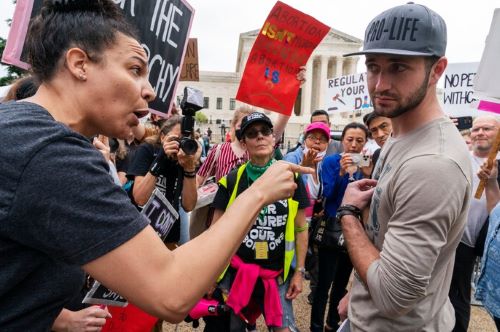
In the wake of Justice Samuel A. Alito Jr.’s leaked draft Supreme Court opinion that would overturn Roe v. Wade, a familiar narrative has emerged. The story goes like this: White evangelicals didn’t care much about abortion until the late 1970s. Around that time, two prominent leaders of the soon-to-be-named “Religious Right,” Paul Weyrich and Jerry Falwell, concluded that overtly racist politics would harm, not help, their quest for political power. They turned to abortion as a convenient wedge issue in the 1978 midterm elections to drive evangelicals to the polls and distract from the “real” motivations of the far right: stopping racial integration and preserving the tax-exempt status of segregationist Christian schools.
But this oversimplified narrative about abortion reduces the rise of the religious right to the cynical calculations of elite movement leaders — rather than to the actions of thousands of grass-roots activists, religious leaders and conservative thinkers who spent nearly two decades building the networks and ideas that brought about the religious right. It also disentangles abortion from a web of interconnected issues from the 1960s and ’70s, including opposition to the proposed Equal Rights Amendment (ERA) to the U.S. Constitution, school prayer, school integration, changing attitudes about gender and sexuality and the growing gay rights movement. Those issues were shaped directly and indirectly by racist ideas and attitudes and were part of a broader political realignment that moved White Southern evangelicals and Northern White Catholics from the Democratic Party to the GOP in this period.
Most importantly, this simplified history of abortion ignores the vast and decades-long, Catholic-led antiabortion movement and the coincident politicization of White evangelicals for nearly two decades before the 1978 midterm elections. Understanding this history is vital for making sense of the nearly 60-year interfaith movement that has led to this moment.
READ ENTIRE ARTICLE AT THE WASHINGTON POST
Evangelical Groundhog Day
The NYT identifies the ‘religious fervor in the American right’ — around four decades late.
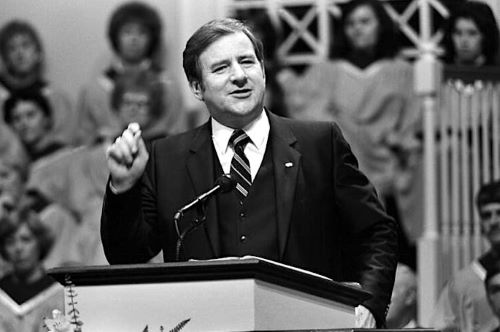
autumn 1980, I was a senior at a Christian college in California taking a course on the history of American evangelicalism. One November day, a fellow student brought a copy of the New York Times to class. With a dramatic flourish, he opened the paper and pointed to a story—“Falwell Warns Jersey Liberals at Capitol Rally”—accompanied by a picture of Baptist preacher Jerry Falwell on the steps of the Trenton State House surrounded by American flags and a church choir.
The story began:
“The Rev. Jerry Falwell, the leader of the Moral Majority movement, brought his mixture of church meeting and political rally to the New Jersey State House steps today. He proclaimed that his church was a ‘sleeping giant’ that was ‘standing again across this nation.’”
That class remains etched in my mind.
California in the late 1970s was a place and time in which a more radical evangelicalism, one refracted through both the Jesus-counterculture and liberation theology, held sway. Most of the students at the college read Sojourners magazine, had our consciousnesses raised by Christian feminism, and listened to evangelical rock-and-roll with lyrics that attacked capitalism and the military industrial complex and bore no resemblance to today’s praise songs. What did my friends and I do when we saw the photo of Jerry Falwell? We laughed. He seemed a buffoon, and we couldn’t believe that anyone would ever take him seriously. We had no idea what lay ahead.
This all came back to me because of another article in the New York Times—a piece published on April 6—“The Growing Religious Fervor in the American Right: ‘This Is a Jesus Movement’”—that begins by describing a crowd at a political rally praying and singing praise songs. “This was not a church service,” intone the authors, “It was worship for a new kind of congregation: a right-wing political movement powered by divine purpose, whose adherents find spiritual sustenance in political action.” They go on to explain:
The infusion of explicitly religious fervor—much of it rooted in the charismatic tradition, which emphasizes the power of the Holy Spirit—into the right-wing movement is changing the atmosphere of events and rallies, many of which feature Christian symbols and rituals, especially praise music.
With spiritual mission driving political ideals, the stakes of any conflict, whether over masks or school curriculums, can feel that much larger, and compromise can be even more difficult to achieve. Political ambitions come to be about defending God, pointing to a desire to build a nation that actively promotes a particular set of Christian beliefs.
READ ENTIRE ARTICLE AT RELIGION DISPATCHES
The U.S. Culture Wars Abroad: Liberal-Evangelical Rivalry and Decolonization in Southern Africa
As evangelicals worked to gain public legitimacy during the Cold War, historians of evangelicalism search for a usable past for their fellow believers.
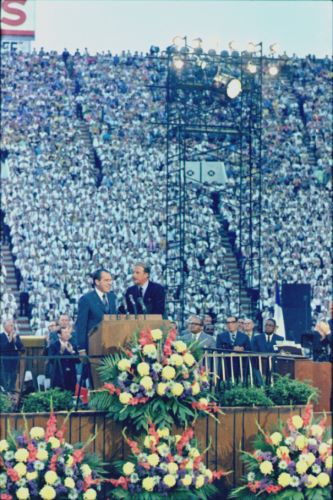
The problem of the archive is a well-worn topic for historians. But sometimes the sheer contingency of the historical record—what we can and cannot learn about the past through documentation—is so glaring that it demands comment. I had this in mind as I came across records of a twenty-something Australian missionary named Ian Grey, who was stopped by the Mozambican border guards in 1987 as he tried to cross over into neighboring Malawi. It had been more than a decade since Mozambican freedom fighters overthrew Portuguese colonialism only to find themselves in a prolonged civil war. The border guards who questioned Grey worked for the Marxist ruling party, Frelimo. As they went through his belongings and thumbed through his diaries, they noticed reference after reference to Renamo, the anti-communist militia fighting the Mozambican government. (The U.S. State Department compared Renamo to the Khmer Rouge and accused it of frequently resorting to rape, mutilation, forced labor, and arbitrary executions). Grey was taken into custody and soon put on trial. His arrest, a result of a young man’s decision to document his ties to the Renamo militia, reverberated some 8,000 miles to the United States and documented a series of relationships that would have otherwise been lost to historians.
Soon after his arrest, Grey confessed to being a Renamo “messenger boy.” He explained to the international press corps that his Pentecostal missionary group brought equipment and supplies to Renamo and smuggled out information, which it quickly relayed to the militia’s allies outside Mozambique. This work for Renamo was performed by an international crew but one supported and heavily subsidized by Americans. Among its benefactors were televangelists Pat Robertson, Jim and Tammy Faye Baker, and countless Pentecostal and evangelical churches from coast to coast.
Had it not been for Ian Grey’s blunder, we may not have known many of the details of evangelicals’ work in Mozambique. Without the historical record created around his trial, we would have a more sanitized version of events. Of course, every historian must reckon with how the figures they study purposefully obscure some of the more unsavory aspects of their past. But the issues posed by the archives are especially acute for the history of American evangelicals.
The modern evangelical movement began in the early 1940s as an attempt to overcome the bad branding of the fundamentalist movement in previous decades, which had become synonymous with reactionary politics, antisemitism, and anti-intellectualism. Figures emerging out of the fundamentalist movement, who began calling themselves evangelicals in the 1940s, engaged in a prolonged and largely successful public relations campaign to bolster their image. In due course, they also reformed their movement.
READ ENTIRE ARTICLE AT PROCESS: A BLOG FOR AMERICAN HISTORY
Evangelical Fear Elected Trump
The history of evangelicalism in America is shot through with fear—but it also contains an alternative.
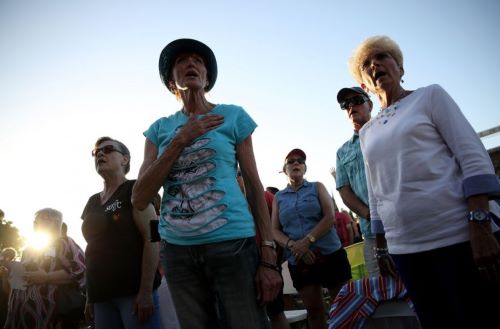
White conservative evangelicals in America are anxious people. I know because I am one.
Our sense of fear, perhaps more than any other factor, explains why evangelicals voted in such large numbers for Donald Trump in 2016 and continue to support his presidency.
The Pulitzer Prize-winning novelist and essayist Marilynne Robinson once wrote, “Fear is not a Christian habit of mind.” The great poet of the Jersey shore, Bruce Springsteen, sings, “Fear’s a dangerous thing, it can turn your heart black, you can trust. It’ll take your God-filled soul and fill it with devils and dust.”
Robinson and Springsteen echo verses in nearly every book of the Bible, the sacred text that serves as the source of spiritual authority in evangelical life. Moses told the Israelites to “Fear not, stand firm, and see the salvation of the Lord, which he will work for you today.” The Hebrew God told Job: “At the destruction and famine you shall laugh, and shall not fear the beasts of the earth.” The Psalmist wrote: “Even though I walk through the valley of the shadow of death, I will fear no evil, for you are with me; your rod and your staff they comfort me.”
The Gospel of John teaches Christians that “there is no fear in love, but perfect love casts out fear.” St. Luke writes: “Fear not, little flock, for it is your Father’s good pleasure to give you the kingdom.”
READ ENTIRE ARTICLE AT THE ATLANTIC
QAnon Didn’t Just Spring Forth from the Void
Calling QAnon a “cult” or “religion” hides how its practices are born of deeply American social and political traditions.
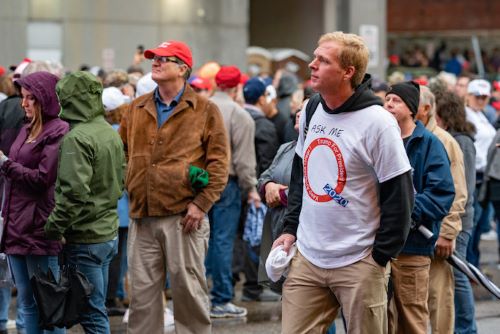
If you’ve been online at any point in the past year—if not, welcome!—your aimless clicks and doomscrolling may have brought you glimpses of the “world” of QAnon: the conspiracy theory that argues that US President Donald Trump is in the midst of a secret war against sex-trafficking, Satan-worshipping pedophiles. Its increasing prominence and power, especially as a worldview dissociated from fact, have compelled many an analyst, journalist, and pundit to festoon their analyses of QAnon in religious language. According to this speculative genre, QAnon is a new American religion, or even a cult. It’s an abusive cabal unlike any other form of belief and practice preceding it.
Enter religious studies scholar Megan Goodwin, co-host of Keeping it 101: A Killjoy’s Introduction to Religion, and author of Abusing Religion: Literary Persecution, Sex Scandals, and American Minority Religions. Fluent in the place of religion in the media, and with a recent book on the religio-political history and power of sex abuse allegations, Goodwin contends that QAnon is far from unprecedented. Goodwin traces the group’s prominence and lineage, as well as its zealous determination to “save the children,” to the rise of the New Christian Right and the Satanic Panic of the 1980s.
Calling QAnon a cult or religion marks the movement for its alterity and supposed irrationality, and hides how its practices are born of American social and political traditions. Its apocalypticism and accusations of pedophilia are but a contemporary symptom of a religiously-inflected political strategy older than Christianity itself. Historical precedents further suggest that the state lacks the tools and incentives to curb the group’s rise.
QAnon certainly holds power as both a political force and a site of projected public scrutiny. The realistic range of political options may seem exasperatingly curtailed, but Goodwin closes by discussing the strategies and extant projects that hope to birth greater solidarity between media professionals and religious studies scholars. These practices may sensitize and historicize the public discourse surrounding—and responses to—QAnon, or whatever comes next.
READ ENTIRE ARTICLE AT RELIGION DISPATCHES
The Capitol Riot Revealed the Darkest Nightmares of White Evangelical America
How 150 years of apocalyptic agitation culminated in an insurrection.
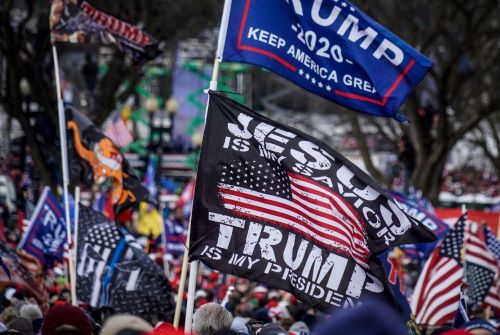
White evangelicals believe they see truths that you and I cannot.
While Americans around the country watched an inflamed mob overrun the Capitol on January 6, the evangelical participants in that mob saw something else: a holy war. Insurgents carried signs that read “Jesus Saves,” “In God We Trust,” “Jesus 2020,” and “Jesus Is My Savior, Trump Is My President.” One man marched through the halls of Congress carrying a Christian flag, another a Bible. They chanted, “The blood of Jesus covering this place.”
As law enforcement authorities and media outlets track down and identify these insurrectionists, we are beginning to understand who they are and what they wanted. Amid the QAnon adherents, antisemites, neo-Confederates, and revolutionary cosplayers were the evangelical faithful: those who see themselves as the vanguard of God’s end-times army. Their exultant participation in the riot represented some of the most extreme political action that any group of evangelicals has taken in recent history.
These Christians apparently believe that they had no choice but to try to overthrow the Congress. For months, various evangelicals have claimed in sermons, on social media, and during protests that malicious forces stole the election, conspired to quash Christian liberties, and aimed to clamp down on their freedom to worship and spread the Christian gospel. They felt sure that the final days of history were at hand and that the Capitol was the site of an epochal battle. As one evangelical from Texas told The New York Times, “We are fighting good versus evil, dark versus light.”
Much has been made about the evangelical community’s relationship to Donald Trump. And typically, observers tend to view this alliance as purely transactional, with nose-holding evangelicals pledging their support to this least Christian of men in order to get something in return—most notably, a trio of religiously conservative Supreme Court justices. This dominant interpretation also treats Trump as the apotheosis of a shape-shifting brand of grievance politics that unites and permeates all factions of the right, very much including the evangelical movement. But what is less understood—and what the Capitol riot revealed in all its gruesome detail—is the extent to which Trump channels the apocalyptic fervor that has long animated many white evangelical Christians in this country.
READ ENTIRE ARTICLE AT THE NEW REPUBLIC
The Summer of Love Ended 50 Years Ago. It Reshaped American Conservatism.
The Jesus People, born on Haight Ashbury, had a profound influence on the Religious Right.

They came to San Francisco seeking something more — something significant, something transcendent. By the summer of 1967, a half-century ago this year, nearly 100,000 hippies and counterculture kids had gathered in the Haight-Ashbury neighborhood to drop acid, indulge in free love, and escape the confining strictures of their middle-class upbringings. They wanted to join the revolution.
Yet the utopia called the Summer of Love wouldn’t last, and, after the movement faded out, not all of them went back to professional career paths. Disillusioned by bad trips and a sense that their pursuit of hedonism had been empty, thousands of burned out hippies soon experienced something possibly even more revolutionary than tuning out and turning on: a born-again religious conversion.
Sex, drugs, and — Jesus? It’s not what the Summer of Love generally calls to mind. But of all the things that came out of San Francisco in 1967, perhaps none was more unexpected, or more consequential, than the Jesus Freaks or, as they were more commonly known, the Jesus People.
While they would give up their drugs and promiscuous sex, the Jesus People retained much of their countercultural ways, bringing their music, dress, and laid-back style into the churches they joined. Their influence would remake the Sunday worship experience for millions of Americans. As the historian Larry Eskridge has argued, today’s evangelical mega-churches with their rock bands blasting praise music and jeans-wearing pastors “are a direct result of the Jesus People movement.”
Why Conservative Evangelicals Have Lined Up for Trump
It’s a match made in heaven.
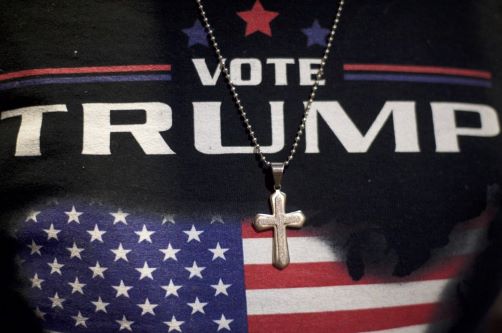
Donald Trump has never been known for displays of Christian humility. The first few minutes of his remarks at the National Prayer Breakfast in February were no exception. He thanked the creator of Celebrity Apprentice and, pronouncing Arnold Schwarzenegger a “total disaster,” asked the audience to pray for the show’s ratings. Trump went on to remind everyone that he is a billionaire, “somebody that has had material success and knows tremendous numbers of people with great material success—the most material success.” Later he acknowledged that his mission to stop terrorism “may not be pretty for a little while,” and promised that his administration would confront threats “viciously, if we have to.” Trump’s signature swagger makes many Christians wince, but it has deterred few white evangelicals. Eighty-one percent of those who voted last year cast their ballot for him.
That figure has become one of the most discussed statistics of the 2016 election. How could so many conservative Christians have voted for a thrice-married casino mogul who has bragged about assaulting women and rarely goes to church? Some commentators have speculated that perhaps these voters weren’t all that “evangelical” to begin with. “Many cultural Christians who never go to church identify as ‘evangelical’ or ‘born-again,’ ” suggested one conservative Christian blogger. A writer in The Nation emphasized evangelicals’ concern about future nominations to the Supreme Court: “If you can rally voters around abortion, few other issues matter.” Other observers credited plain old party loyalty or wondered whether this election proved that religion doesn’t matter very much anymore. So many voters seemed motivated by economic and racial grievances and resentment of Washington elites, not faith.
READ ENTIRE ARTICLE AT THE ATLANTIC
An Evangelical Youth Event Could Offer Clues about the Movement’s Future
TOGETHER ’22 aims to mimic EXPLO ’72 — which provided hints about the rising conservative evangelical tide.
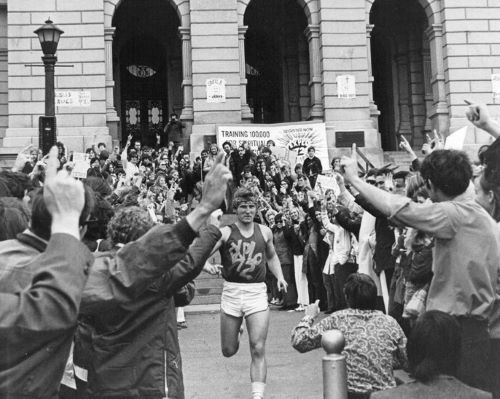
On Friday and Saturday, young evangelicals will gather at the Cotton Bowl in Dallas for TOGETHER ’22. Evangelist Nick Hall, backed by a wide spectrum of parachurch ministries, has organized the two-day conference. The architects of the event hope their jamboree of worship concerts, “breakout sessions” and “evangelism opportunities” will “activate a generation to share Jesus” and return home “with the courage, community and tools to share the Good News.”
Hall’s team is patterning TOGETHER ’22 on a week-long evangelical youth summit from 50 years ago this summer — one that drew an estimated 180,000 people. EXPLO ’72, organized by Bill Bright, founder of the evangelical collegiate ministry Campus Crusade for Christ, filled the only place in Dallas that could contain that many people: a mile-long stretch cleared for an unconstructed freeway north of downtown. Among the attractions: America’s most famous evangelical preacher Billy Graham, country music star Johnny Cash performing hymns and the sanctified rock and soul music of “Jesus People” bands.
EXPLO ’72 wasn’t a mere revival. Instead, it was a generational hinge in the history of modern American evangelicalism. “Godstock,” as Christianity Todaycalled it, signaled the arrival of evangelical baby boomers whose faith didn’t look like their parents’ old-time religion. It served as a harbinger of the future of the evangelical movement, tracing the faint features of a rising era of conservative evangelicalism that would dominate the decades to come. TOGETHER ’22 may well offer similar signals about how Gen Z evangelicals will practice their faith in a nation polarized along political, social and racial lines.
READ ENTIRE ARTICLE AT THE WASHINGTON POST
The War on Christmas
A brief history of the Yuletide in America.

I can’t remember many good political moments in the Trump years, but one thing that did make me happy was when President Trump declared that the “War on Christmas”—that is, the annual American tradition of insisting that there is one—was over, because his side, the side that did the insisting, had won. In December 2016, the president assured an adoring crowd in Salt Lake City that “Christmas is back, bigger and better than ever before,” and a few days later, standing outside the White House, told a weary nation, “We can say Merry Christmas again.” Thank God, I thought. We won’t have to hear about the supposed “War on Christmas” ever again. That was then, but now I’m in despair, because while campaigning this past October, President Trump told supporters that if Biden “comes in, … the Christmas season will be canceled.” We now know that the Christmas season was not canceled, but the belief that it will be will surely be resurrected.
I make that claim with certainty because the fake “War on Christmas” has been around for a long time, and it serves a particular white Christian nationalist purpose. The “war” was begun in the 1920s by notorious anti-Semite Henry Ford, who reacted angrily when Jewish organizations had the temerity to ask that the Establishment Clause of the U.S. Constitution be enforced, thereby disallowing Bible readings and Christmas pageants in public schools, a common practice at the time. The centripetal forces of the Depression and World War II silenced the conflict for a generation, but the war recommenced in the 1950s when the John Birch Society accused communists (and the United Nations) of conspiring to secularize Christmas for the purpose of socializing America. More recently, in 2004, Fox News’s Bill O’Reilly declared that Christmas was under threat and rallied his troops every Yuletide, right up through President Trump’s December 2016 declaration of victory.
Mission accomplished?
No, for the grievance that has fueled the supposed War on Christmas is still very much present. Indeed, for white Christian nationalists, the conflict speaks to the fear that their hold on American society is slipping, whether to Jews, communists, Blacks, Hispanics, secular liberals, or any other group that strives for the cultural equality of all Americans, regardless of ethnicity or creed. Put another way, the War on Christmas is a struggle over two very different visions of America’s past, present, but mostly future. On the one side is a white Christian nation, with minority groups playing bit parts, if they must; on the other is a nation that, for now, happens to be mostly white and Christian, with other groups rapidly growing in size and influence.
READ ENTIRE ARTICLE AT THE AMERICAN SCHOLAR
Collected and curated by Bunk History
